
Text © Prof. Angelo Messina

English translation by Mario Beltramini
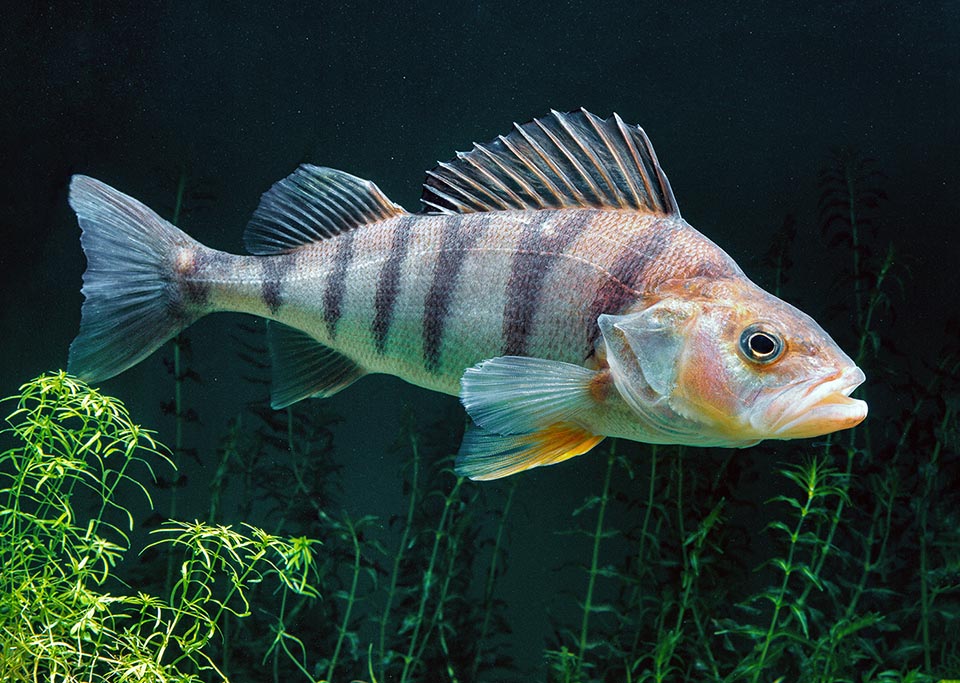
Perca fluviatilis has the typical look, adapted to environment, of most fishes: slender body, taller and broader in front, low and compressed towards tail © Giuseppe Mazza
For a long time the term fish, from the Latin “piscis”, has been considered a synonym of aquatic animal and until the fifteenth century several naturalists included among the Fishes not only the mammals and the reptiles that display habits more or less associated with that environment, such as dolphins, whales, seals, crocodiles, hippopotamuses, etc., but also several invertebrates, like crustaceans, mollusks, annelids, sea urchins and starfish, and others.
Even in times closer to us, several zoologists have continued including in the Fishes also the Cetaceans and the Amphibians and still in the middle of the nineteenth century Fishes, Amphibians and Reptiles were still ascribed to one single class.
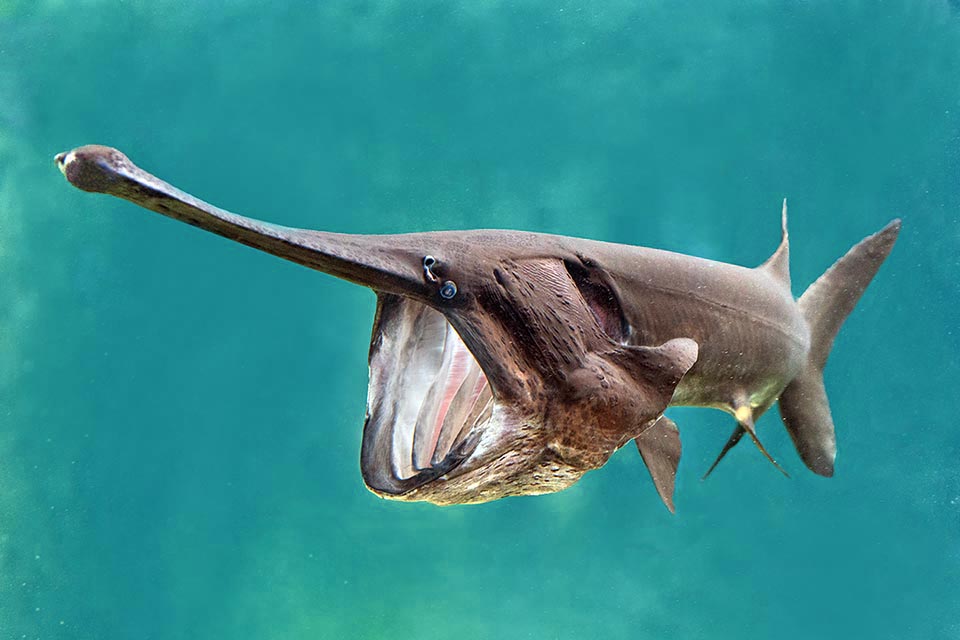
However, there are notable exceptions. The Mississippi paddlefish (Polyodon spathula) has for instance a spatula snout, particularly elongated © Giuseppe Mazza
Distinctive characters
Nowadays the name of Fishes, although it is till employed to indicate more generally the most diverse vertebrates and invertebrates of aquatic habits, from a systematic point of view has the value of a superclass gathering all vertebrates, that is animals equipped with a bony and/or cartilaginous structure that, besides being characterized by the adaptation to the aquatic life, are also heterothermic, i.e. in which the temperature of the body varies with that of the outer environment (cold-blooded), breathe essentially through gills also in the adults and have fin-shaped limbs, as structures of locomotion in water (pteridiates).
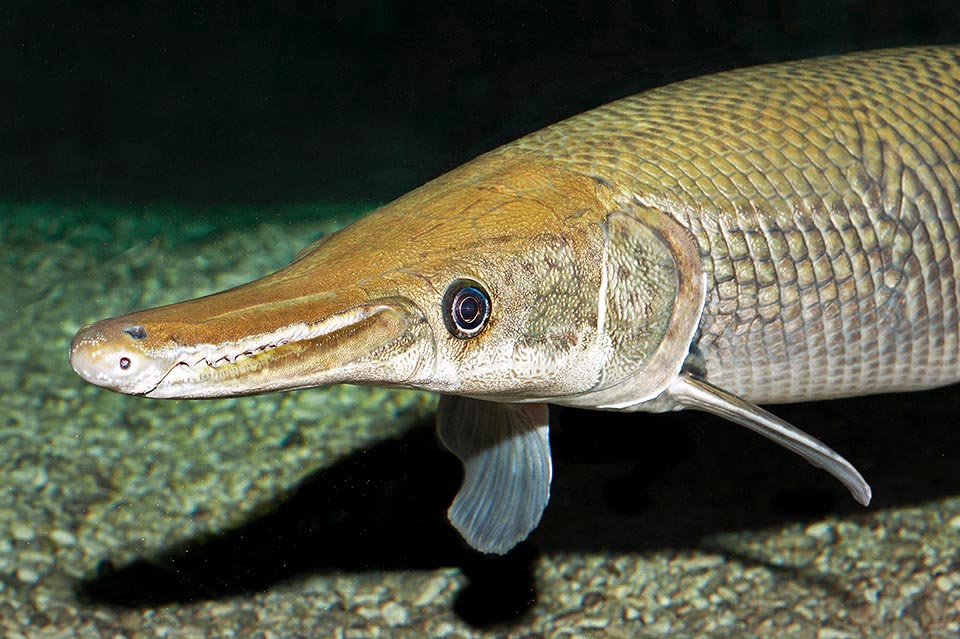
In Atractosteus spatula, also North American freshwater, the spatula transforms, as the English name suggests, in the fierce snout of an alligator © Giuseppe Mazza
And again, the superclass of the Pisces includes animals provided with jaws (gnathostomes) and with two nostrils (amphyrrhines); it should be noted that the Cyclostomata, although equally eterothermal and aquatic, are agnates, with only one nostril (monorrhine) and do not have limbs, and therefore are ascribed to a superclass distinct from that of the Fishes.
In relation to the life in an aquatic, marine or freshwater, environment, in the vastest majority, the Fishes display a generally slender body, higher and enlarged at the front, low and compressed on the back; such fom is greatly hydrodynamic thus to facilitate the sliding into the water with the minimum waste of energy.
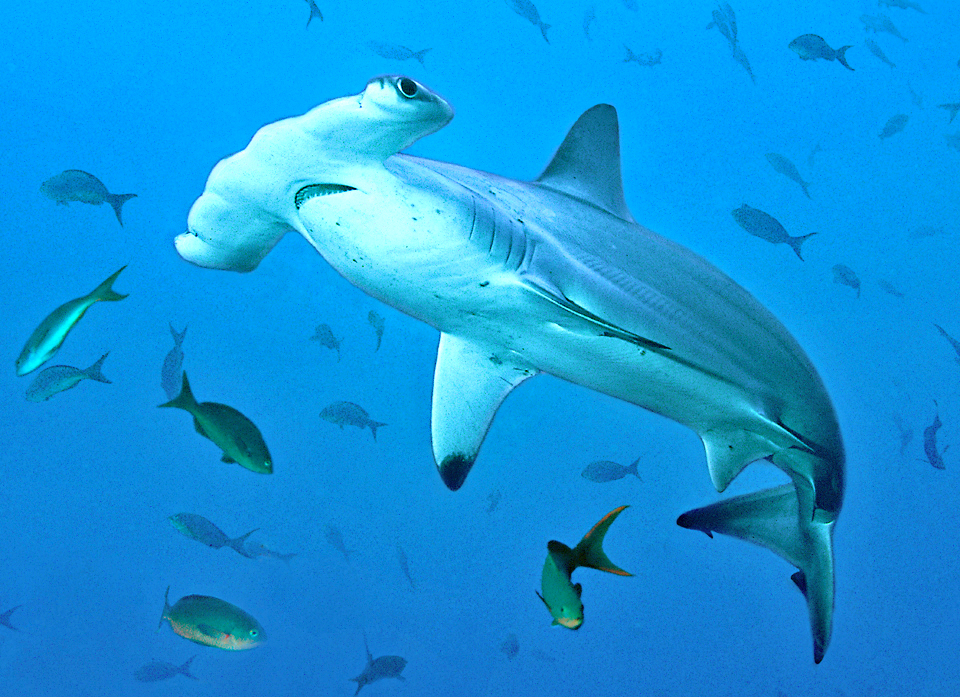
In the hammerheads, like Sphyrna lewini, the eyes stand at the apex of two lateral extensions of the head, for a perfect global vision and for better evaluation of distances © Richard Merritt
Normally, the head is sub-conical with the tip facing forward and is united directly with the trunk on which is not mobile; frequently affected, however, by modifications of various grade, at times even very showy, as is the case of the Mississippi paddlefish (Polyodon spathula, Walbaum in Artedi 1792) who owes its common and scientific name to its characteristic snout, enormously elongated and shaped like a spatula, in the Swordfish (Xiphias gladius Linnaeus, 1758 ) where the upper jaw is particularly developed and shaped like a typical “sword”, flattened and sharp and about 1/3 of the body long; and again, the Hammerhead fishes Sphyrna lewini (Griffith & Smith, 1834), with their characteristic head laterally expanded in shape of a T with the eyes placed on the apex of the two lateral extensions, the Seahorse (Hippocampus guttatus Cuvier, 1829) where the head has a long and tubular snout and gets a decidedly equine appearance and in other fishes more.
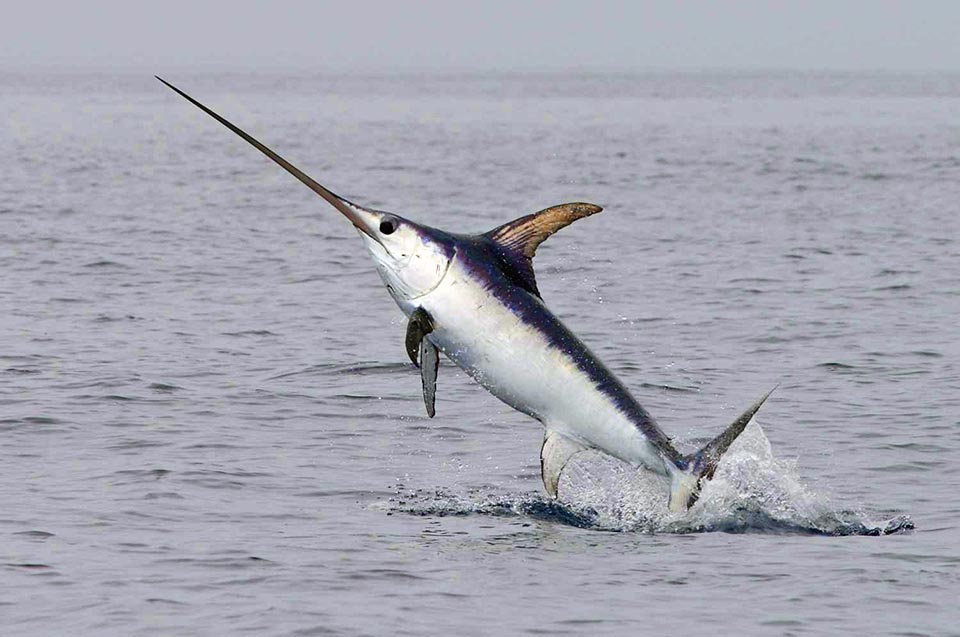
In the Swordfish (Xiphias gladius) the upper jaw is very developed and forms a typical “sword”, flattened and sharp, about 1/3 of the body long © Pierre Jaquet
Typically, the body narrows on the back to form a caudal peduncle, more or less distinctly defined and at times very thinned.
In many species, however, in relation to particular ways of life, the body is variously shaped: serpentiform in the benthic fishes moving quickly like in the Eel (Anguilla)and in the Conger (Conger), or filiform, like in the Slender snipe eel (Nemichthys scolopaceus Richardson, 1848).
Otherwise the body is flattened in the fishes moving more slowly such as various species of the orders of the Rajiformes, Pleuronectiformes, and more.
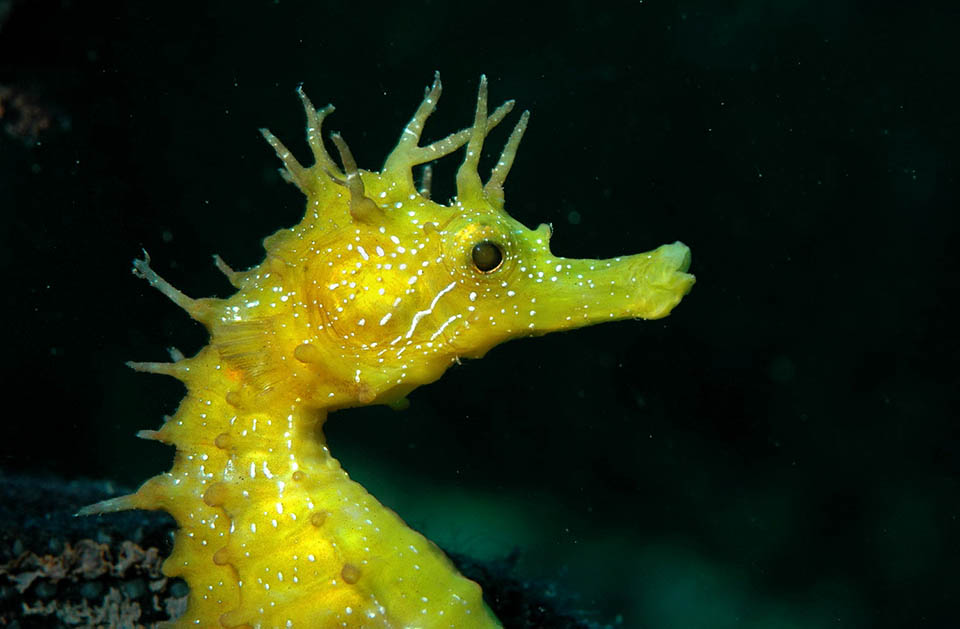
In Hippocampus guttulatus the mane-like lumps and the tubular elongated snout of the head here evoke an unusual equine appearance © Nicolas Laissus
Generally the forms loving to stay motionless among the weeds, like the Pipefish (Syngnathus) of the family of the Syngnatidae, have the body typically needle-shaped, whilst the species having a very limited mobility, like the so called Pufferfish, membres of the family of the Tetraodontidae, are characterized by a globular shape.
And more, some fishes have a disc-shaped body, like the members of the family of the Molidae or vaguely rhomboidal. like in that of the Monacanthids, others nastriform such as the Giant oarfish (Regalecus glesne Ascanius, 1772) of the family of the Regalecidae, or depressed as in many species of the order of the Lophiiformes, or compressed as in those of the order of the Pleuronectiformes.
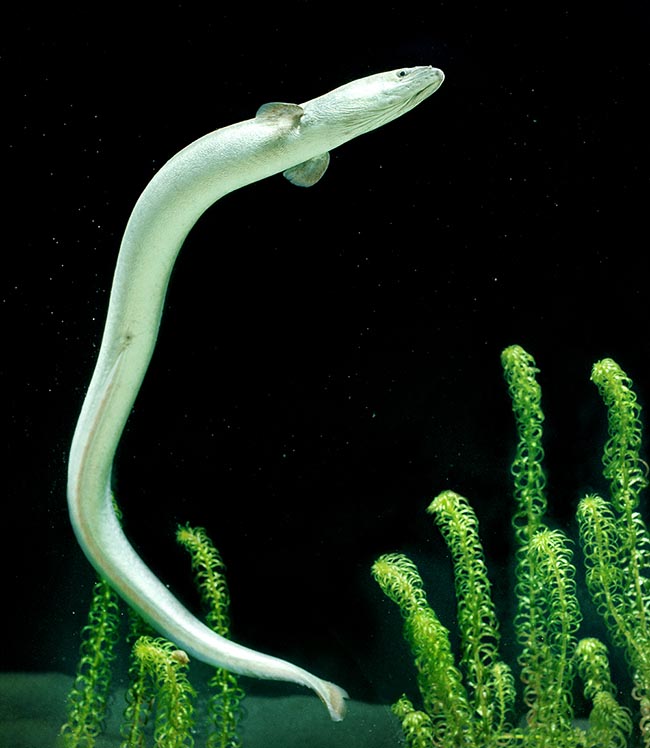
Also the body has adapted and is serpentiform in some fast swimming benthic fishes like Anguilla anguilla © Giuseppe Mazza
Homotypy and homochromy
In the Fishes frequent are the cases of homotypy, where the body gets a look that well confuses it with the surrounding environment; about this, one of the most representative examples is that of the Amazon leaffish (Monocirrhus polyacanthu Heckel, 1840), small member of the order of the Perciformes who lives in the hydrographic basin of the Amazon River, whose body perfectly simulates in shape and colour a fallen leaf with its petiole; actually this is formed by a short fleshy barbel implanting on the jaw.
Between the other numerous examples of more or less marked homotypy, almost always associated with homochromy, that is camouflage colouring with the environment, are to be mentioned the so-called Stonefishes (Synanceia verrucosa Block and Schneider, 1801) of the order of the Scorpaeniformes, fishes standing among the most poisonous fishes in the Indian Ocean and in the West Pacific, whose appearance imitates a stone very well; and, more, the species of Phyllopteryx taeniolatus (Lacepède, 1804) and Phycodurus eques (Lacepède, 1804) genera of the order of the Syngnathiformes whose members have the body decorated with lobed and aculeate appendages that renders them quite similar to floating seaweeds.
Dimensions
The dimensions of the fishes are extremely variable, from about ten millimetres up to more than ten metres. Among the smallest species are to be mentioned the Mistichthys luzonensis (His Majesty Smith 1902), Philippines Gobiiformes that reaches the length of 11 mm, and the species of the genus Schindleria (Giltay, 1934), Perciformes whose average dimensions are around 12 mm.
In contrast with these tiny specimens, exist giant forms, like the Giant manta ray, Mobula birostris (Walbaum, 1792), that is on average 4 m long and 7 m broad, the already mentioned Giant oarfish that may even reach the length of 7 metres and the Basking shark (Cetorhinus maximus Gunnerus, 1765), that may measure even 14 m and the Whale shark (Rhincodon typus Smith, 1828) who, with a maximum length of 18-20 m, is the giant among the present fishes.
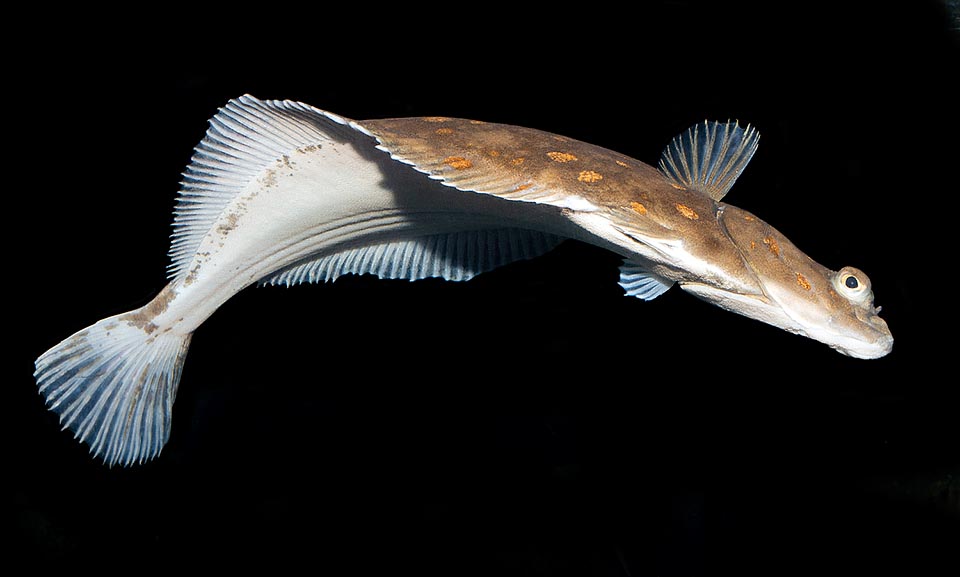
In others it has flattened, as in Pleuronectes platessa, and the eyes have moved to the side not touching the bottom © Giuseppe Mazza
In this regard it should be remembered that until not too long ago in the waters of the Caspian Sea lived Sturgeons (Acipenser sturio Linnaeus, 1758) measuring even 9 metres and weighing even 1500 kg.
Mouth
In the fishes the mouth usually opens at the apex of the snout, but in several species it may be placed in a more or less ventral position, as in almost all cartilaginous fishes (Chondrichthyes), or dorsally displaced, like in some Salmoniformes, order of bony fishes (Osteichthyes).
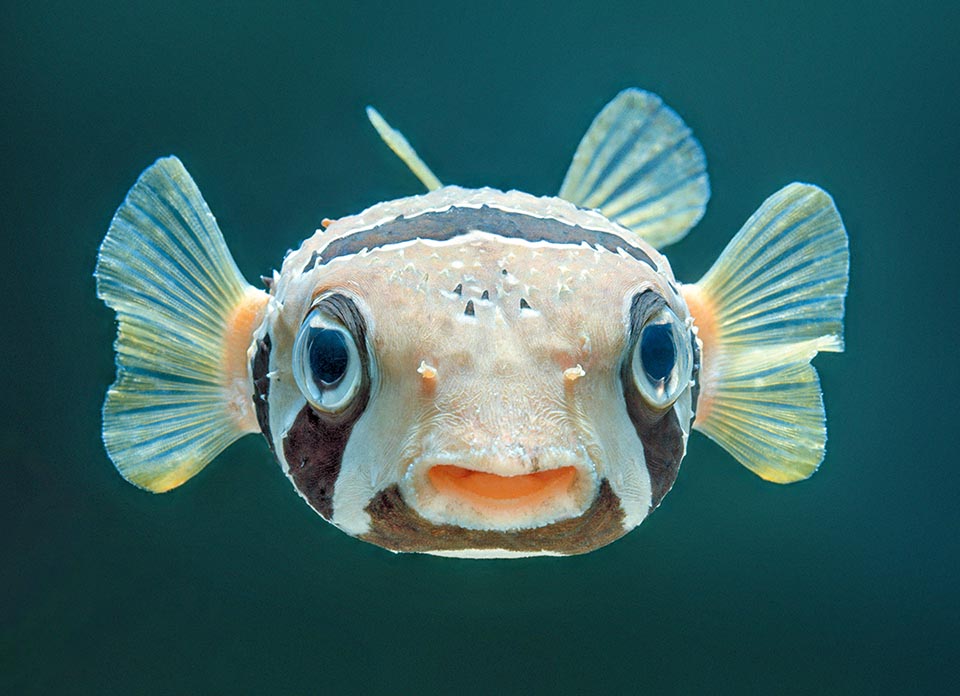
Or, like Diodon liturosus, the body gets the look of an inflatable ball, at times spiny and in any case difficult to seize © Giuseppe Mazza
Frequently the mouth can be variously everted; in some fishes it is equipped with fleshy barbels, skin appendages of various shape and length, rich in tactile and gustatory receptors.
Some species are equipped with oral poisonous glands; however real salivary glands are absent.
The tongue is stuck to the floor of the buccal cavity and is not muscular; it may be equipped with teeth and at times assists the breathing movements.
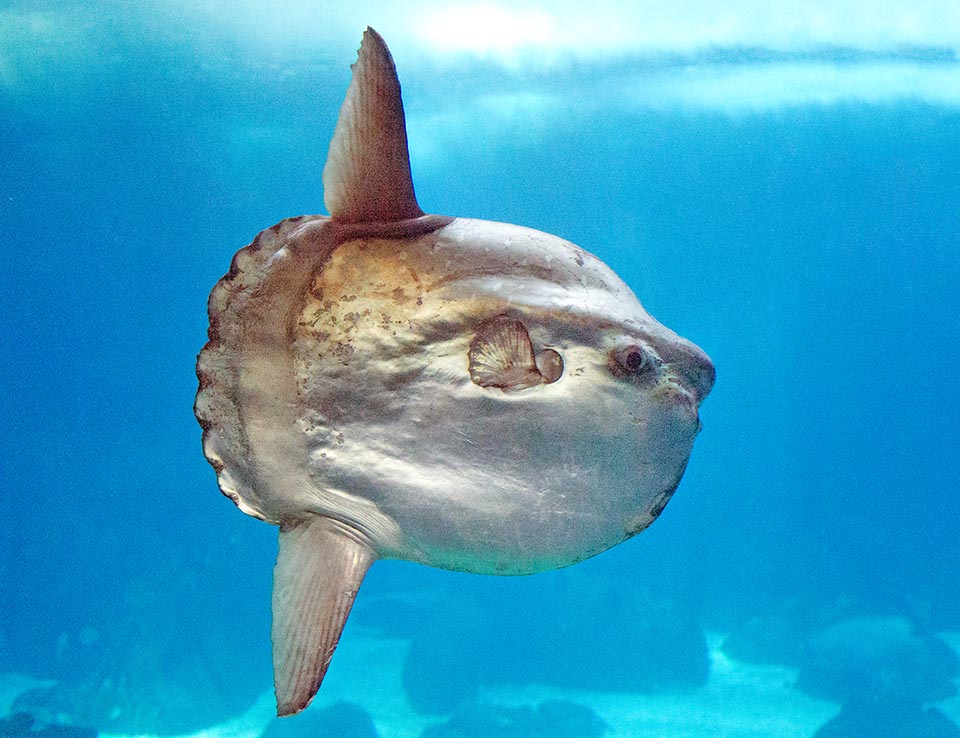
That discoid of the Ocean sunfish, the biggest extant bony fish, over 3 metres in size, is certainly no less surprising © Giuseppe Mazza
The teeth, having no real roots, are quite various as number, shape, as well as for disposition and are often of considerable systematic importance: they are sharp or conical, suitable for seizing the prey, in the predatory forms such as the Bluefish (Pomatomus saltatrix Linnaues, 1766) whose strong jaws are equipped with very robust and cutting triangular teeth, whilst they are wide and flat, good for the grinding, in the many species nourishing of animals having shell, like crustaceans, mollusks.
In the cartilaginous fishes (Chondrichthyes) the teeth are usually arranged in more series on the upper or maxillary arch of the mouth; otherwise in the bony fishes (Osteichthyes), the teeth are homologous to the placoid scales nd can settle not only on the jaws, but also on the tongue, on the palate,on the oesophagus and at time even on the branchial arches and on the hyoid bone.
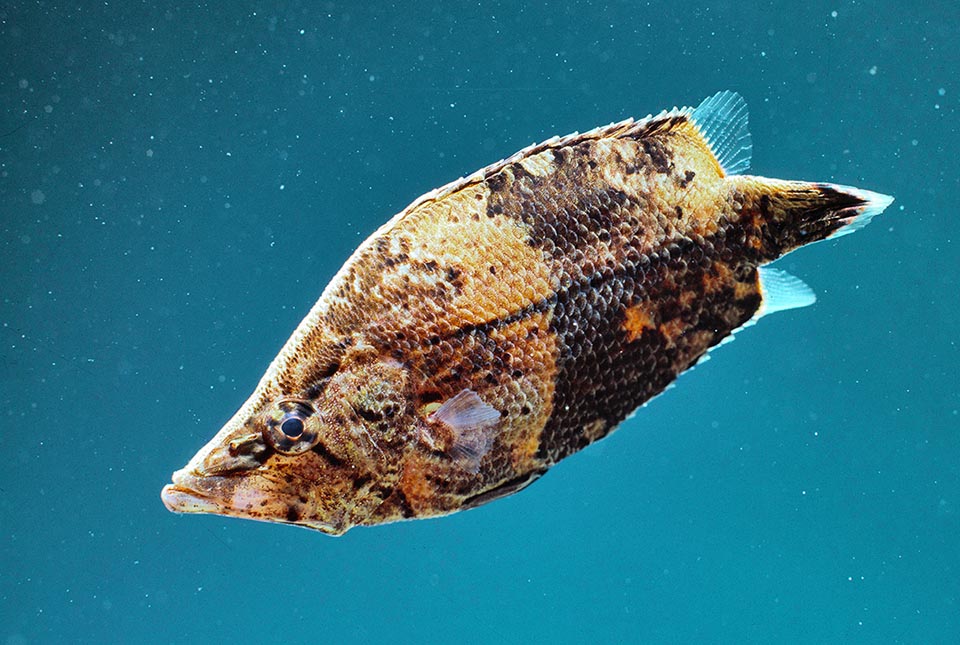
On opposite side the tiny Amazon leaffish (Monocirrhus polyacanthus) lives and preys in slow stagnant waters where is mistaken for a submerged leaf © Giuseppe Mazza
Some fishes, like the members of the order of the Cypriniformes, have teeth only on the lower bones of the pharynx, others like those of the Syngnathiformes, are completely toothless.
Finally, it is to be noted that the fishes that nourish of plankton, like several species of the orders of the Rajiformes, Lamniformes, Orectolobiformes among the Chondrichthyes and Clupeiformes and Acipenseriformes among the Osteichthyes, have the branchial arches equipped with spiniform formations (gill spines) forming a sort of a fine mesh sieve over the gill pouches that has the functîon of holding the plankton.
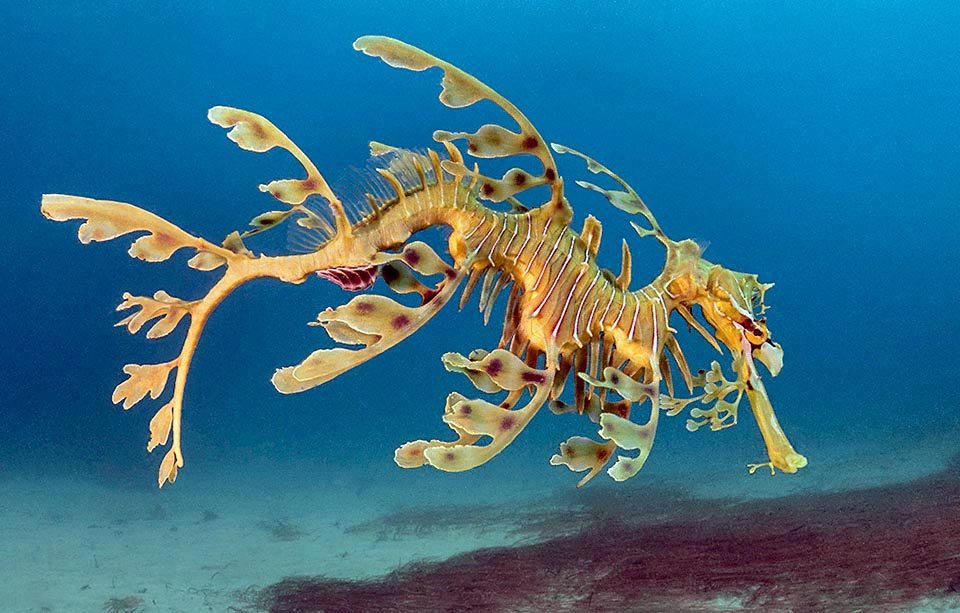
And in South Australia the Leafy seadragon (Phycodurus eques) has ramified outgrowths that render him similar to a tuft of wandering algae © Rafi Amar
Spiracles
In relation with the respiratory activity, back of each eye and before the first gill slit stands the spiracle, rounded and variously complex opening that allow the fish to introduce water in the pharynx and hence in the gills from which it gets out; in this way the circulation of the water introduced through the spiracle and through the mouth ensures that no material reaches the gills that could clog them.
SENSORY ORGANS
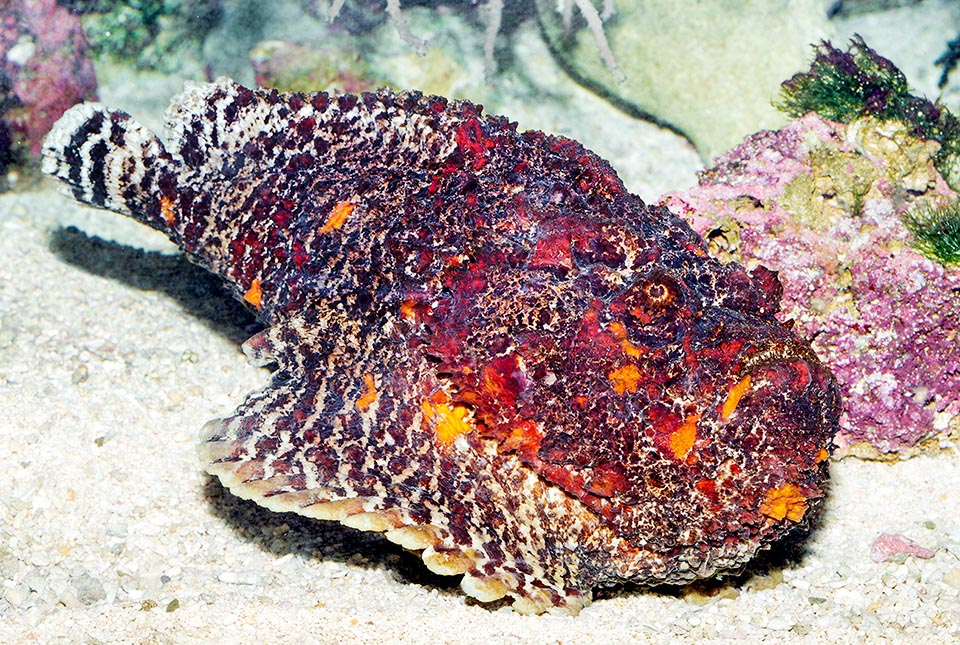
The very venomous Stonefish (Synanceia verrucosa), tropical relative of scorpionfishes has the body similar to a stone © Giuseppe Mazza
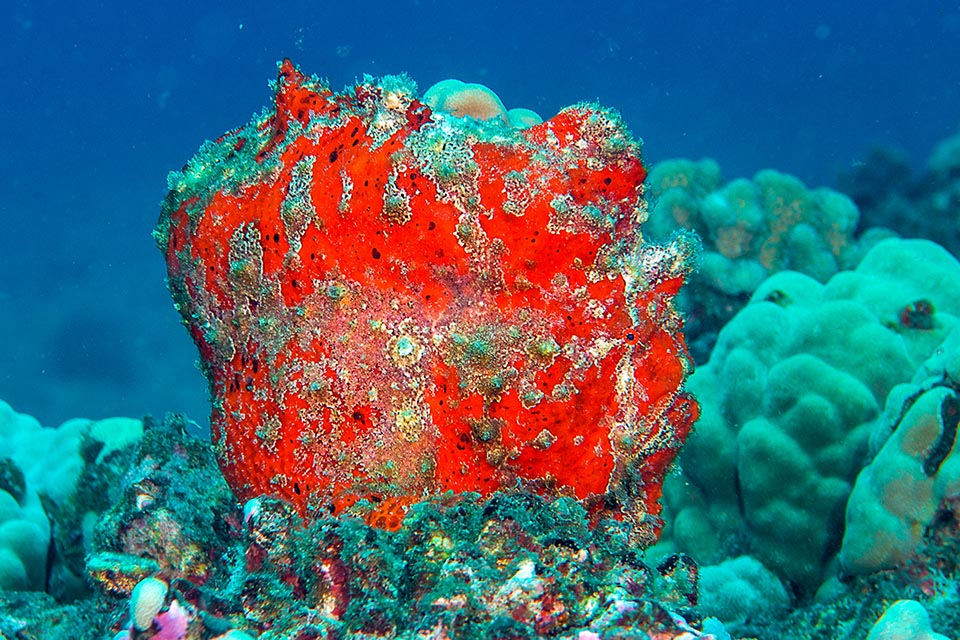
But it’s very difficult to outdo in camouflage the Giant frogfish (Antennarius commerson) that here imitates a sponge baiting with a small line passing by the small fishes © Keoki Stender
Sight
The eyes, adapted for monocular underwater vision, are a couple and in most species they are sited on the sides of the body; usually they appear well developed and transparent, even if in some species they can reflect yellow or green tints like in the Tench (Tinca tinca Linnaeus, 1758). or can be red like in the Roach (Rutilus aula Bonaparte, 1841).
The iris, devoid of mobility, is characterized by a metallic brilliance and the crystalline appears spherical and hard and with a practically flat cornea; the retina is equipped with numerous rods whilst in some abysmal forms that may be completely devoid of cones.
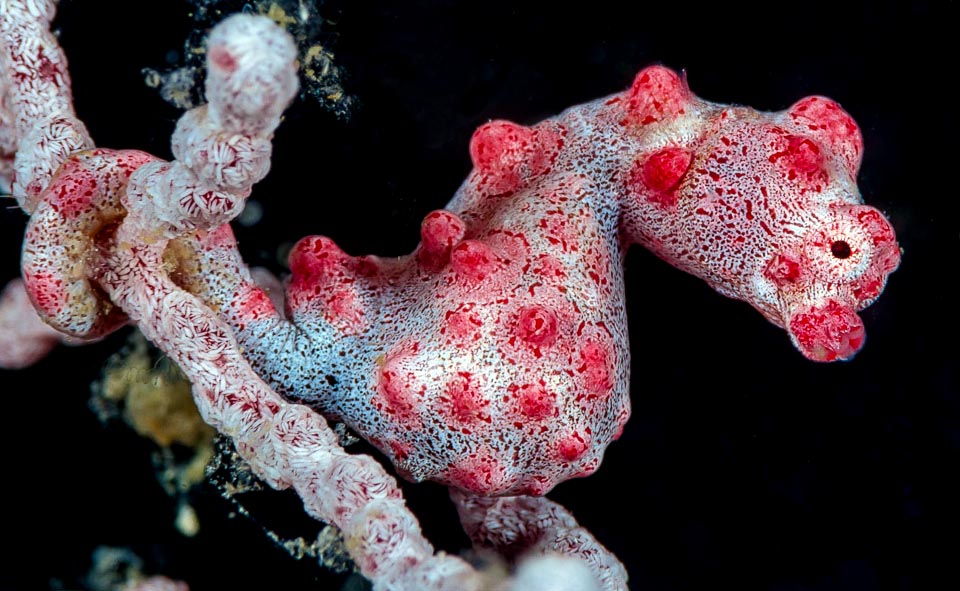
The 2 cm Pygmy seahorse (Hippocampus bargibanti) is no less: escapes from predators imitating the gorgonian where it lives and feeds on the passing microfauna © François Libert
Operated by three pairs of muscles as in the rest of the vertebrates, the eyes do not have lacrimal glands and generally also eyelids.
In the (Elasmobranchia), subclass of the Chondrichthyes that includes sharks, rays and stingrays, frequently each eye is equipped with a real nictitating membrane, a transparent eyelid having a protective function.
Also various reptiles and birds do have a real nictitating membrane, whilst many species of mammals, man included, have only a small vestigial residue present in the inner corner of each eye, an important reminder of their origins.
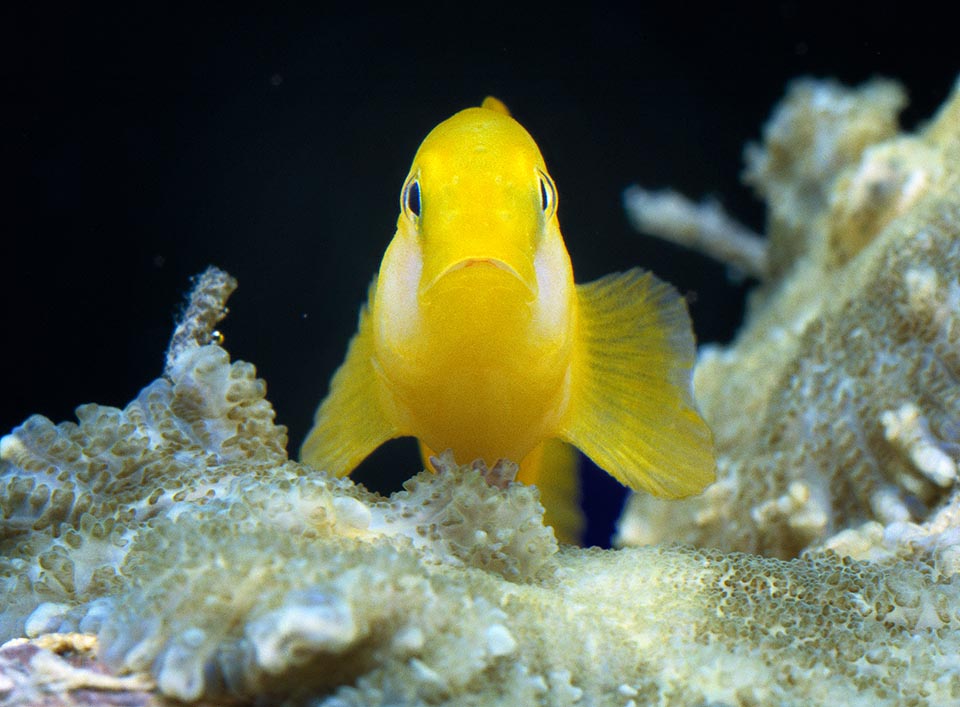
Even if here the look is more normal, similar is the size and strategy of the Okinawa goby (Gobiodon okinawae) who waits calmly for preys among the polyps of madrepores © Giuseppe Mazza
Structured for near vision, the eyes of the fishes can also perceive distant objects thanks to their capacity to adapt the position of the crystalline by means of the action of specific muscles.
Moreover, the fishes are also capable of distinguishing colours and images, and even to perceive the ultraviolet light.
Although in the majority of these animals the eyes are placed laterally, there are plenty of examples where the organs of the vision are sited dorsally, or both on a same side, called ocular or zenithal as observed in the adults of some groups, like Pleuronectiformes, soles, turbots and others more.
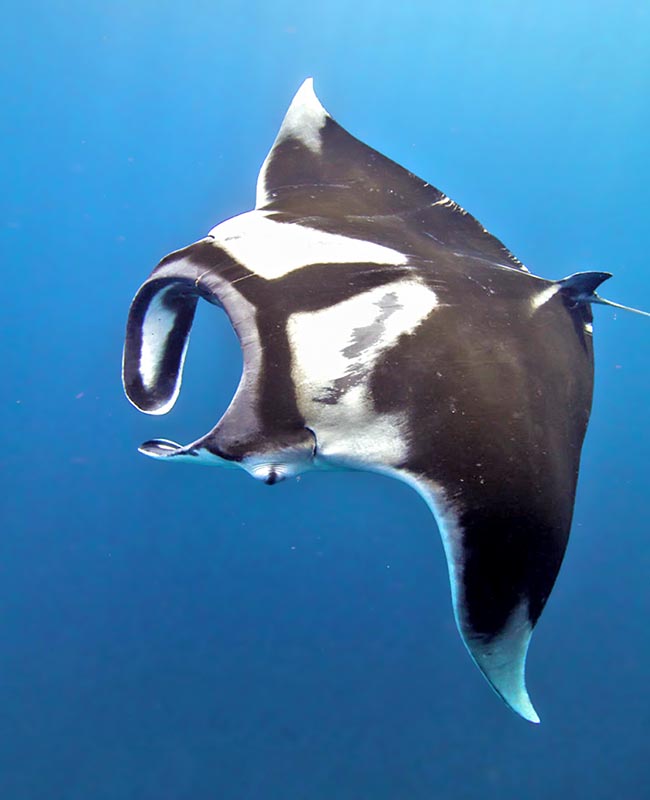
Be small or be big for surviving, like the majestic Giant manta ray (Mobula birostris ) who also nourishes mostly of plankton, mainly copepods, but may easily exceed, with its spread big pectoral fins, even the 9 metres of width © Magnus Larsson
Conversely, in some species the eyes are set on reliefs, so they have the possibility of silting up on the bottom and to comfortably explore the surrounding environment.
Naturalistic curiosities, fruit of centuries of crossings done in Japan and in China, are represented by several varieties tha man has obtained starting from the common Goldfish (Carassius auratus Linnaeus, 1758).
These varieties characterize for the big eyes protruding much from the eye sockets, like the Telescope eyed oranda, with the uniform red livery or variegated with white or black spots, and the Black Moor or Black Crucian much known by the aquarists.
Otherwise, in several deep-sea or cavernicolous the eyes are variously regressed or completely missing, as is the case in the species of Amblyopsis, genus of the family of the Amblyopsidae diffused in underground water streams of southeastern North America.
Hearing
The organ of the hearing is located inside a capsule situated on the sides of the head, and is represented only by the inner ear; the outer and the median ones are missing.
The inner ear is formed by the labyrinth whose upper part, utricle, leads to three semicircular canals, equipped with ampullae, and communicates through a narrow passage with a lower part, called saccule.
In many fishes the eye is capable to perceive also the high frequency sounds through the so-called Weber ossicular chain, modified vertebrae that transmit the vibrations of the wall of the swim bladder caused by the sound waves to the labyrinth to which it is connected.
Moreover, on the head are present sensory structures responsible for detecting the low-frequency vibrations of the water; these structures are formed by small dermal cavities (Ampullae of Lorenzini), each of which opens to the outside with a pore and is connected with lateral nerve terminations.
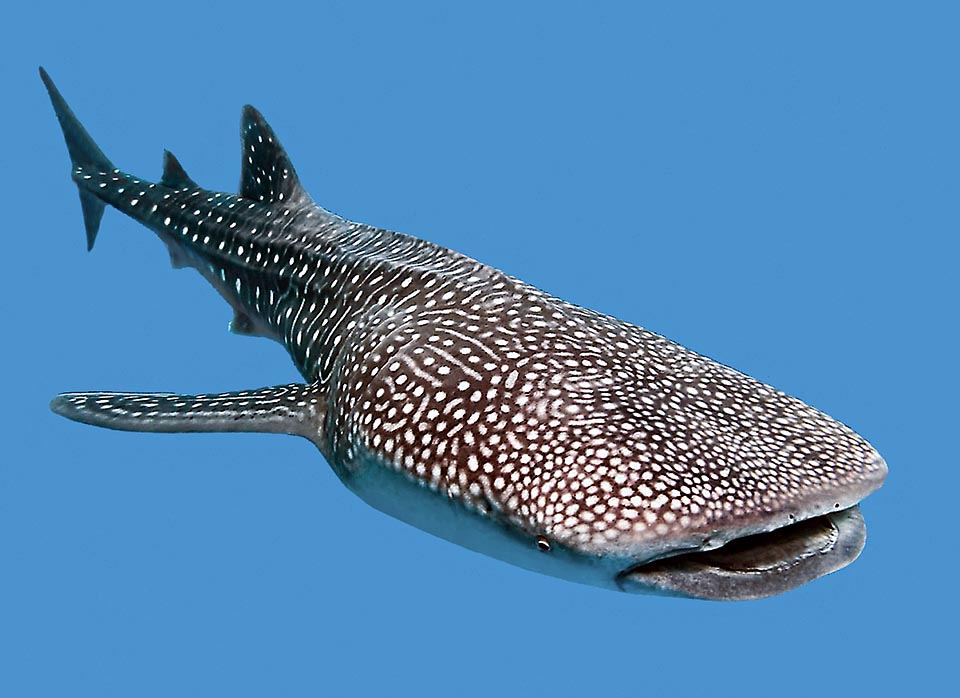
Another plankton-eating heavyweight is the Whale shark (Rhincodon typus) who with its 20 o of length is the greatest extant fish © Gianemilio Rusconi
In almost all cartilaginous fishes (Chondrichthyes), the labyrinth communicates with outside via a thin duct, whilst it is completely closed in the bony fishes (Osteichthyes).
In the fishes, like in the other vertebrates, besides the perception of the sound, the main functions of the hearing organ are those of the orientation and of the balance.
Olfaction
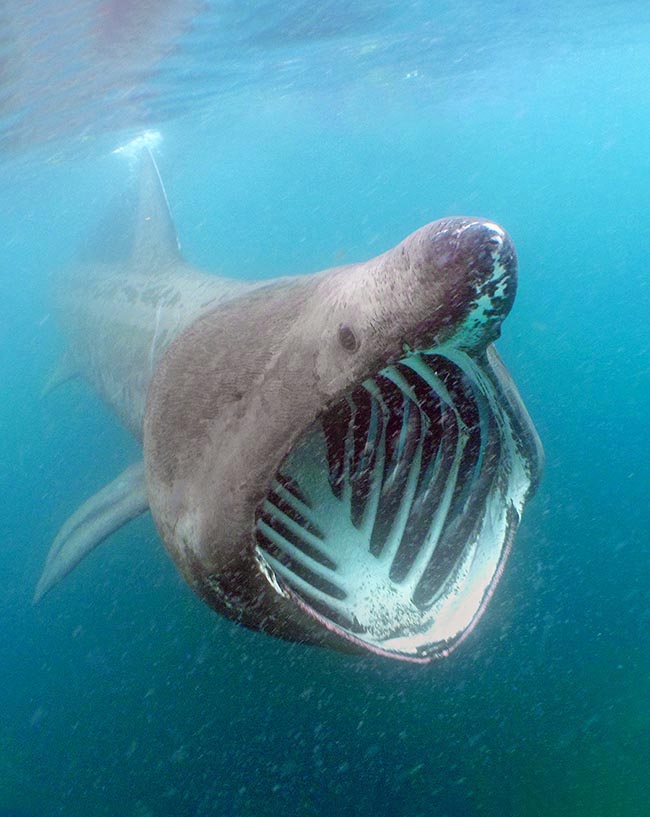
The second standings place with 7-9 m and 4-5 t, belongs to Cetorhinus maximus who sieves sea with its gill rakers swallowing more than 1000 t of water per hour. Its stomach may contain 500 kg of plankton and schooling fishes © Yo-Han Chai
The organ of the olfaction is formed by two blind dimples and usually not communicating with the oral cavity, whose walls are covered by a pleated mucous membrane.
The two nostrils open on the snout, mostly in dorsal position; exceptions are the cartilaginous fishes (Chondrichthyes) and the lungfishes (Dipnoi) where they are arranged vertically
Taste
The taste organs are arranged in various ways all over the body, but in particularly high numbers in the buccal cavity, on the lips and in the barbels.
On the skin and on the fins are allocated organs capable of detecting possible chemical modifications of the water.
On the head stand particular sensory cutaneous receptors that presumably are involved in the perception of the variations of temperature.
Conversely, the receptors of pain stimuli are little represented.
Lateral line
On the sides stands the so-called lateral line, an organ that, thanks to the presence of ciliate mechanoreceptor cells is able to detect the perturbations transmitted through the water, such as the variations of the pressure done on the sides.
The lateral line is formed by sensory organs usually placed inside ducts full of mucus, arranged in a longitudinal series extending under the outer tegument, from the head up to the tail, and that open outside by means of pores.
Finally, the lateral line works similarly to a radr and informs the animal about the presence of an obstacle, giving him in the meantime also precise indications about the strength and the direction of the current.
Furthermore, the stimuli transmitted by the labyrinth and by the lateral line induce compensatory reflex movements of the paired fins and of the trunk muscles that allow the animal to maintain the usual position of the body.
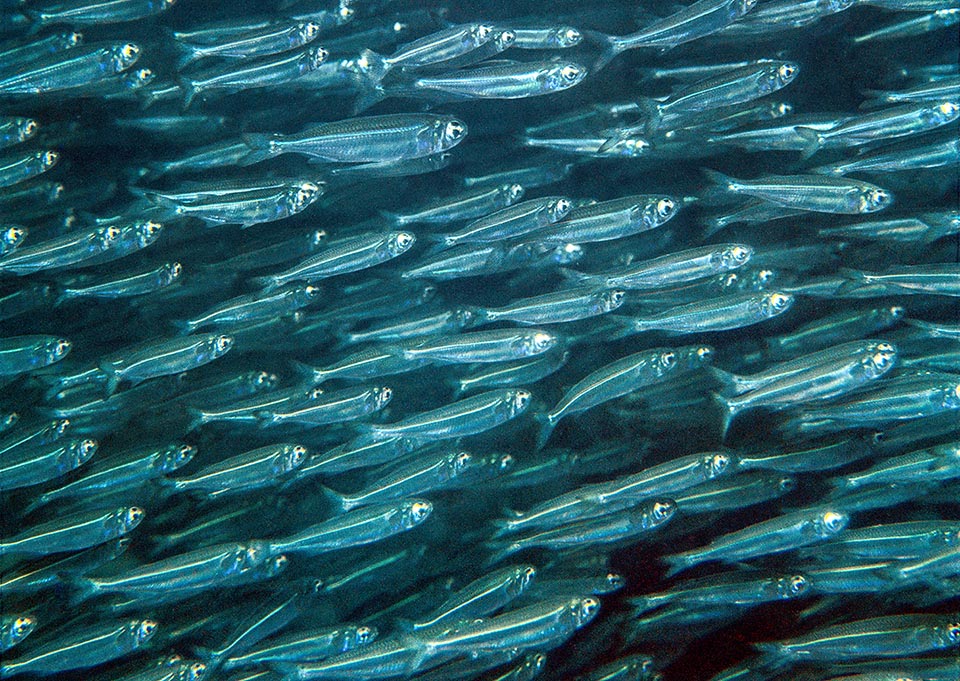
These Hypoatherina barnesi advance in sync thanks to the lateral line, a sensory organ located on the sides that detects the water movements © Giuseppe Mazza
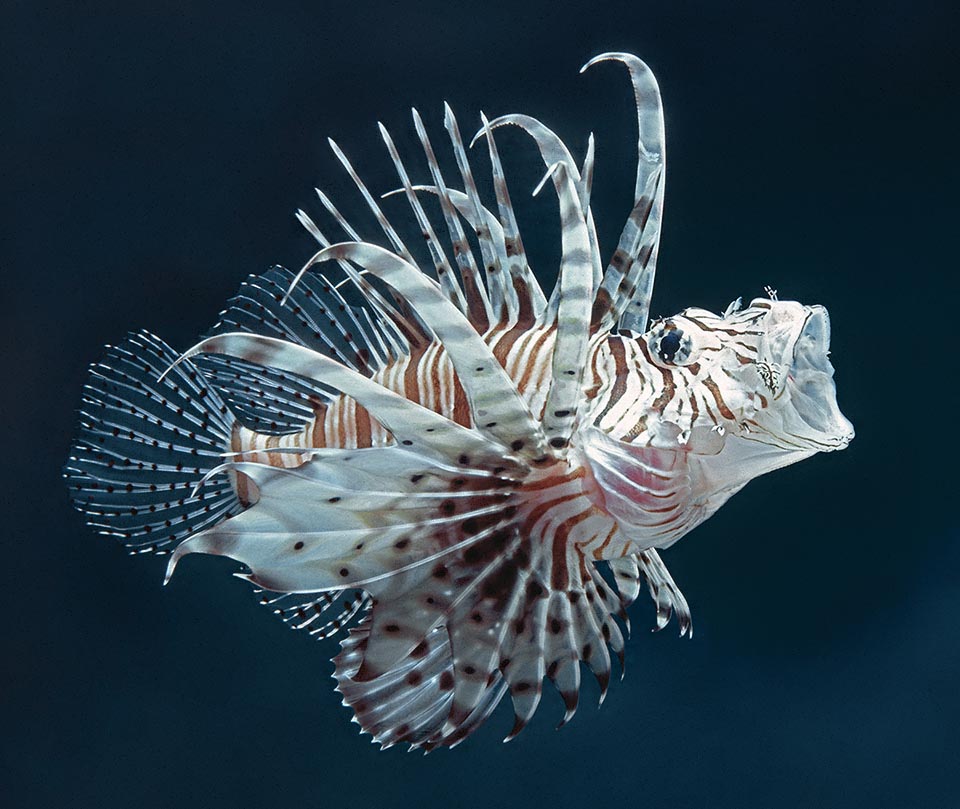
The mouth can be everted, as is the case of Pterois volitans, creating an unexpected vacuum that sucks up the preys © Giuseppe Mazza
TEGUMENTARY SYSTEM
In the Fishes the skin helps in regulating the osmotic exchanges with the aquatic environment and is formed by a thin sheet of epidermis and by connective tissue arranged in several layers. In several cases the skin is bare, like in some species of the order of the Siluriforms, but in most of these vertebrates is covered by scales, often reinforced also by denticulate formations or by bony shields.
The epidermal layer is rich in unicellular glands metabolically active and often secreting mucus, keratins and other substances.
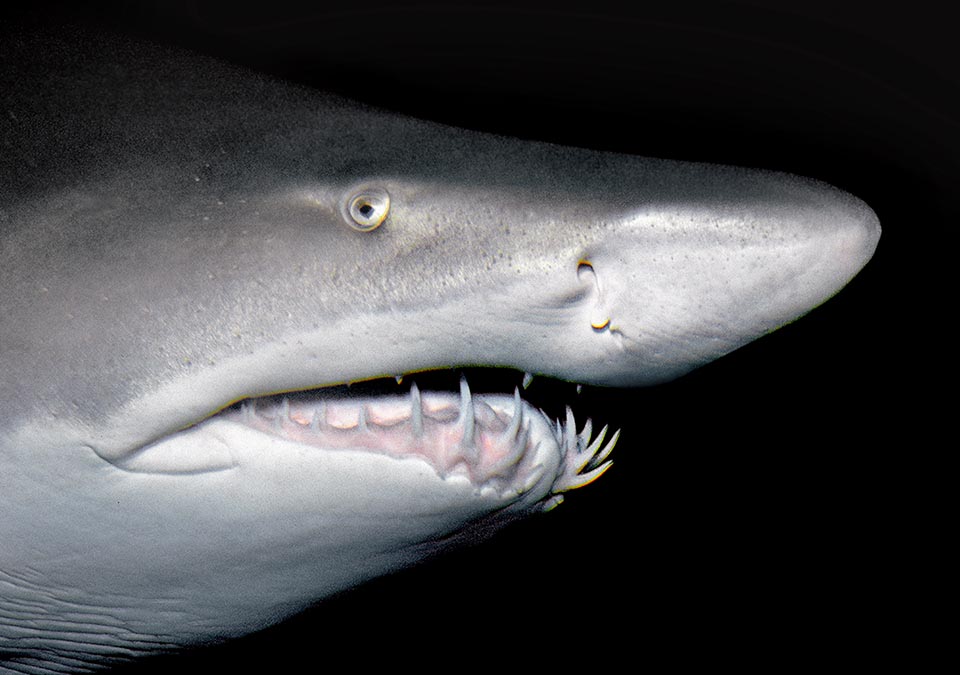
Close-up of a Carcharias taurus head. The teeth, without roots, are arranged in more series on the two arches. A nostril stands below and just over the hole of a spiracle © Giuseppe Mazza
Some bony fishes, as in the case of the Weevers of the genera Echiichtys and Trachinus of the family of the Trachinids and of the Red scorpionfish (Scorpaena scrofa Linnaeus, 1758) of the family of the Scorpaenids (Scorpaenidae), have the epidermal layer equipped with poisonous glands associated to robust spines of the branchial operculum and of the dorsal fin; the poison is utilized for defensive purposes. The Common stingray, more commonly called Pastinaca, (Dasyatis pastinaca Linnaeus, 1758), cartilaginous fish of the family (Dasyatidae), has the tail armed with a serrated and poisonous sting capable of producing even fatal wounds.
The Silver-cheeked toadfish (Lagocephalus sceleratus Gmelin, 1789), bony fish of the family Tetraoditidae contains in the skin, in the liver and in the reproductive organs very poisonous substances, resistant even to cooking.
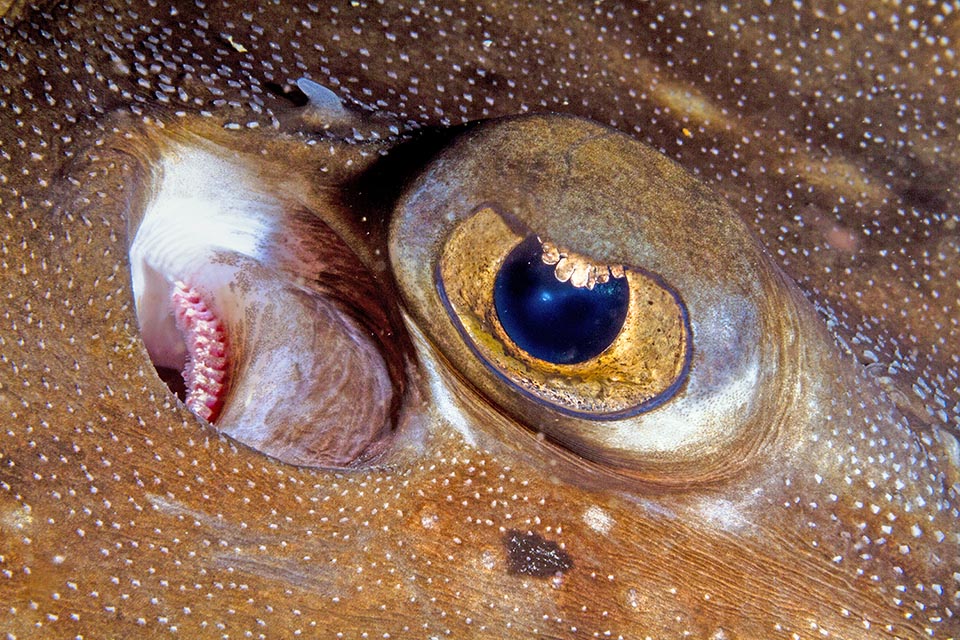
In this Raja undulata the spiracle is more evident. It sucks the water and draws water out of gills, oxygenating them with no risk of clogging when fish rests on a bottom © Raimundo Fernández
The scales, formed by small rounded plates of rigid and fibrous connective tissue, implant singly in particular pouches and are covered by the transparent and soft epidermis.
The scales are ordered like the tiles of a roof, partially overlapped, ordered in transversal series and with free posterior margin.
Depending on their structure, the scales are distinguished in placoid, ganoid, cycloid and ctenoid. The constancy of the structure and of the arrangement of these bony formations within a group or a single species is an important character of different taxonomic meaning.
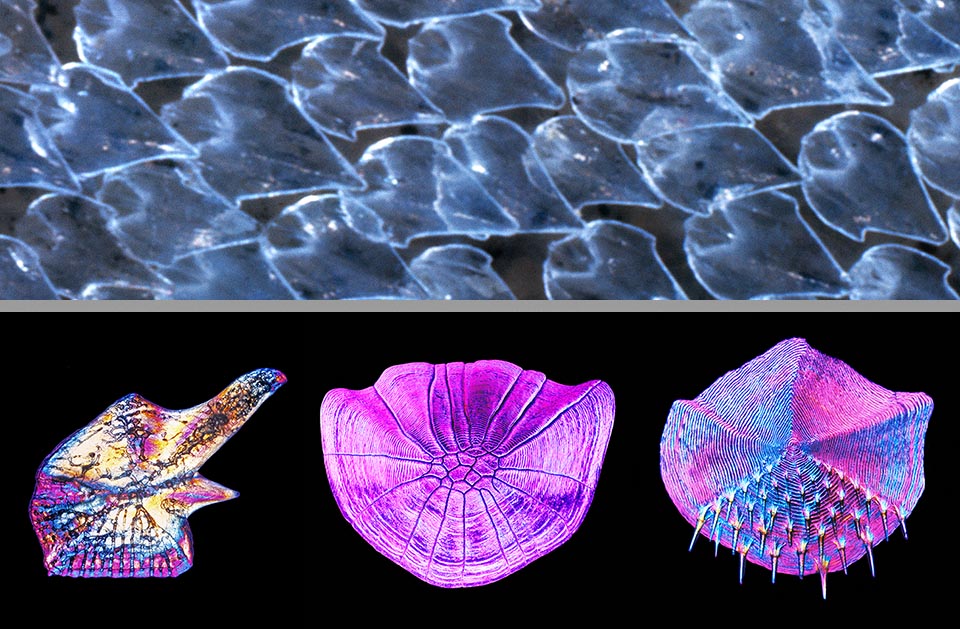
Above shark skin called zigrino with placoid scales of Mustelus. Below, in polarized light, ganoid scale of Calamoichthys, cycloid of Barbus and ctenoid of Coelorhynchus © Giuseppe Mazza
The placoid scales are those of the most primitive type and are formed by a rhomboidal plate from which raise one or more teeth, formed by dentin and covered by a thin layer of enamel, with the tips protruding from the overlying epidermal layer and move obliquely backwards; in such way the tegument is particularly rough in the posterior-anterior direction.
Scales of this type characterize particularly Elasmobranchia and Balistidae.
In many sharks the placoid scales are small and form a thick continuous cover of tiny cutaneous teeth with the tip bent backwards, very hard and covered by enamel that confers the skin a particular roughness.
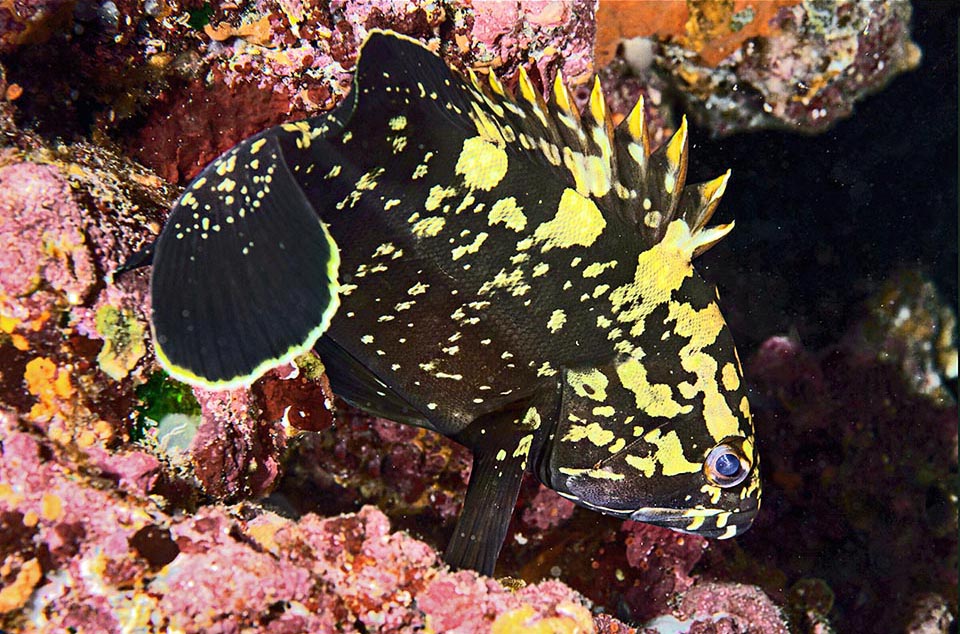
Young Epinephelus marginatus. In this grouper the scales are of two types: over the lateral line ctenoid and below cycloid © Ignazio Riccioli
Suitably tanned, the skin of these animals (zigrino) is utilized to sand the hardwood and even ivory; or, smoothed in turn, is utilized for binding books and for covering ornamental objects.
Typical of some bony fishes of the class Sarcoterygii and the orders Acipenseriformes and Lepisosteiformes, are the ganoid scales, rhombic bony plates covered by ganoine or ganoidine, shiny and hard substance similar to the enamel.
The cycloid scales characterize for printing the rear margin smoot h and protruding free from the appropriate pouch; usually they are typical to the fishes equipped with fins having soft rays, among which the bony fishes of the families Amiidae, with the only extant species Amia calva (Linnaeus 1766), Salmonidae, Clupeidae, Cyprinidae,and others more.
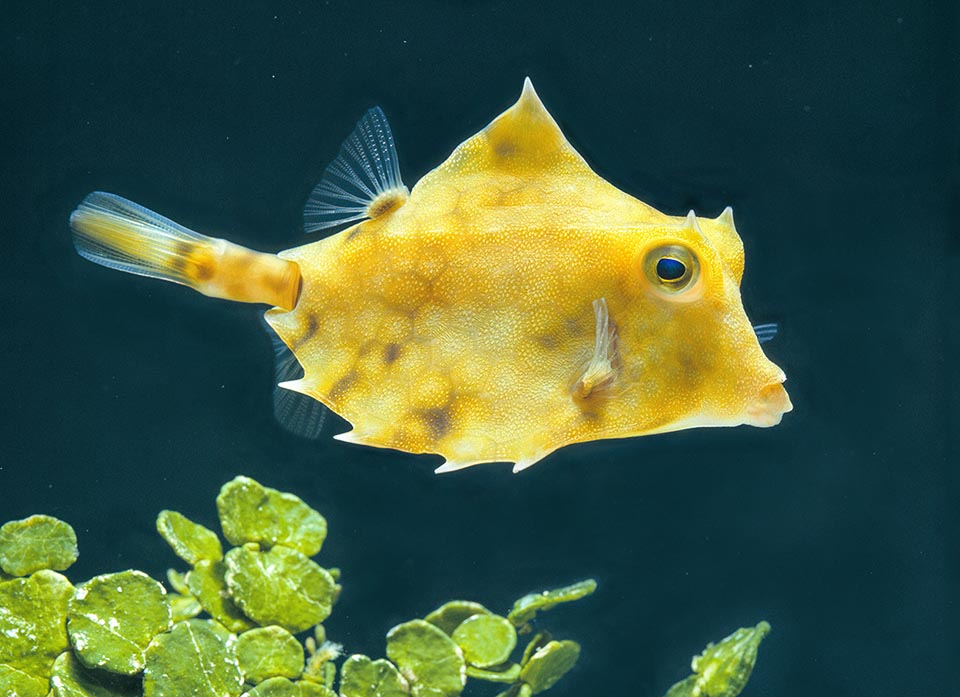
Tetrosomus gibbosus. In the Ostracionids, known as boxfishes, the scales merge with each other to form big bony cutaneous plates and at times robust cuirasses © Giuseppe Mazza
Structurally similar to the cyclois, are the ctenoid scales that are distinguished as having the rear margin serrated.
This type of scales is usually met in the species whose fins are supported by rigid rays, such as the Percidae, family of bony fishes of the order of the Perciformes.
In this regard are not missing several exceptions, such as the Groupers of the genus Epinephelus (Bloch, 1793), Perciformes having the parts of the body located above the lateral line are covered with ctenoid scales, whilst those placed below present cycloid scales.
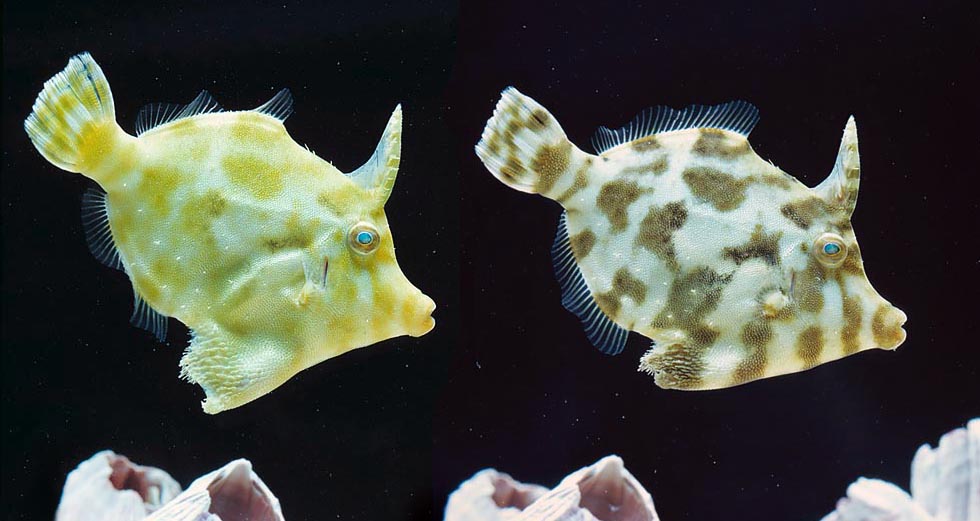
Acreichthys tomentosus. In this filefish, as happens for the triggerfishes, the skin is covered by small and spaced bone plates with one or more spinules. Thanks to the chromatophores, the cells containing pigments, livery can change look in an instant, dispersing or concentrating them depending on the mood or for camouflage reasons © Giuseppe Mazza
Also for what the size is concerned, the scales are of very varied dimensions; in some forms they are about 5 cm broad, like in the Atlantic tarpon (Megalops atlanticus Valenciennes, 1847), in others they are practically microscopic like in the European eel (Anguilla anguilla Linnaeus, 1758).
In some instances the scales merge with each other forming big cutaneous bony plates and at times strong cuirasses with protective function, such as in the Siluriformes of the family of the Callichthyidae and in the Tetraodontiformes of the family of the Ostraciidae. The epidermis covering the scales is particularly rich in mucous glands, whose transparent secretion covers the whole body of the fish protecting it against the bacterial and fungal infections; moreover, it renders the body slimy thus contributing to reduce the friction with the water while swimming.
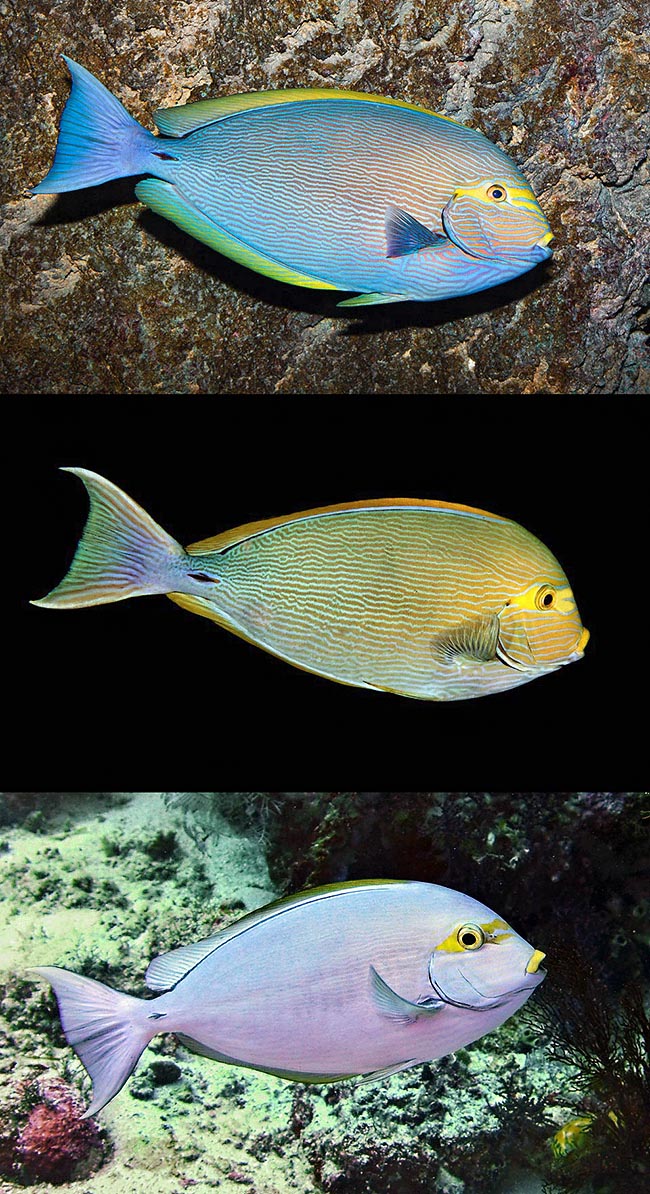
It is always due to the chromatophores that this Acanthurus mata changes incredibly colour and pattern reaching at the end, when needed, even a wholly white or back livery © Giuseppe Mazza © Rickard Zerpe © Karine Marangon
It is also believed that the layer of mucus covering the body plays an important rôle also in the skin permeability regulation towards mineral salts and water.
In the fishes the cutaneous corneal structures are quite rare; are to be remembered the pearly organs, spiny tubercles that during the reproductive period appear especially on the head of the males of some Cyprinidae.
ADAPTATIONS AND ETHOLOGY
The body of the fishes has a very varied colouration, from dull and monochromatic to particularly showy, colourful and adorned by shiny and elegant drawings.
The colouration is due to the pigment granules, the chromatophores, contained in the cells of the dermal layer, or placed over or under the scales themselves; participate to the colouration of the body also the carotenoid pigments of the adipose layer (yellow, orange, red lipophores).
Usually, the colouration of these animals is also affected by physical phenomena of reflection and of interference (iridescence).
After the type of contained pigments, the chromatophores are indicated with various names, melanophores, erythrophores, xanthophores, guanophores, depending whether they contain respectively granules of black, red, yellow pigment or iridescent crystals of guanine.
Many fishes are able to change the colouration of their own body, dispersing or concentrating, quickly or slowly, the pigmented granules contained in the chromatophores.
The stimuli to change the status of the chromatophores, and consequently, are the colouration of the animal, are transmitted by the nervous system that in turn gets them from the surrounding environment through the eyes.
It is to be kept in mind that also environmental solicitations, like a higher temperature rather than the absence of oxygen, or feeling of fear, etc., may cause a chromatic alteration.
The capacity of camouflaging with the surrounding environment in some fishes is enhanced by the possibility of forming on their own body spots that often perfectly imitate the substratum where they take refuge (mimicry s.l.).
In some species the brisk liveries have the function of warning for possible predators, as happens in several poisonous species of the order of the Tetraodontiformes, like the Pufferfishes of the family Tetraodontidae and Porcupinefishes of the family Diodontidae.
Many species change their own colouration during the reproductive period and frequently the male, similarly to what happens in Birds, with a clear purpose of sexual appeal it gets a very showy nuptial livery and develops on the skin outgrowths variously shaped. Usually the most lively colours are typical to the fishes living in the tropical seas and in the continental waters.
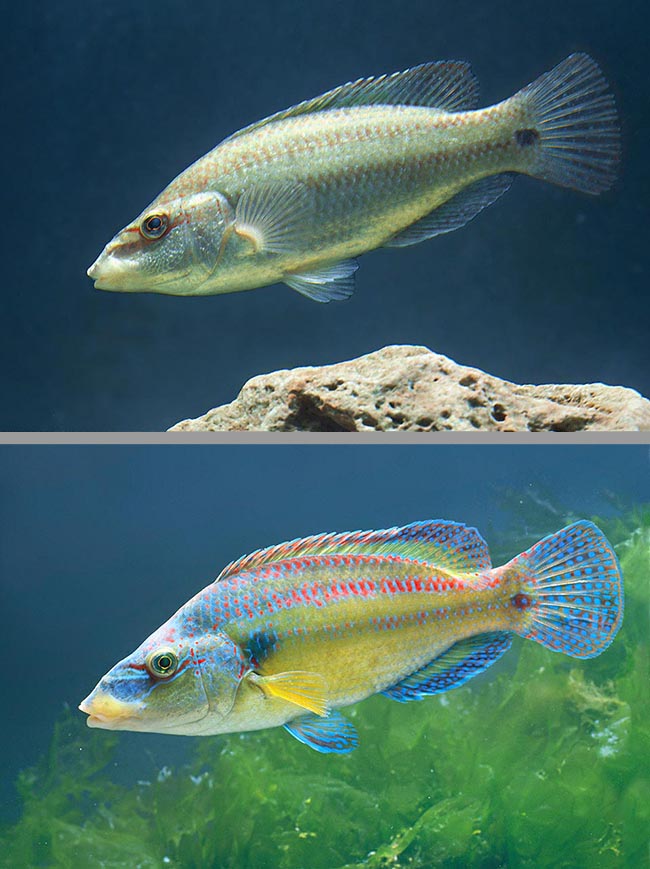
Male of Symphodus tinca in normal and nuptial livery. Many species change colour during the mating period © Giuseppe Mazza
Usually the forms populating the sea abysses have a dark colouration, whilst the cavernicolous ones who are blind lack pigmentation.
Conversely several species are not able to modify the drawing or the colour of the body.
Light organs
In many species, especially within the Osteichthyes,the tegument is equipped with luminous organs (photophores), usually of a glandular nature.
The largest number of luminescent species live at medium depths; within these the most varied forms belong to the families of the Squalidae among the Elasmobranchia, of the Stomiatidae, Searsidae and Myctophidae among the Salmoniformes,and to the Ceratiidae among the Lophiiformes.
Conversely, less frequent seem to be the species equipped with light organs that populate the great seabeds: are known only some abyssal forms of the families of the Macruridae and of the Moridae, of the order of the Gadiformes.
From a structural point of view, the photophores are formed by a lens, convergent or divergent, located in the opening of a skin alveolus embedded in the epidermis and whose walls are glandular cells that produce the photogenic substance. In some forms, like in the Rat fishes of the family Macruridae, like the Bluntsnout grenadier (Nezumia sclerorhynchus Valenciennes, 1838) abyssal species present also in the Mediterranean, instead, the light is produced by accumulations of luminescent bacteria contained in the photogenic organs.
In the bioluminescent fishes usually the photophores are arranged in two series along each side of the body. Other light organs are situated also on the head, behind the eyes, close to the jaws. The abyssal species of the family of the Myctophidae, such as the Glacier lantern fish (Benthosema glaciale Reinhardt,1837), Ostheichthyes widely diffused in all seas, Mediterranean included, characterize for the presence of photophore organs arranged like the pearls of a necklace to form drawings that are different from species to species and from genus to genus.
The species of Porichthys, genus of Batrachidiformes living along the coasts of North America, characterize themselves for the presence of a high number of light organs (more than 800) arranged in series or in groups on the head and on the abdominal region.
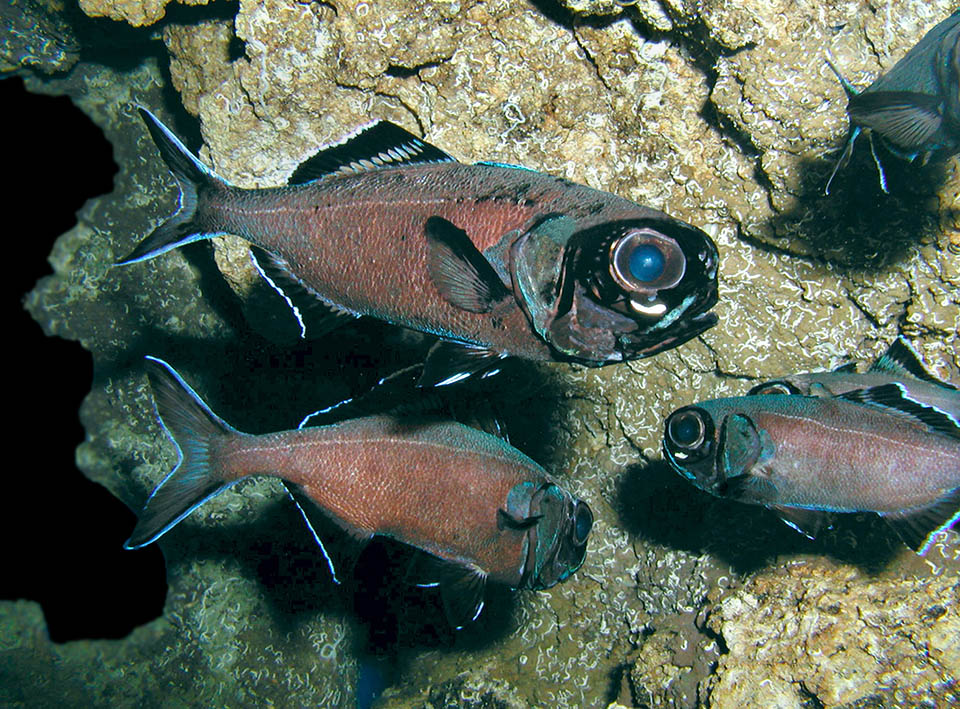
The fishes living in deep waters often intrigue the preys with light signals. For instance Anomalops katoptron, who rests during the day in the grottoes and hunts by night going down up to 400 m, has under eyes a bean-shaped small light window, flashing 18-90 times per minute, fed by symbiotic bioluminescent bacteria © Giuseppe Mazza
Some fishes present a barbel on which stand plates of luminescent tissue and that can be used as bait.
Others, like the Viperfishes, depth species of the genus Chauliodus (Bloch e Schneider, 1801) of the order of the Salmoniformes, to attract the prey they swing like a trap in front of the mouth the luminescent apex of the second ray, particularly developed, of the dorsal fin. In particular, among the viperfishes, the Chauliod (Chauliodus sloani Bloch & Schneider, 1801), species of 30-60 cm living in the depths of the tropical and temperate waters of all the oceans, is equipped with about 350 luminous organs situated inside the mouth, on the head and along the sides and on the belly.
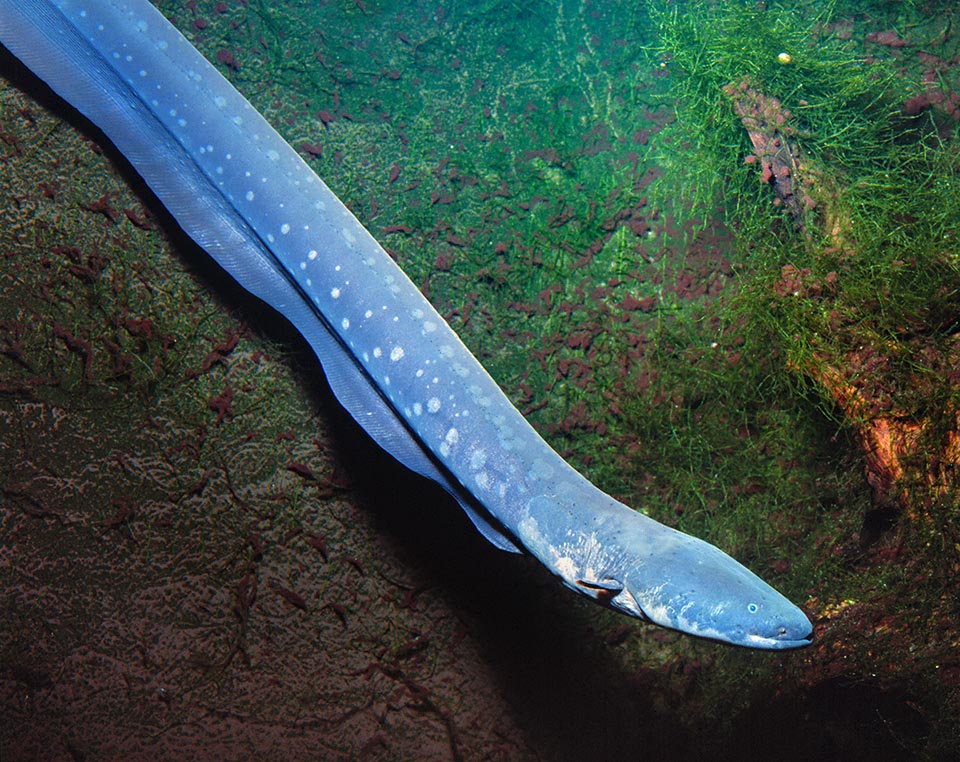
Conversely, other fishes, at times present in very shallow waters, base their hunting strategies on electricity. The Electric eel (Electrophorus electricus) for instance, catches besides the fishes, with acrobatic leaps and 480 volts shocks, also the land animals that get close to drink in the swamps or in the periodically flooded zones where it lives © Giuseppe Mazza
In their turn, the females of most species of Lophiiformes Ceratioidei living in the dark marine depths display the extremity of the illicium, structure coming from the very elongated first ray of the dorsal fin, equipped with a bright flap that, waved in front of the mouth, attracts possible preys.
Among the most known examples of bioluminescent fishes is to be mentioned the Triplewart seadevil (Cryptopsaras couesii Gill, 1883) whose particularity, common to many other Ceratiidae, is the presence of a showy illicium. And again, among the Chondrichthyes, some depth sharks are equipped with luminous organs.
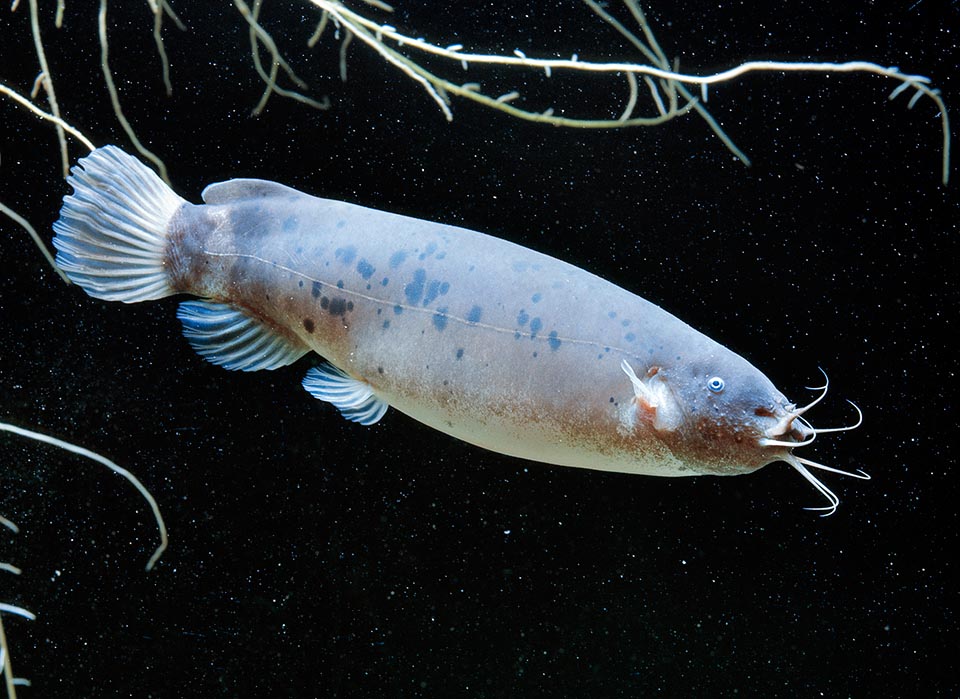
In Africa, Electric catfish (Malapterurus electricus), resembling a big sausage without scales, stuns in a similar way the fishes of various rivers, Nile included © G. Mazza
Among these, we mention the Pygmy shark (Euprotomicrus bispinatus Quoy and Gaimard, 1824), which, with about 30 cm of length is the smallest known shark, various species of Lantern sharks of the genus Etmopterus (Rafinesque, 1810), among which the Velvet belly (Etmopterus spinax Linnaeus, 1758) diffused in the eastern Atlantic and in Mediterranean, and the Black dogfish (Centroscyllium fabricii (Reinhardt, 1825).
For what concerns the meaning of the luminous emissions, it must be said that, besides being utilized for attracting the preys, they can also facilitate the meeting of the two sexes and also contribute to maintain the cohesion of the group.
Electric organs
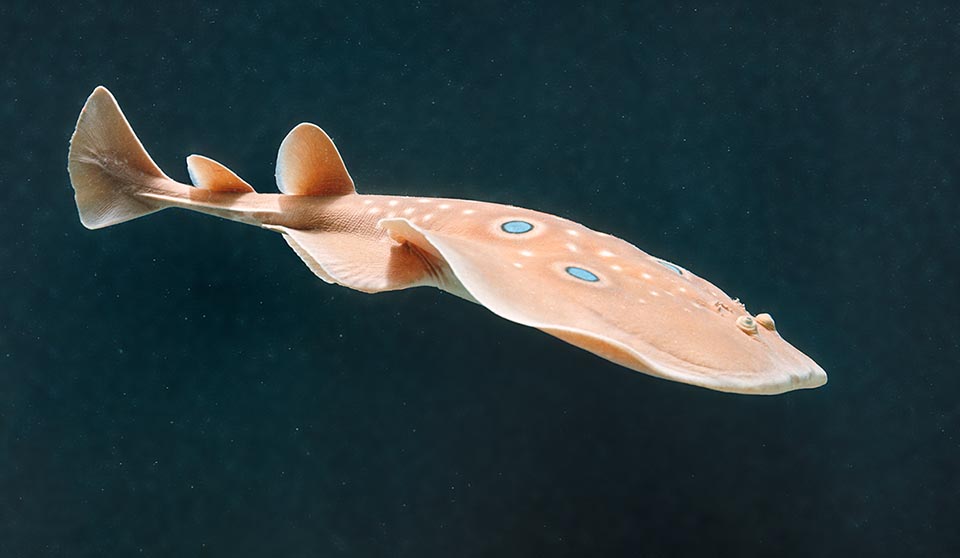
The Torpedo (Torpedo torpedo) hunts instead in Mediterranean and nearby waters of East Atlantic with shock that may reach 200 volts and 2000 watts © Giuseppe Mazza
Almost three hundred species of fishes, among which the Common torpedo (Torpedo torpedo Linnaeus, 1758), the Electric eel (Electrophorus electricus Linnaeus, 1766), the Mormyridae, represented by forms living in the inland waters of tropical Africa, and others more, characterize for having organs able to produce electricity and several ones are even capable to impart violent electric shocks.
Usually the electric organs get their origin from the modification of striated muscular fibres with the exception of some species of Siluriformes of the genus Malapterurus (Lacépède, 1803) where they conversely originate like in Malapterurus electricus (Gmelin, 1789) from cutaneous glands.
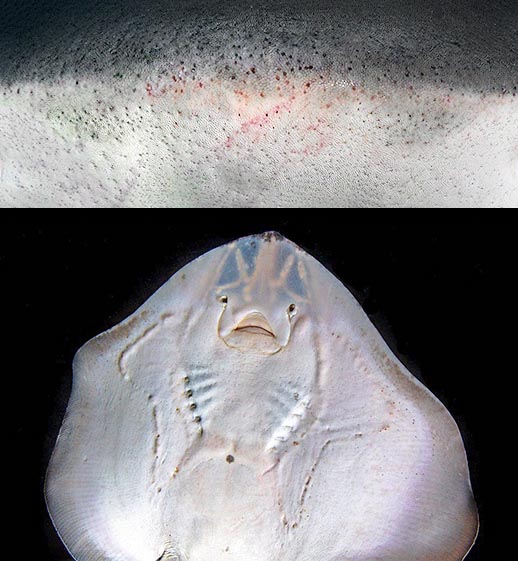
The Lorenzini ampullae, of which we see the exit holes on the snout of a shark (Negaprion brevirostris) and lined on the ventral side of a ray (Raja undulata), serve to these fishes to discover, thanks to the electrical field emitted by the preys, their caches and for orienting themselves in the movements taking as a reference the terrestrial magnetic field. Above © Rafi Amar and below © Raimundo Fernández
The generating organs are formed by thin discoid plurinucleate plates (electroplax) lined up on top of each other like the elements of a voltaic battery, immersed in a gelatinous matrix and connected with the nervous system via particular nerves; the face of the plate close to the nerve charges of negative electricity, the free one of positive electricity. The number of the plates can be very high, even up to 500.000 like in the big torpedoes.
The high intensity electric organs produce short bursts of pulses, with a frequency of several pulses per second; a big Torpedo may generate a shock having a tension over the 200 V with a power of 2000 watt, able to stun the preys and to keep away possible predators; even the man may be stunned by an electrical shock of this fish.
Conversely, the electric organs of weak intensity discharge in a rapid and continuous series of pulses, up to 300 per second, as occurs in the Aba (Gymnarchus niloticus Cuvier, 1829), species of an eel-like appearance widely spread in the major rivers and lakes of Africa.
The direct current generates an electric field whos direction varies, in the posterior-anterior direction in the Electric eel (Electrophorus electricus Linnaeus, 1766), from the abdomen to the back in the Torpedoes, or in anterior-posterior direction in the Malapteruro.
The possible variations in the electric field caused by the presence of bodies having a conductivity different from that of the water are perceived by very sensitive skin receptors; the animal in this way is informed, through an electroreceptor system that works like a species of radar, about the presence of obstacles, preys and predators.
The nature of the electroreceptors in the fishes varies depending on the group. In the Sharks and in the Rays (Rajiformes) the electroreceptive system is formed by sensory pores, usually located around the mouth, from where start small tubes filled with highly electro-conductive gel, the ampullae of Lorenzini; through the ampullae these fishes are able to perceive the earth’s magnetic field and therefore use it also for the positioning. Conversely, in the Mormyridae the electro-receptive system originates from modifications of the organs of the lateral line and are called mormyromasts.
SKELETON
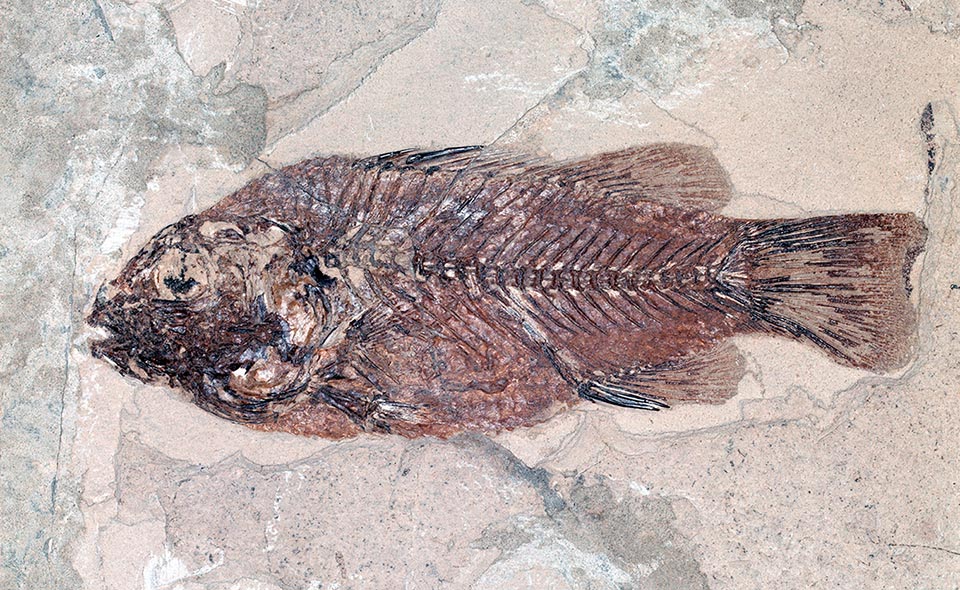
Cyclopoma gigas, fossil Eocene boby fish, lived about 50 million years ago. On the base of the nature of the skeleton, Fishes are grouped in two categories, the cartilaginous fishes, more archaic, without swim bladder, with the skull formed by a unique cartilaginous capsule, called Chondrichthyes, and the bony ones known as Osteichthyes © Giuseppe Mazza
In addition to performing support functions of the body and of support of the muscular system, the skeletal system protects, containing them, the encephalon, the spinal cord and part of the sensory organs.
Based on the nature of the skeleton, the Fishes are grouped in two categories, Chondrichthyes and Osteichthyes, to which several scholars attribute the systematic status of class.
To the Chondrichthyes more commonly Cartilaginous fishes, are ascribed the species having a mainly cartilaginous skeleton, even if more or less calcified, whilst the Osteichthyes, called Bony fishes, concern species having an essentially bony skeleton.
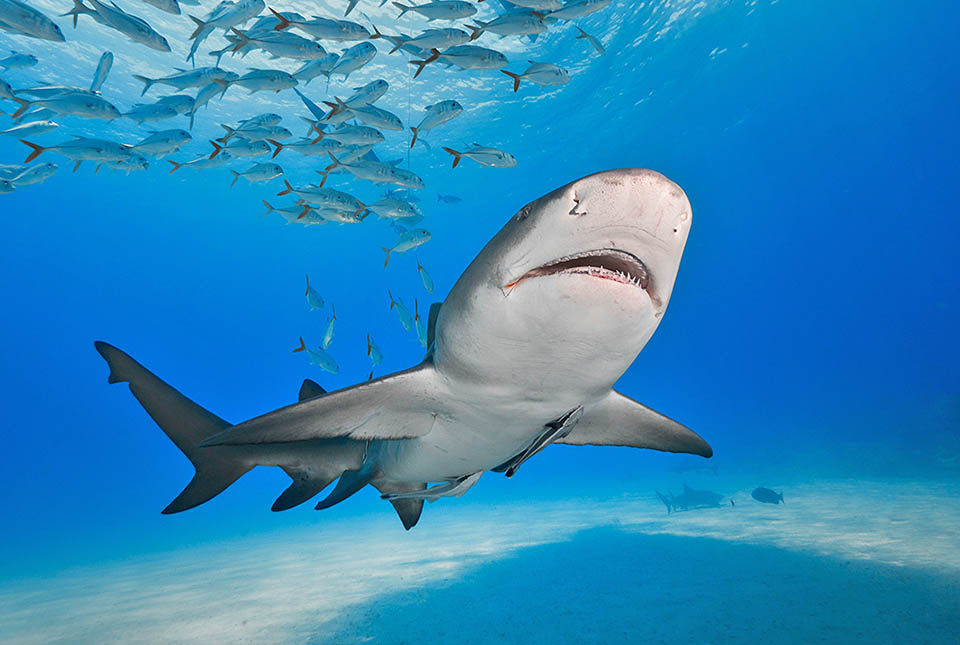
Here the two categories are compared. The school and the two remoras are Osteichthyes, whilst the shark below belongs, with rays and chimaeras to the Chondrichthyes © Rafi Amar
In any case, in the fishes the supporting bones form from originally cartilaginous elements (replacement bones or autostosis); instead, the covering bones, called also cutaneous, or of membrane or of covering (allostosis) form directly from the connective.
Besides classification elements of primary and fundamental importance that diversify the membres of the two groups where are traditionally ascribed all extant fishes, Chondrichthyes and Osteichthyes, the structural features of the skeleton give also valuable information about the habits of these animals; solid and robust in the fastest and most skilful in swimming forms, the skeletal system is conversely thin and slender in those living on the bottom and moving slowly. In the abyssal forms the skeleton may even become very soft.
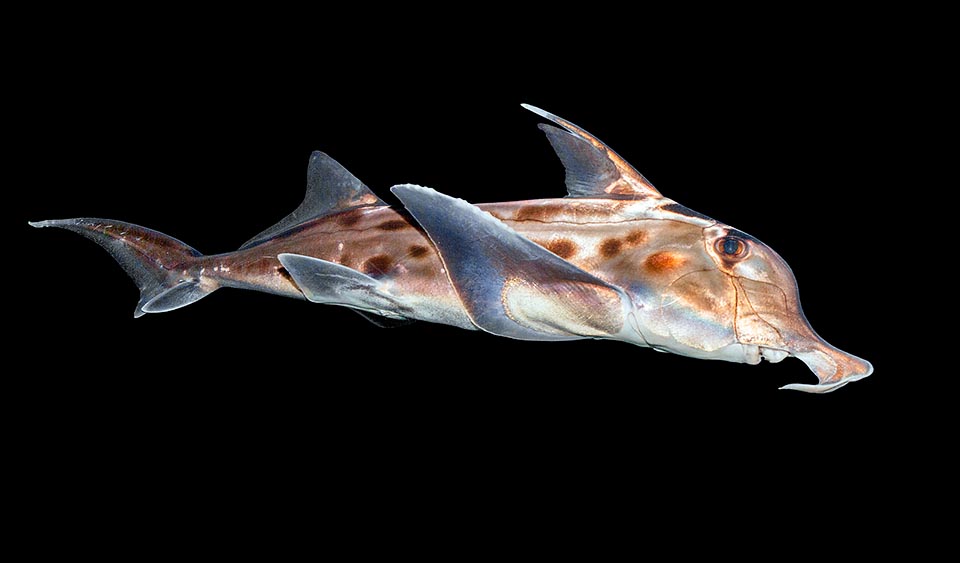
The chimeras are little known cartilaginous fishes, extant fossils of the Paleozoic. Here the Elephant shark (Callorhinchus milii) that may reach the depth of 600 m © Giuseppe Mazza
In almost all cartilaginous fishes (Rajiformes, Elasmobranchia and Chimaeriformes) the skull is a unique cartilaginous capsule, that is, having no sutures (primordial skull); instead, in the Osteichthyes, the capsule undergoes an ossification process ever more pronounced so that the skull in these fishes results formed by a high number of bones , variable from group to group; only some abyssal marine forms, like those of Argyropelecus, depth genus of the family of the Sternoptychidae maintain mainly the cartilaginous structure of the skull and of the backbone.
The vertebrae, whose number varies from 14, like in the Pufferfishes (Tetraodontidae) to more than 100, like in the species of Zoarces (Gadiformes), are typically formed by a vertebral body with a pair of dorsal or neural arches and a pair of ventral or haemal arches.
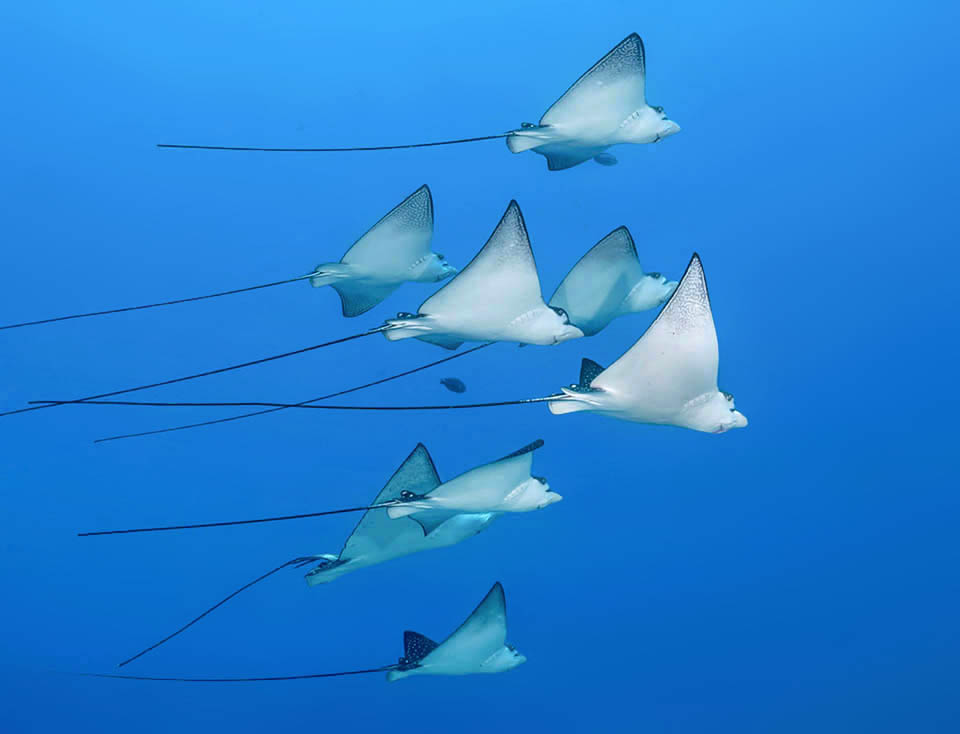
Conversely the rays are much more known, characterized, like Aetobatus ocellatus, by much enlarged pectoral fins and the tail resembling a whip © David Rolla
The dorsal vertebral arches merge forming a duct where the spinal cord runs and above form dorsal spiny processes, or neurospinal.
In their turn, the ventral vertebral arches in the region of the trunk diverge from each other and embrace the viscera; usually in this region each one of these structures presents divided in two portions articulated to each other, one proximal (parapophysis) and one distal with free low apex (rib).
Conversely, in the caudal portion the ventral vertebral arches unite to each other ventrally and form the ventral processes or hemospines, defining with the vertebral bodies a duct where they accommodate caudal arteries and veins.
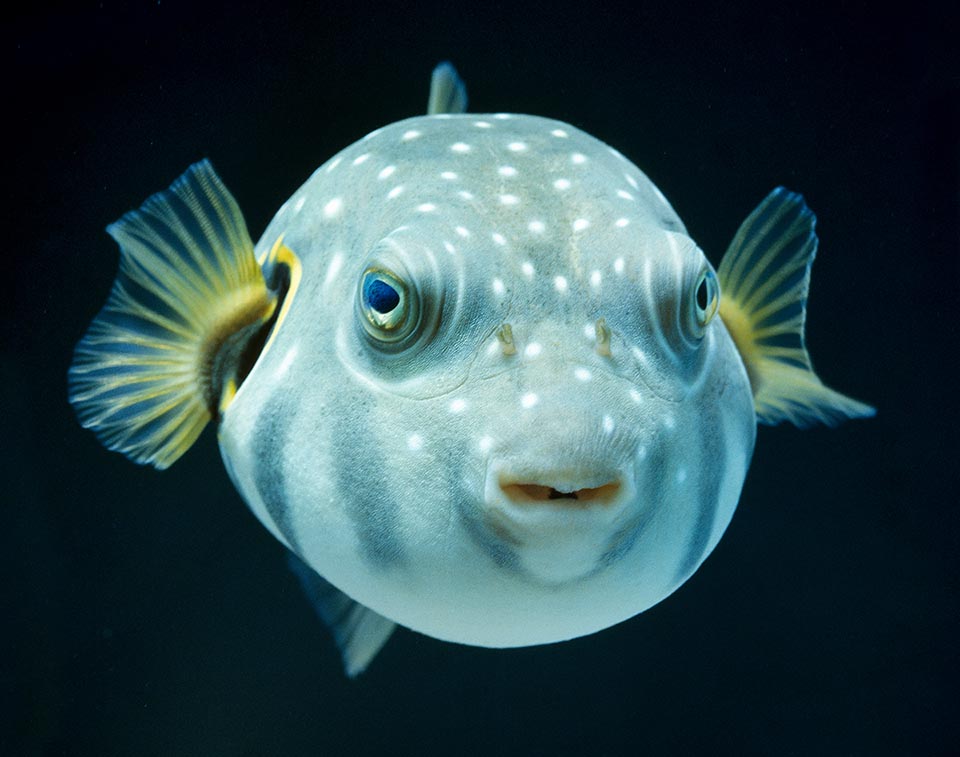
The bony fishes have a quite variable number of vertebrae: only 14 in the puffers, like this Arothron hispidus, and more than 100 in the species of the genus Zoarces © Giuseppe Mazza
Usually in the adults of the Osteichthyes the vertebral column ends in the back with the urostyle, small bone directed dorsally and produced by the fusion of the last vertebrae.
Conversely, in some Lungfishes (Dipnoi) the spine runs straight up to the back extremity of the body.
The Fishes have no sternum.
FINS
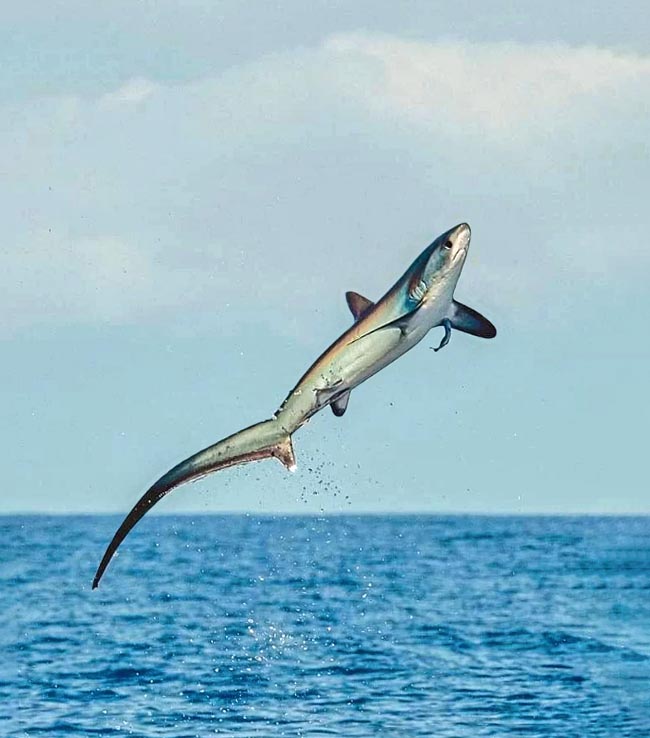
Spectacular leap of Alopias vulpinus that uses the caudal fin for hunting dazing with whips the schools of fishes © Bruce Müller Stevenson
The fishes have particular appendages, the fins, that form the means of movement par excellence in aquatic environments, result of millions of years of adaptations that have given origin to a remarkable variety of forms and of locomotion techniques.
The structure, number development and arrangement of the fins represent characters of fundamental importance for the taxonomy of the fishes.
Structurally, the fins are formed by a fold in the skin sustained by a frame of rays, flexible or rigid, connected by muscles to the attachment of the body.
Position
Referring to their position, the fins are called odd or even.
The odd fins are those implanted in the midline of the body, dorsal and ventral, and are the dorsal, anal and caudal fins. Conversely, the even fins are arranged symmetrically on the sides of the body and are the so-called pectoral, ventral or pelvic fins.
Some species have other additional fins, such as the adipose fin, small fin located behind the dorsal and formed only by a cutaneous duplication, or of small fins, called pinnulae, that stand on the basal peduncle.
The ventral fins stand in various position, on the abdomen, close to the gill openings, on the throat and are completely absent in the eels; in the cartilaginous fishes the central part of the pelvic fins of the male is modified in copulatory organ (missipterygius or pterygopodium).
Structure
In the fishes, the odd fins, dorsal, and caudal are supported by cartilaginous rays (Chondrichthyes) or bony (Osteichthyes) to which add thin filaments. These filaments, in some species of bony fishes, like, for instance, in the Perciformes, are undivided and hence are rigid and sharp. Always in other bony fishes, instead, the filaments are flexible being subdivided in more parts that articulate transversally each other. This situation is met, for instance, in Herrings, Salmons and Carps where at best the first three rays of the dorsal fin are flexible.
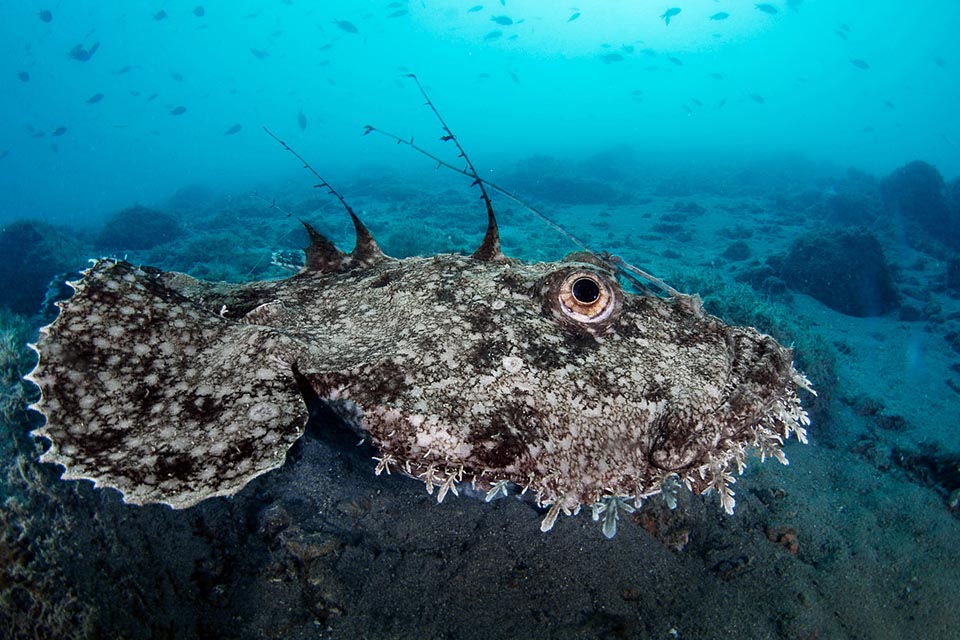
In the Angler (Lophius piscatorius) the first ray of the dorsal fin has transformed in a fishing line, called illicium, with a wattle simulating a vermiform bait © Pietro Formis
In some cases, the rays of the dorsal fin protrude considerably beyond the fin in the form of long spines.
For instance, among the Lophiiformes the well known European angler (Lophius piscatorius Linnaeus 1758), characterizes for the so-called illicium, long spine that originates from the first ray of the dorsal fin at the extremity of which stands a wattle that simulate a worm-like bait.
Always among the Lophiiformes, some abyssal species are equipped as well of an illicium that, however, carries at the extremity a luminescent bait. Among these ones the most known is the so-called Triplewart seadevil (Cryptopsaras couesii Gill,1883).
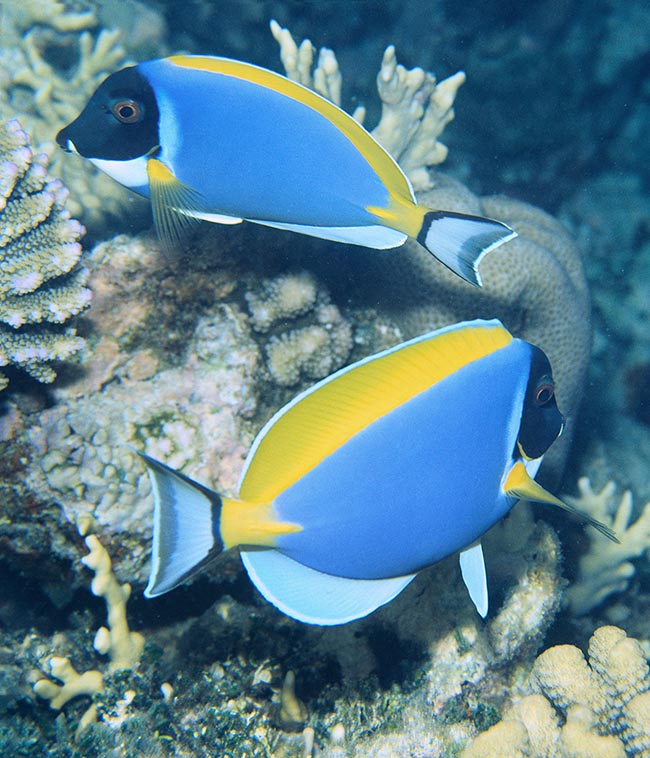
Usually the caudal is the motor of the fishes, but the Acanthurus swim with the pectorals and the dorsal fin is unique © Giuseppe Mazza
Number
The fins of the fishes vary greatly also in number and development.
The dorsal fin can be unique, multiple or continuous along the back; some species, like in the salmons and in the catfishes, whose most common membres are respectively the Atlantic salmon (Salmo salar Linnaeus 1758) and the Black bullhead (Ameiurus melas Rafinesque,1820), besides the single dorsal fin, have also a small fleshy or adipose posterior fin.
In various viviparous species, like, for instance, in the very common Gambusia affinis (Baird e Girard, 1853), the fore part of the anal fin has transformed into a copulatory organ (gonopodium).
The pectoral fins typically install close to the gill openings and have a very varied development.
In the so-called flying fishes or flying cod, family of the Excoetidae, for the marine forms, in the African butterflyfish (Pantodon buchholzi Peters, 1877), for the freshwater ones, the pectoral fins are remarkably developed and allow a gliding flight over the surface of the water.
Even the species of Gasteropelecidae, family of bony fishes living in South American freshwaters, like the Marbled hatchetfish or Carnegiella (Carnegiella strigata Eigenmann, 1909), have small and transparent fins, but the pectoral ones that are well developed and with which they are able to perform leaps out of the water and keep low-flying over the surface for some metres.
The freshwater Cypriniformes of South America seem to be able to make real flights by vibrating quickly their big pectoral fins.
And again, in the species of Periophthalmus, genus of bony fishes of the order of the Perciformes that live in the coastal waters of the tropical regions of the Old World, the pectoral fins, and frequently the ventral ones too, are stretched and modified in structures suitable for walking on land, out of the water.
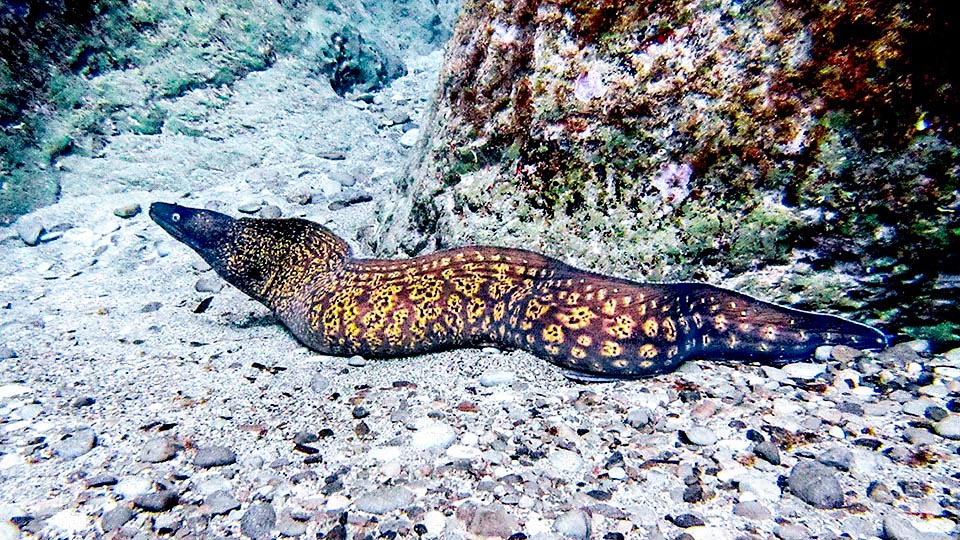
In the moray eels the dorsal merges with the caudal and anal forming, like for the eels, one only fin © Johannes Hallama
Shape
The shape of the caudal fin, to whose constitution intervenes the extremity of the vertebral column, varies remarkably, from squared to falciform, to roundish. Based on the development of the terminal part of the vertebral column and on the development of the lobes of the caudal fin, various types of tail are distinguished.
In the diphycercal tail the vertebral column is straight and reaches the extremity of the body and the fin is trilobate and develops symmetrically over and under it, decreasing and ending in a point, like in the Dipnoi whose most known example is represented by the West Indian Ocean coelacanth (Latimeria chalumnae Smith, 1939).
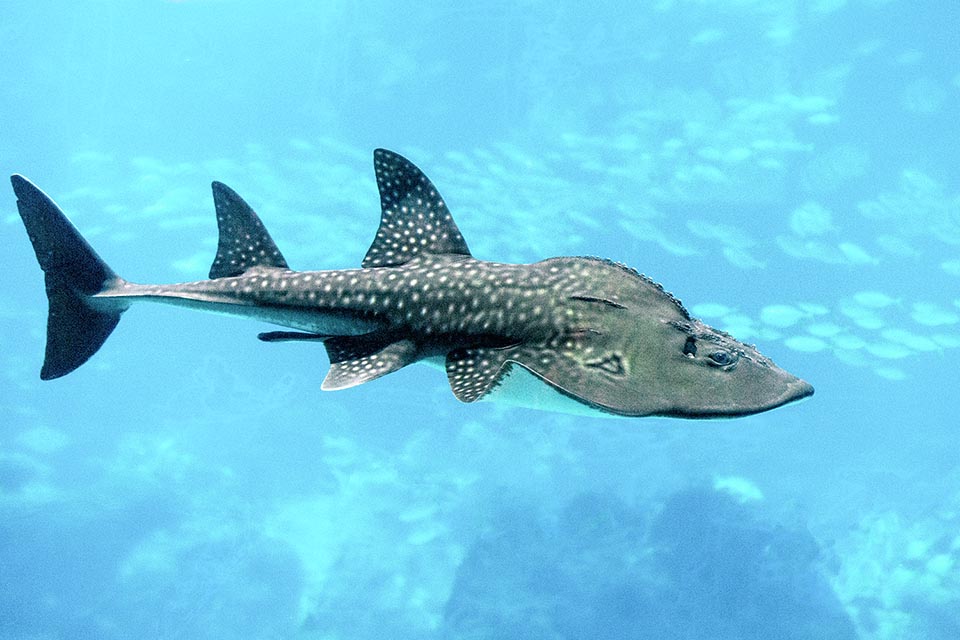
Rhina ancylostoma is cartilaginous fish classified as “Critically Endangered” in the IUCN Red List with characters intermediate between sharks and rays. From these it has inherited the big pectoral fins. It has two dorsal and two pelvic ones ending in this male with pterygopoda used in mating. The caudal fin is heterocercal © Giuseppe Mazza
Otherwise, in the heterocercal tail terminal part of the vertebral column bends obliquely upwards and is contained within the major lobe of the fin that, due to the presence of a small ventral lobe, appears markedly asymmetrical (Elasmobranchia and Acipenseriformes).
The homocercal tail that characterizes many Osteichthyes presents the axis of the vertebral column that on the back bends upwards as in the heterocercal tail but, unlike this, externally it appears symmetric because the two lobes of the caudal fin are equally developed.
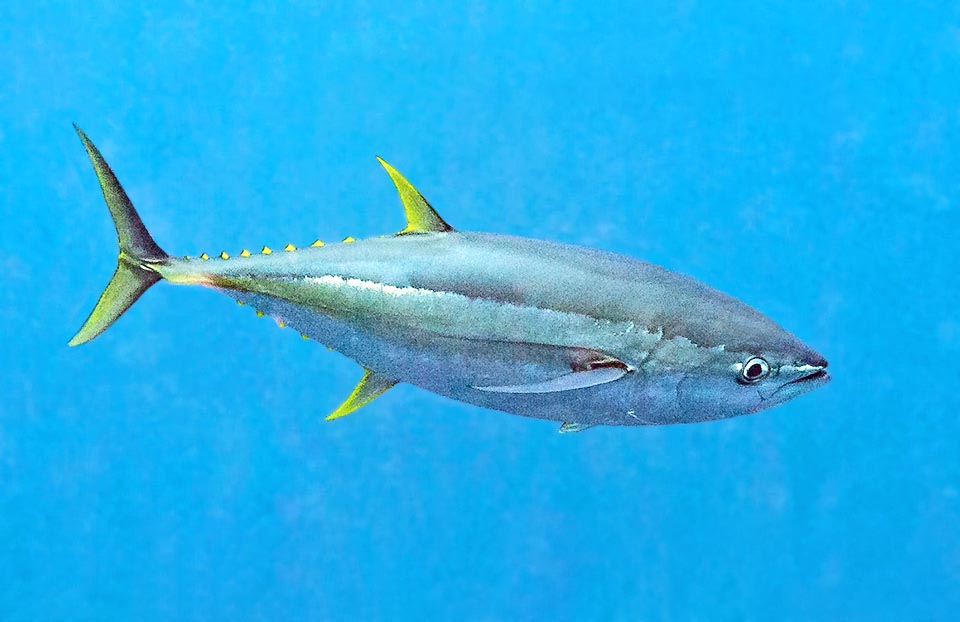
Some species, like the tuna, have on the peduncle a characteristic series of small fins, called pinnulas © Allison & Carlos Estape
Function
Usually in the Fishes each fin is responsible for a certain type of movement.
The ventral fins perform the function of rudders, the caudal produces the forwards thrust, whilst the pectoral, the dorsal and the anal ones are stabilizers. The pectoral fins allow also the backwards movements. The majority of fishes swim by means of lateral undulations of the body and of the tail caused by alternating contractions of appropriate muscles.
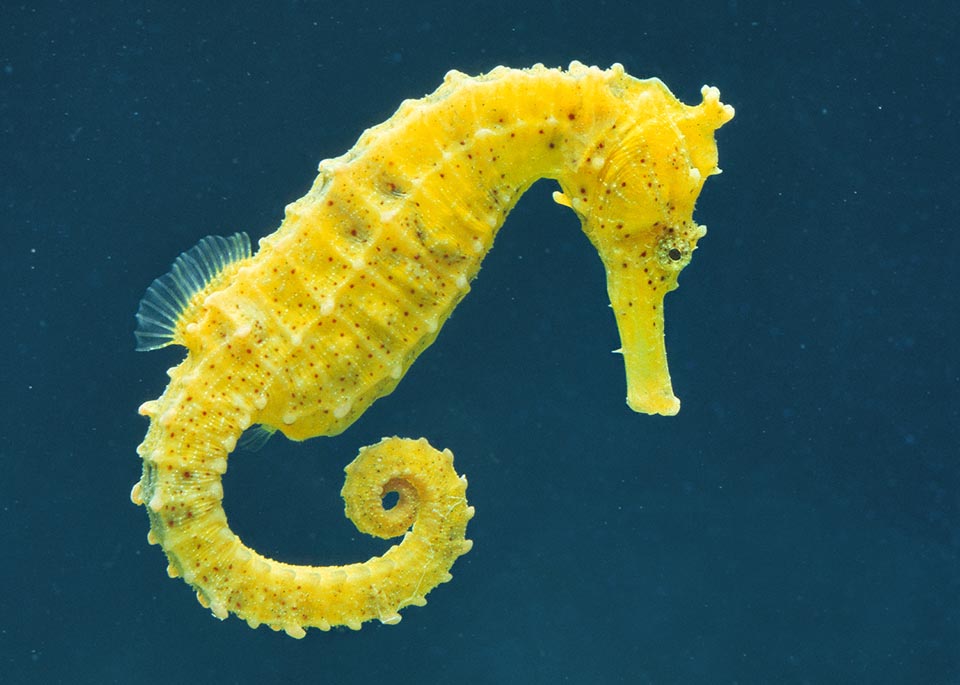
Swimming Hippocampus kuda. Here the motor is the dorsal fin, helped by the pectorals © Giuseppe Mazza
Conversely, in various species the tail and the caudal fin do not form the normal means of propulsion, like the hippocampi or sea horses (Hippocampus) that move by means of undulations of the dorsal and pectoral fins and the surgeonfishes of the family of the Acanthurids (Acanthuridae) that swim rowing with the pectoral fins.
As already previously mentioned, in the species of the genus Periophthalmus, Gobiid fishes (Gobiidae) commonly known with the name of Mudskippers, the pectoral fins, and often the ventral ones too, are long and modified in structures that allow the movements on land, out of the water.
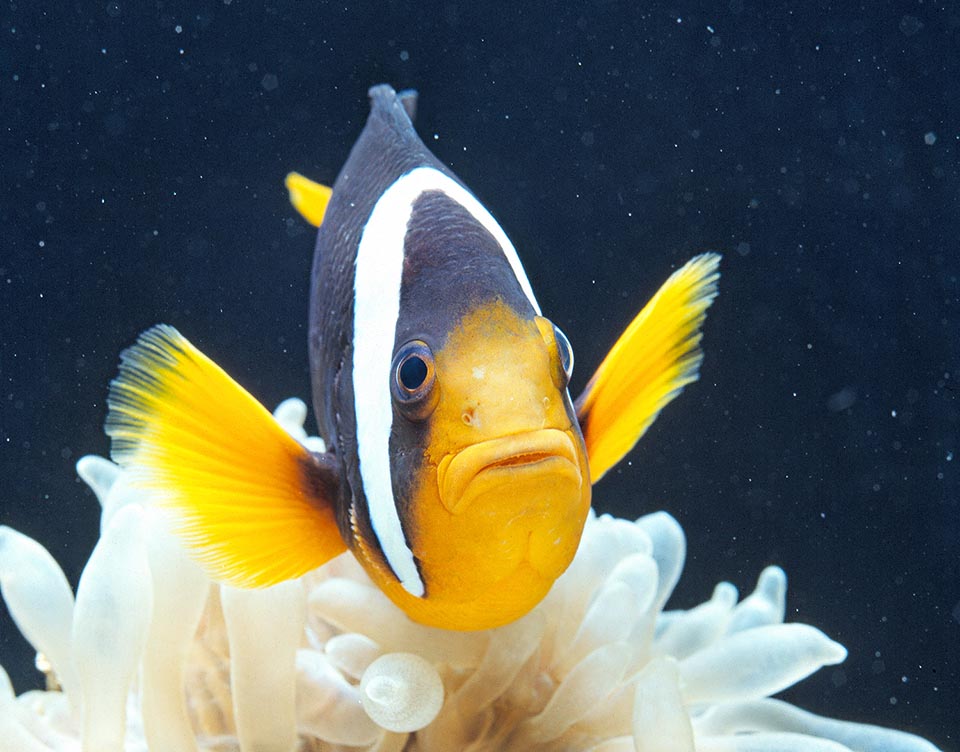
Amphiprion clarkii. The pectorals, besides stabilizing the trim of the fish, serve also for the reverse © Giuseppe Mazza
NERVOUS SYSTEM
The nervous system is formed by the encephalon, the spinal cord and by the nerves.
The encephalon is long, poor in convolutions and originates 12 pairs of cerebral nerves that innervate the sensory organs of the head and its musculature; it is typically formed by 5 parts: telencephalon, diencephalon, mesencephalon, metencephalon and myelencephalon, or medulla oblongata that continues with the spinal cord. The telencephalon is particularly developed in the Chondrichthyes and in the Dipnoi; it consists of two hemispheres whose separation is clearer in the Osteichthyes.
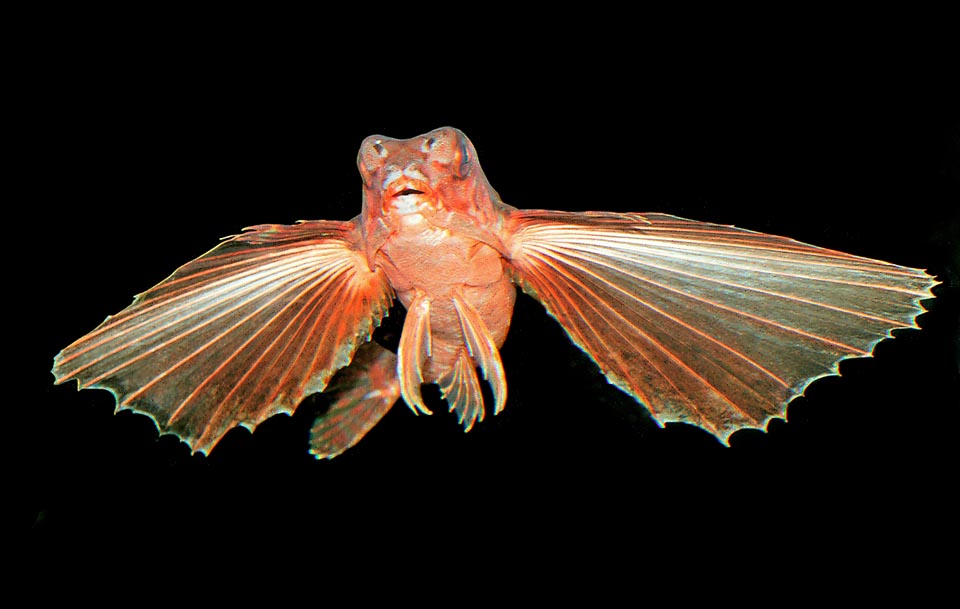
This Dactylopterus volitans looks like a flying bat, but its big pectorals allow only long glides on the bottoms © Giuseppe Mazza
From the spinal cord, enclosed by the neural arches, originate even nerves provided with a ventral motor root and with a dorsal sensorial; in turn, these connect with two thin nervous cords that run below the column and that form the sympathetic nervous system.
RESPIRATORY SYSTEM
The respiratory activity is usually ensured by the inner gills, thin lamellae richly vascularized, placed in suitable branchial pouches; these are located close to the oesophagus and communicate with outside by means of the gill openings, placed behind the head and in number varying from 1 to 7, depending on the groups.
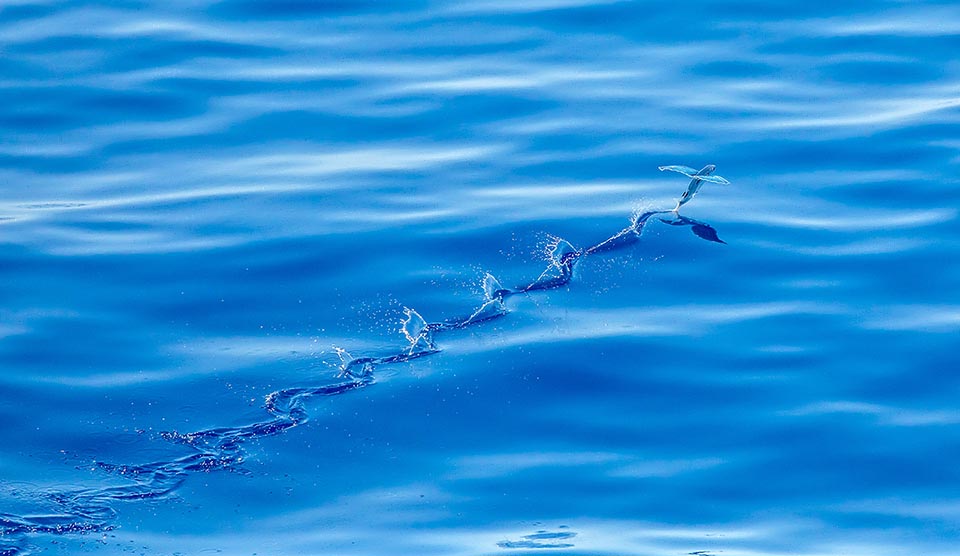
However, there are also some flying fishes, rightly called sea swallows, grouped in the family of the Exocoetidae, that are able to hover over the waves for 20-30 seconds, exceptionally, 45. Some are called two winged like this one who is taking off with the pectorals fins flattened in Indian Ocean off Western Australia coast © Harold Moses
In the Cartilaginous fishes the first gill slit forms a spiracle.
In the Bony fishes, the gills are allocated inside a common chamber situated on each side of the body and protected by a sort of cover, the operculum.
During the respiration process, the water enters the mouth and hence, through the pharynx, reaches the branchial pouches; here takes place the exchange between the oxygen dissolved in the water and the carbon dioxide contained in the blood flowing in the very numerous vessels of the branchial lamellae.
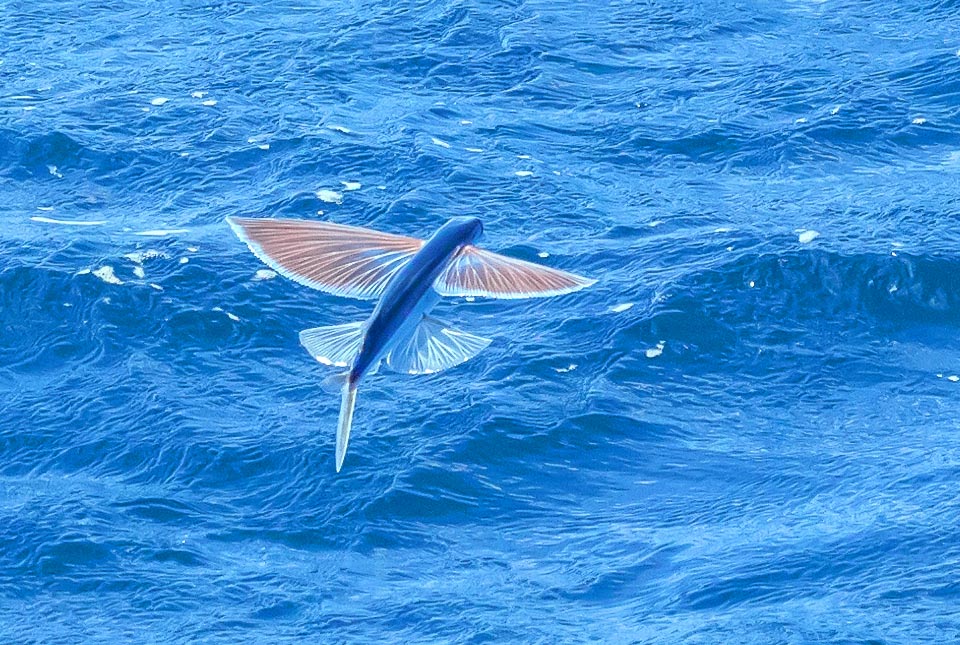
Conversely, this, in the North Atlantic Ocean near the Cape Verde islands, is a 4 winged flying fish, who flattens also the ventrals, small, but equally bearing © Harold Moses
Some fishes living in poorly oxygenated waters, like those low and putrid, are able to spend more or less short periods of time on the mainland breathing also in the air; others are equipped with supplementary respiratory organs.
Actually, several freshwater species living in the tropical regions, such as the Channiformes and several Perciformes, like Blenniidae (Blennius), Gobiidae (Periophthalmus), Anabantidae (Anabas, Ctenopoma), have more or less freed themselves from the branchial respiration and succeed to go to the mainland and to breathe atmospheric air thanks to an organ which, because of its particular shape, is called labyrinth; it is a sack-shaped structure located inside the gill cavity, above the gill arches, and provided with numerous lamellae covered by a thin membrane richly supplied by numerous blood vessels through which the direct gaseous exchange takes place.
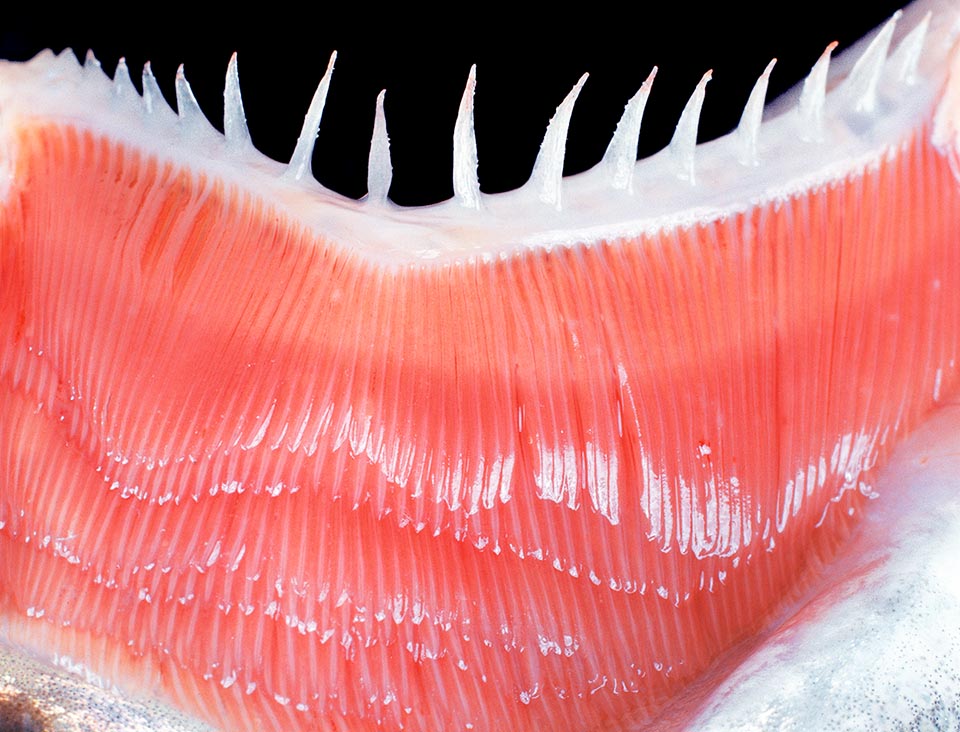
Gills of a trout. Protected by an operculum in the bony fishes they allow the exchange between the oxygen dissolved in the water and the carbon dioxide contained in the blood. Above we note a “gill rake”, structure born with protective functions then transformed over time in a filtre for the species nourishing of plankton © Giuseppe Mazza
And yet the species of Clarias, genus of Siluriformes living in the African freshwaters, they too are able to move on the mainland to go in search of a new spring when their own has dried up; this is possible thanks to accessory respiratory organs formed by ramified appendages of one or two branchial arches allowing them to utilize directly the oxygen from the atmosphere.
Other fishes like the eels complete the branchial respiration with cutaneous gaseous exchanges by means of a sort of intestinal respiration. It must be remembered that in the Sarcoterygii, a class of Bony fishes characterized by fleshy fins, the swim bladder works also as a lung.
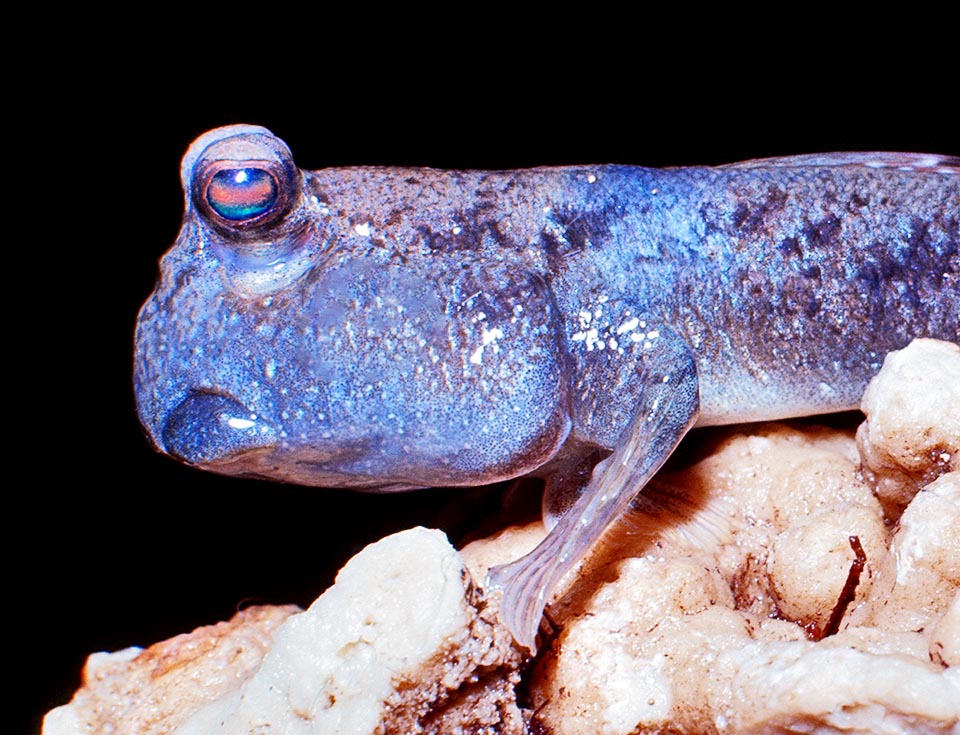
In the Periophthalmus the pectorals have transformed in legs and can breathe the air thanks an organ that, due to its particular shape, is called labyrinth © Giuseppe Mazza
And again, in the Actinopterygii, class to which are ascribed most of the extant Bony fishes and whose main characteristic is that of having the fins supported by rays, it is to be remembered the Bowfin (Amia calva , Linnaeus, 1766), only extant member of the order of the Amiiformes.
This fish, widespread in the north-eastern America freshwaters, when finds itself in swampy environments poor in oxygen, goes up to the surface and stores atmospheric air in the swim bladder where occur the gaseous exchanges with a mechanism practically analogous to that of the lung-breathing vertebrates.
CIRCULATORY SYSTEM
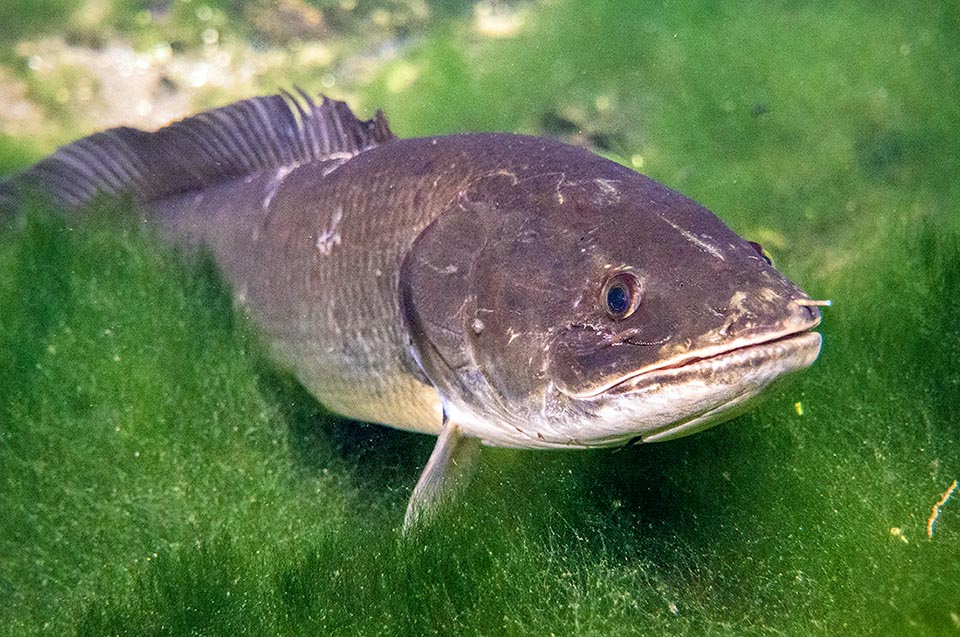
In swampy environments poor in oxygen of North-East America, Amia calva breathes storing the atmospheric air into swim bladder that thus acts as lung © Phil’s 1stPix
In the fishes the circulation of the blood is closed and of simple type. The heart, enveloped by the pericardium like all Vertebrates, is located dorsally to the branchial arches and is separated from the abdominal cavity by a diaphragm; usually it consists of only one atrium, or auricle, and of only one ventricle both connected by cardiac valves.
In the Dipnoi, subclass of bony fishes Sarcopterygii whose members are also known as Lungfishes (or Coanoitti), the atrium is divided in two chambers by a septum, thereby preventing the venous blood coming from the liver mixes up with the arterial blood coming from the lungs.
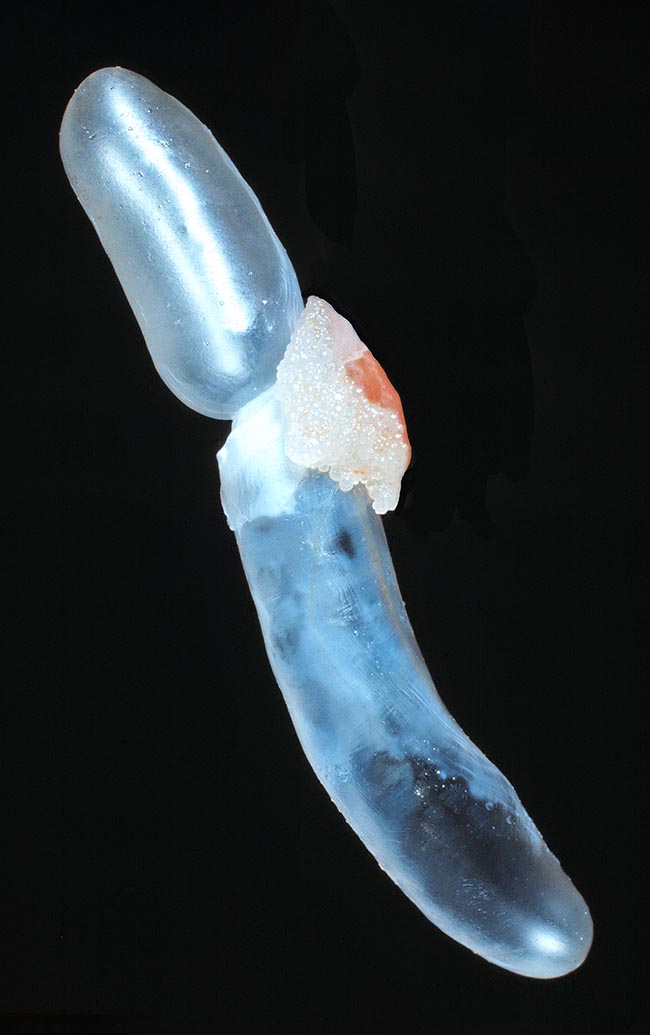
Here is the swim bladder of an Alborella (Alburnus arborella) formed by two bags full of gas. Usually it serves, by filling or emptying, to keep specific gravity of the fish neutral depending on the depth of water © Giuseppe Mazza
Under the pressure of the heart, through the ascending branch of the aortic arch, the venous blood, loaded of the carbon dioxide resulting from the cellular activities of the tissues, reaches the gills where it releases the carbon dioxide and binds with the oxygen thus becoming arterial.
From here it continues its way and, without passing by the heart, reaches through the capillaries all the organs to whose cells it provides the oxygen necessary for their metabolic processes, withdrawing in exchange the carbon dioxide produced; then the blood gets back to the atrium and starts its own cycle again.
The arteries with the oxygenated blood run dorsally, whilst the veins that carry the blood rich in carbon dioxide are ventral.
The total volume of the blood is relatively modest and its oxygen uptake capacity is rather contained.
The red blood cells (erythrocytes) are fewer in number than that of the remaining Vertebrates but their dimensions are higher.
The quantity of haemoglobin contained by them varies greatly from species to species and usually is higher in the more active species or those living in poorly oxygenated waters.
Unique case among all vertebrate fishes is that of Chaenocephalus aceratus (Lonnberg, 1906), species of the family Channichthyidae, among the few able to live in the cold waters of the Antarctic seas.
Commonly known with the name of Crocodile fish due to its big mouth armed with teeth, this animal is also called Blackfin icefish as having transparent blood as devoid of red blood cells and of hemoglobin.
On the other hand the Blackfin icefish is provided with a particularly developed cardiovascular system and quite comparable to that of a mammal.
The breathing of this so particular fish is linked to the fact that in very cold waters the oxygen is more soluble and consequently can be absorbed more easily by the blood of the gills; moreover this animal makes also an important complementary respiration through the skin that has no scales and is run by a thick net of capillaries.
DIGESTIVE SYSTEM
After the buccal cavity, the digestive system continues with a fairly large pharynx followed by an oesophagus, short and provided of robust muscles.
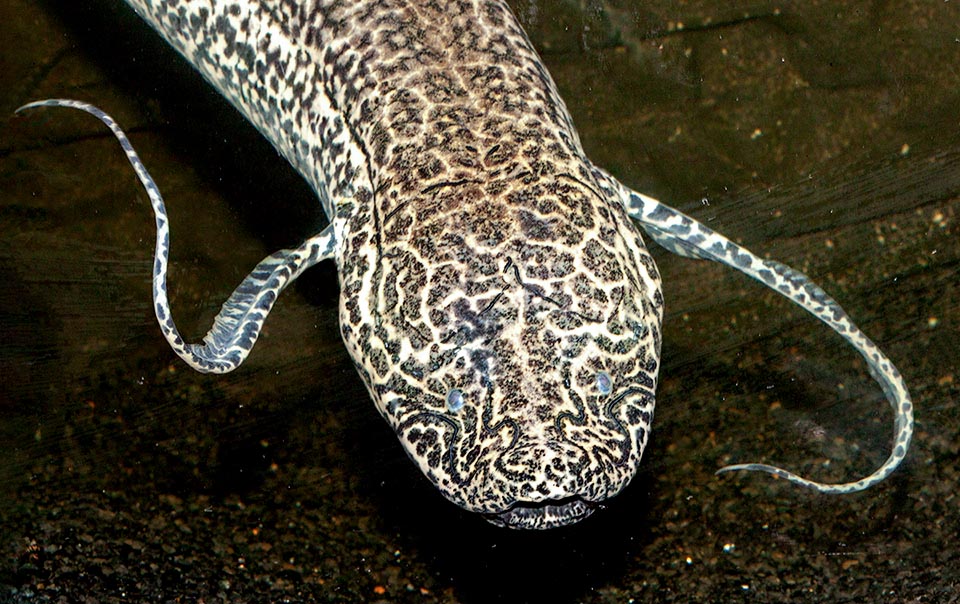
Protopterus annectens has a primitive lung allowing to breath air while buried in the muddy bed of the dry rivers, in a lethargy that may last even 4 years © Giuseppe Mazza
In its turn the oesophagus communicates directly with the stomach, tubular and blind-bottomed, that assumes the function of masticatory stomach and that continues with a long small intestine, usually more developed in the species nourishing of vegetables.
In the cartilaginous fishes and in several bony fishes the small intestine presents an internal helical fold (spiral valve) that increases its absorbing surface.
The small intestine completes the digestive apparatus with a short large intestine that gets out with the anal opening that is always located in the lower part of the body; its position is fairly various and in some forms, like in the Gymnotidae (Cypriniformes), is placed in an anterior position.
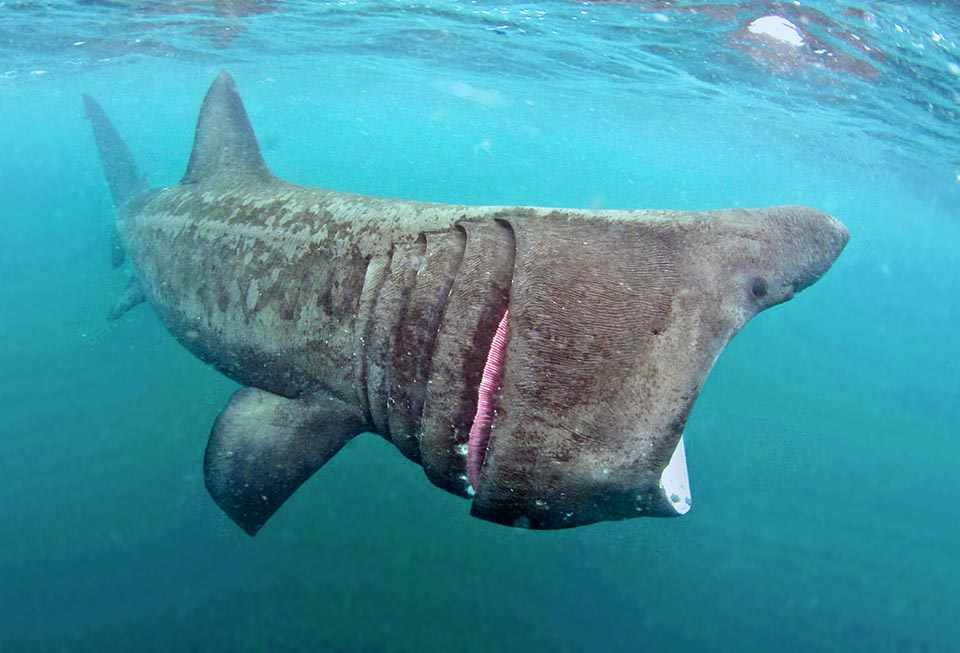
The sharks do not have the swim bladder but have a liver rich in oil that helps floating. In the Cetorhinus maximus it is huge, about the 15/20% of its total weight © Christine Roberts
Elasmobranchia, among the cartilaginous fishes, and Dipnoi, among the bony fishes, are equipped with a cloaca, opening where also the ducts of the gonads converge. Usually the liver of the fishes is well developed and rich in fats; it is provided with gall bladder and frequently differentiates pancreatic lobules (intrahepatic pancreas). In several species the pancreas forms a distinct gland.
SWIM BLADDER
Except the cartilaginous fishes and the Pleuronectiformes among the bony fishes, almost all fishes are equipped with swim bladder or pneumatocyst. This is an organ shaped like a sack formed by an extroversion of the dorsal wall of the oesophagus on which inner walls are located the so-called red body glands that produce oxygen.
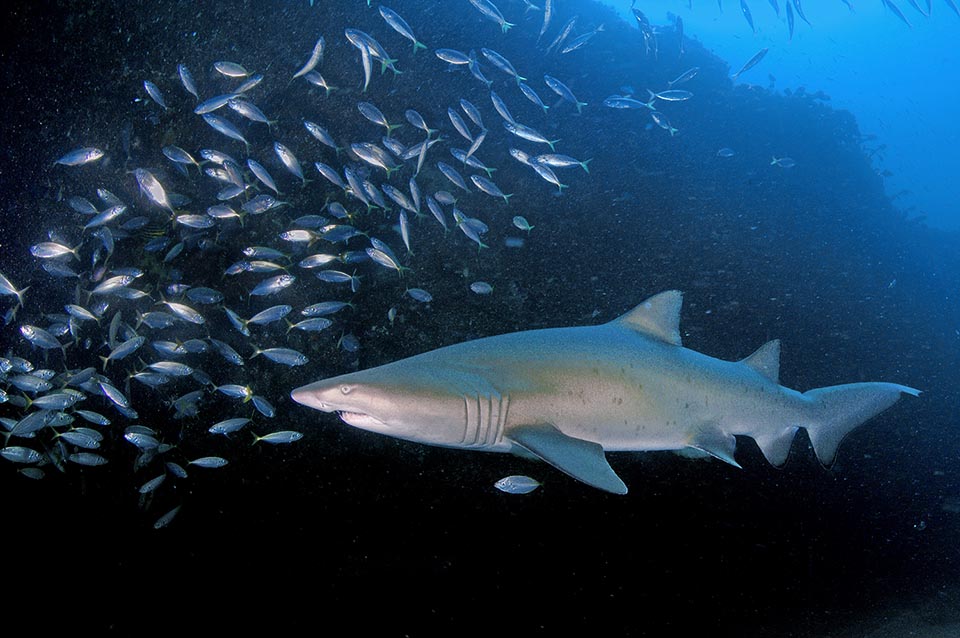
To stay neutral, motionless in mid water, Carcharias taurus swallows even often air in the stomach © Klaus Stiefe
The swim bladder carries on mainly the function of hydrostatic apparatus; in fact, the fishes may reach the desired depth by modifying the contents in gas contained in the same (oxygen, carbon dioxide, nitrogen).
The swim bladder can form a unique cavity or present narrowings tha subdivide it in several successive chambers.
On the so-called Physostomes (Siluriformes, Cypriniformes, Clupeiformes, and others) the swim bladder is permanently connected with the intestine through the pneumatic duct, whist in the Physoclists, such as Gadiformes and Percopsiformes, it loses any connection with the achievement of the adult stage.
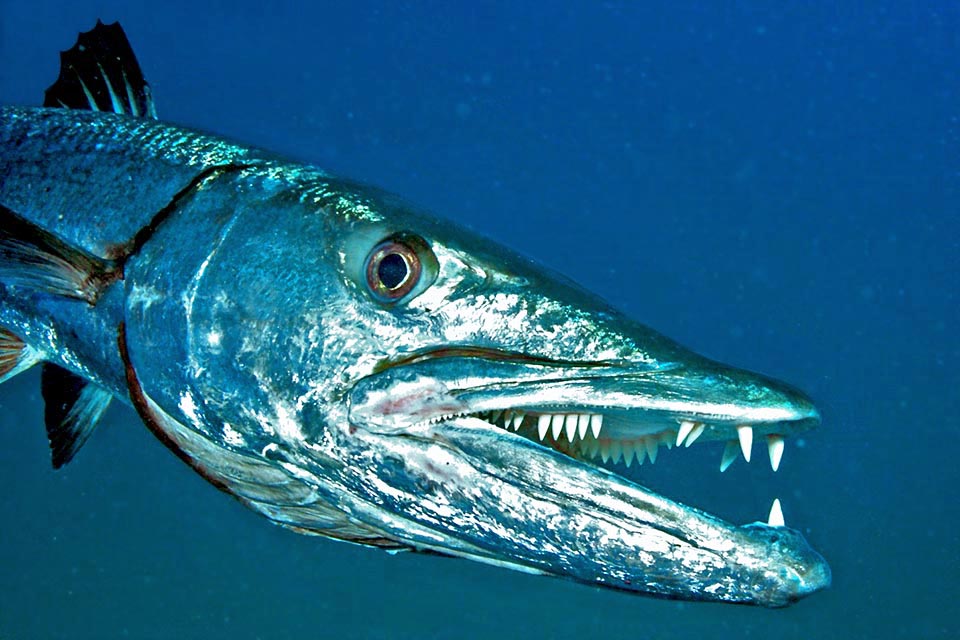
Sphyraena barracuda. The digestive system of carnivores, who gulp preys in big pieces or whole, foresees a capacious stomach, at times dilatable like the Aulostomus who swallow even fishes of their size. But some species, such as the hippocampi, do not have stomach and to survive must therefore eat zooplankton almost non-stop © Allison & Carlos Estapel
In some fishes, as in those of the genus Polypterus, the swim bladder is equipped with a couple of pneumatic ducts, whilst in various Clupeiformes exists an additional duct opening outside behind the anus.
Yet, in some forms, like in the Cypriniformes, the swim bladder is connected by means of a chain of small bones (Weberian apparatus) with the labyrinth; in this way the vibrations of its walls caused by underwater sound waves, as well as gas pressure changes in its interior, are transmitted to the organ of hearing.
Also it is to be remembered that in the Dipnoi and in other fishes the swim bladder also carries on the function of the lungs.
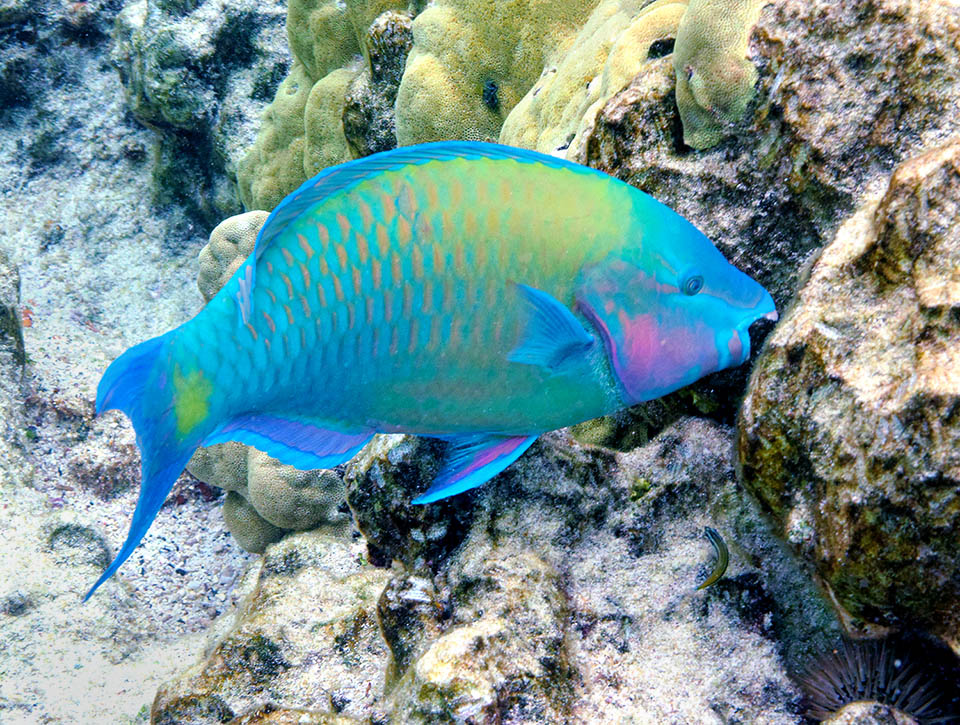
In the herbivores like for instance the parrotfishes, that nourish like this Scarus psittacus of algae, is instead important to have a long intestine © Kris Bruland
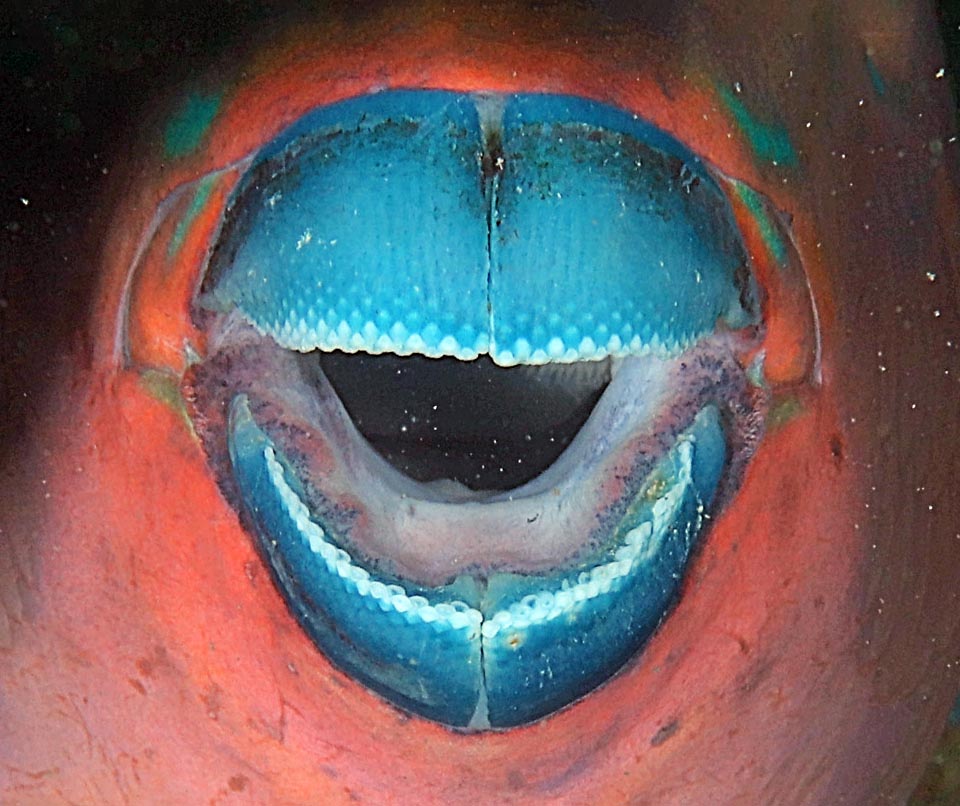
Like in Scarus guacamaia their teeth has adapted transforming in a beak for scraping the rocks and cut like with scissors the infesting filamentous algae © Kevin Bryant
EXCRETORY SYSTEM
The excretory system is formed by two primitive kidneys, called mesonephros or Wolffian duct; these are lobate thinned out organs of dark colour placed on both sides, immediately under the spine.
Each excretory organ is equipped with a tubular ureter that opens in an urinary bladder that in turn empties out through the urogenital sinus.
As well as through the kidneys, the liquid nitrogenous catabolites (urea, ammonia), are spread outward also via the gills.
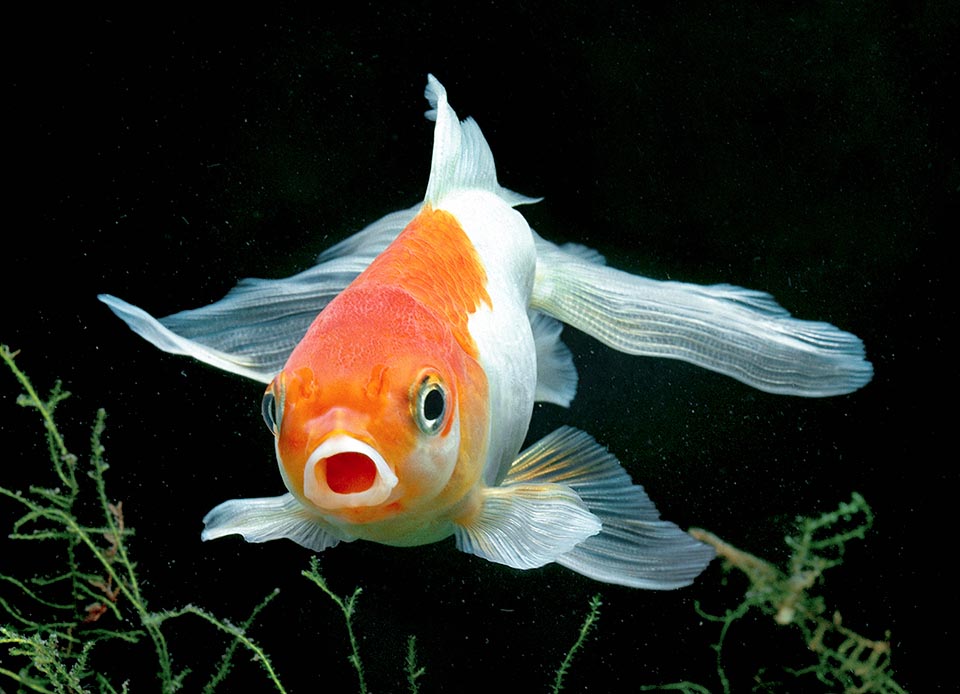
In addition to purifying blood, kidneys make adjustments to the osmotic balance of body. The Goldfish (Carassius auratus) that lives in freshwater in this way emits diluted urine so as not to reduce the salts present in the blood and in the tissues, whilst the marine fishes having a salt concentration lower than the sea emit little very salty urine © Giuseppe Mazza
Besides blood purification, the kidneys also provide for the regulation of the body’s osmotic balance. In fact, most of the fishes are stenohaline, that is able to tolerate only small variations of the salt concentration of the waters where they do live hence their diffusion is limited either to the sea or to fresh waters.
For the marine species, considering the fact that the concentration of salts of their blood and of their tissues is lower than that of the sea, the need arises to limit the loss of water and in meantime of preventing an excessive accumulation of salts. Consequently, in the animals the process of dehydration is balanced by the ingestion of huge quantities of water and by the elimination through the kidneys, the gills and other parts of the body of the salts exceedingly assumed; in particular the urines are excreted in small quantities and at high concentration.

Then there are fishes, called euryhaline, adapting to the two environments like Acanthurus nigricauda of tropical Indo-Pacific, present also, not rarely, in brackish waters © Giuseppe Mazza
In the freshwater species, it takes place exactly the contrary, as the salt contents of the blood and of the tissues is decidedly higher than that of the waters where they live and therefore they take water through the gills and the mucous membrane of the mouth and of the pharynx.
The excess water is eliminated by the kidneys with a remarkable production of diluted urine.
Some species of salt water as well as of fresh water, in particular the euryhaline forms (that is, able to tolerate long changes of the salt concentration of the water), have the gills equipped with cells specialized for the assumption or the elimination of chlorides.
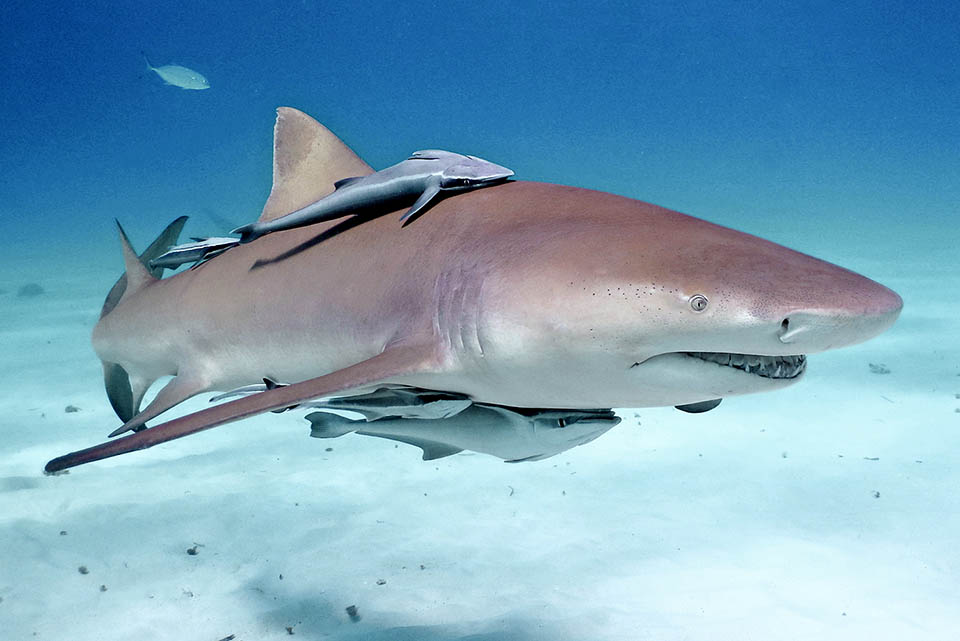
Also among cartilaginous fishes stand species like Negaprion brevirostris that go up the river mouths looking for preys © Michael Eisenbart
Many fishes, usually for reproductive needs, are adapted biologically to pass in various stages of their vital cycle from the sea environment to that of freshwater, or vice versa.
Salmons, lampreys, sturgeons, twait shads and other species more, when the time of reproduction comes, leave the marine waters where they spend most of their cycle and go up the rivers where they will spawn (anadromous forms).
Conversely, the eels go downstream in order to reach the marine waters where they reproduce (catadromous forms).
REPRODUCTIVE SYSTEM
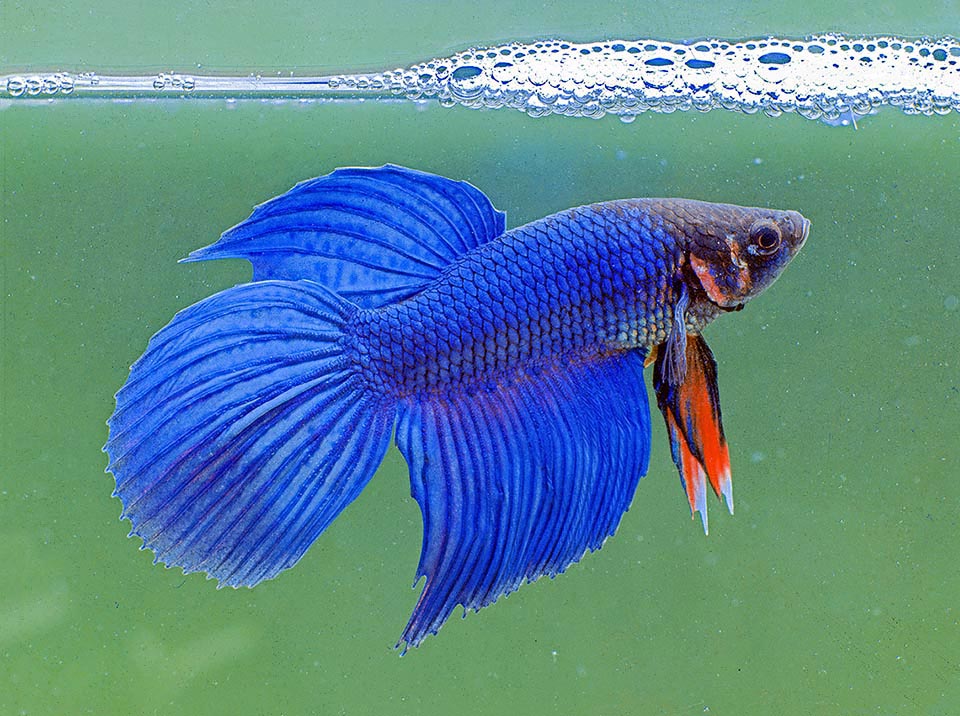
To attract the partner and reproduce, the males of Betta splendens build a floating nest of bubbles © Giuseppe Mazza
Almost all fishes are animals with separate sexes (gonochoric) and are usually characterized by a marked sexual dimorphism, permanent at times, and sometimes limited to the reproductive time only.
In some cases the difference between the two sexes is remarkable, like in the species of the genus Ceratias, and in other members of the order Lophiiformes, where the females are rather big, even up to 1 m long, whilst the males are very small and live stuck like parasites on the body of their partners.
During the season of reproduction some species get secondary sexual characteristics particularly evident like the different colouration or the nuptial livery of the male, the enlargement of the fins (ornamental fins), the appearance of particular skin growths.
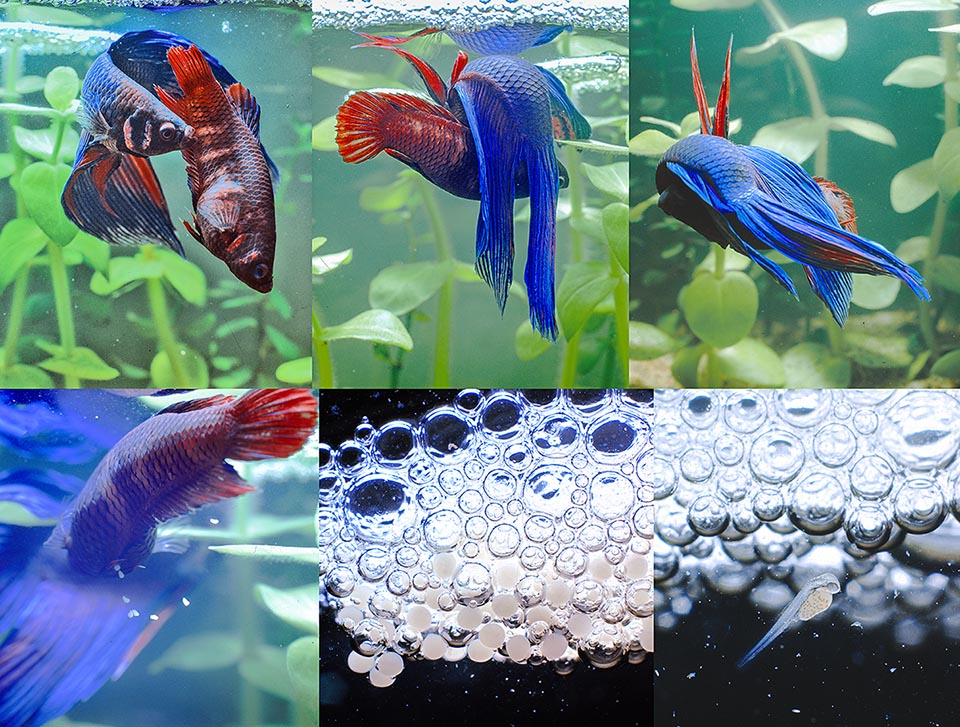
Then mating occurs with the deposition of the eggs. The male takes them in the nest and watches them, attacking even if the female gets close, up to the birth of the fry © Giuseppe Mazza
The gonads are usually even, rarely merged in one unique container, and are allocated in the celomatic cavity, on the sides of the spine.
In some fishes, like the lungfishes (Dipnoi) and cartilaginous, the eggs are issued outside through the Müller duct, part of the primitive ureter, whilst the duty of conveying the sperms towards the eggs is entrusted to a trait of the mesonephros (primitive kidney or body of Wolff) that works as ductus deferens.
Conversely, in most of the Bony fishes, the gonads are equipped with oviducts and deferentia opening together with the ureters in the so-called genital papilla.
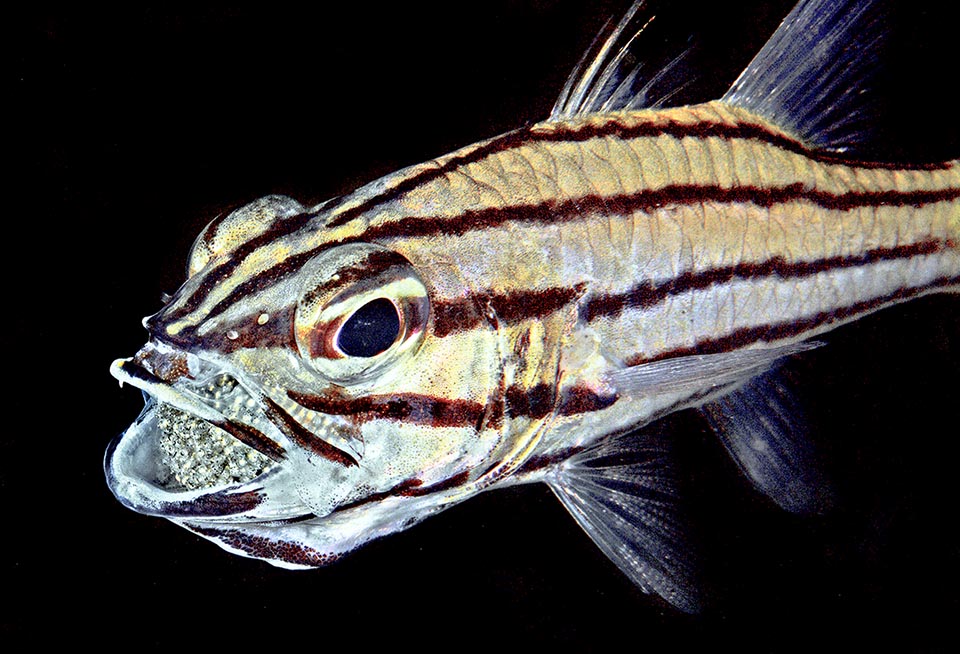
But prudence is never too much and some species, like this Cardinalfish (Cheilodipterus sp.) keep the fecundated eggs in the mouth until hatching © Klaus Stiefel
In the species of the orders Anguilliformes and Salmoniformes the eggs get out through suitable even openings placed posterior to the anus (genital pores). Always in the Osteichthyes, the males of the Rajiformes, and of Elasmobranchia, are equipped with copulatory organs formed by long cartilaginous appendages of the ventral fins; in others, like in some Atheriniformes , the copulatory organ (gonopodium) originates from the transformation of the anal fin or from the elongated genital papilla.
Cases of hermaphroditism, even functional, are not missing, as we can note in the Serranidae. Frequently in the fishes happens the sequential hermaphroditism, that is linked to the sexual inversion; for instance, various Perciformes and Atheriniformes begin their life as females and then they change of sex and continue it as males.
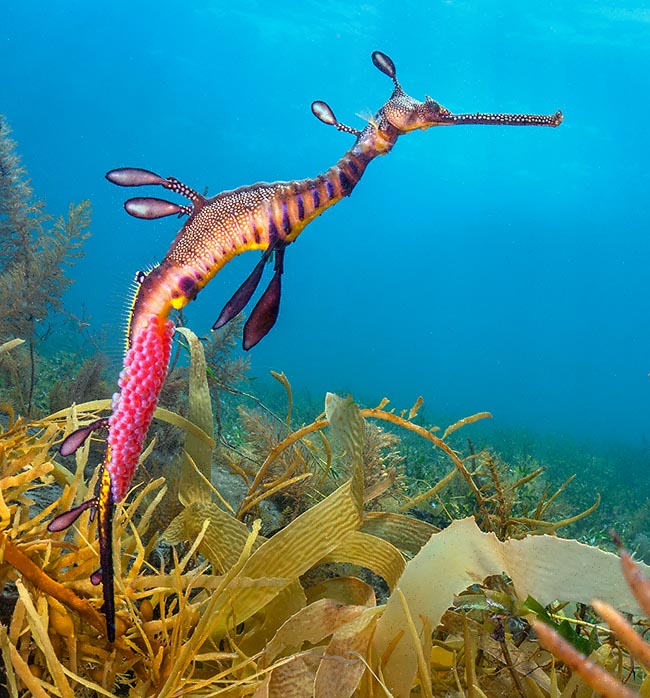
To keep them from predators, the males of Weedy seadragon (Phyllopteryx taeniolatus) walk them until hatching, for about one month, in small cells placed under the tail nourished and oxygenated by father’s blood © Rafi Amar
REPRODUCTION
Usually in the Fishes the reproduction occurs by amphigony, that is by fecundation of the eggs done by the sperms.
But, even if very rare, some cases of parthenogenesis are known, like that of Amazon molly (Poecilia formosa Girad, 1859).
This is a small fish of the fresh waters of South Texas where it is represented by populations formed only by females as well as by mixed populations where the males, however, produce sperms they are unable to fecundate.
In this case the eggs of Amazon molly are able to develop only if they are activated by sperms of other species that obviously limit themselves to penetrate inside them however without fecundating them (interspecific gynogenesis).
The period of the reproduction usually takes place only once in a year, more frequently in spring; some, however, like the salmon, reproduce in winter.
During the mating season, that usually occurs only once in a year, in spring, males and females usually merge in numerous schools and perform migrations, often rather long, and go looking for the most suitable zones where to spawn.
For this purpose it frequently happens that some marine forms move to the fresh waters (anadromous or anadromous forms), whilst others move from the fresh waters to the marine ones (catadromous or thalassotoch forms). As already mentioned, it is well known that the salmons and the sturgeons with the arrival of the reproductive period, abandon the seas and, going up the rivers, reach the tributaries and the secondary water streams; otherwise the eels abandon the rivers to move to the sea, more precisely in the Sargasso Sea in West Atlantic.
Insemination
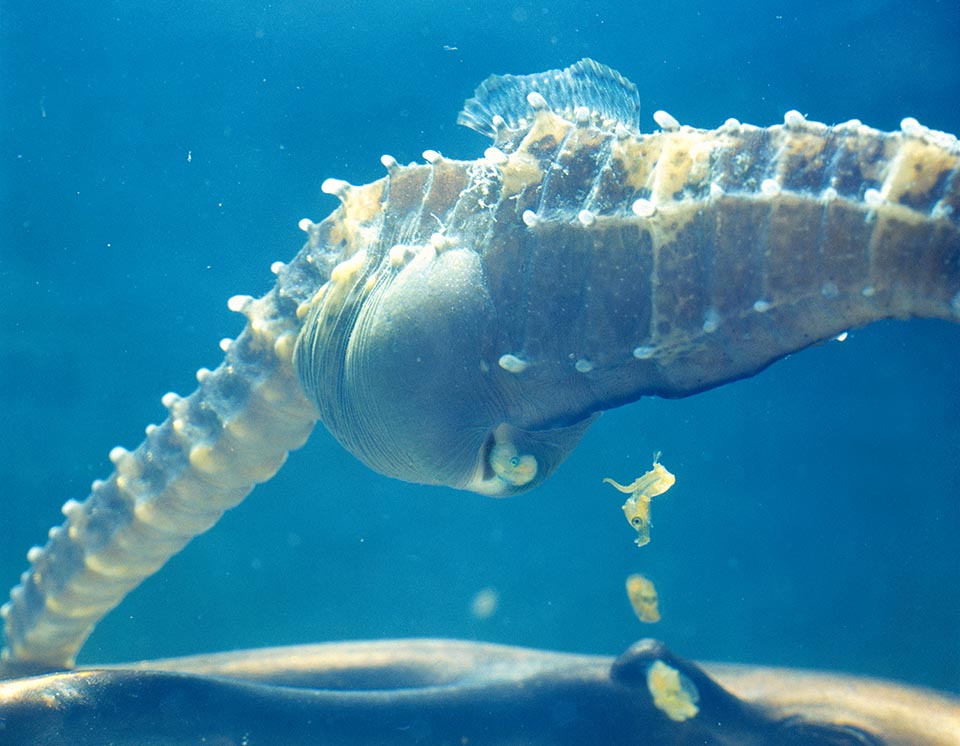
In the seahorses it’s the males who give birth, after having protected in their ventral pouch the incubating eggs © Giuseppe Mazza
In most of the species an external insemination takes place, that is, after a more or less complex love ritual, males and females do not mate but emit respectively spermatozoa and eggs in the water, where the fecundation occurs.
Yet, in several viviparous forms, like various Atheriniformes (spiny dogfish, smooth hammerhead, shark, and others) and several Poecilidae among the Atheriniformes,males and females mate and consequently the fecundation of the eggs and their subsequent development take place inside the maternal body.
Also in other groups, such as Chimaeriformes and Rajiformes, the insemination is internal, but later on the females lay in the outer environment the fecundated eggs; these, in connection with the fact that their development realizes out of the maternal body, are big, as rich in stocked material for the development of the embryo, and covered by a protective shell.
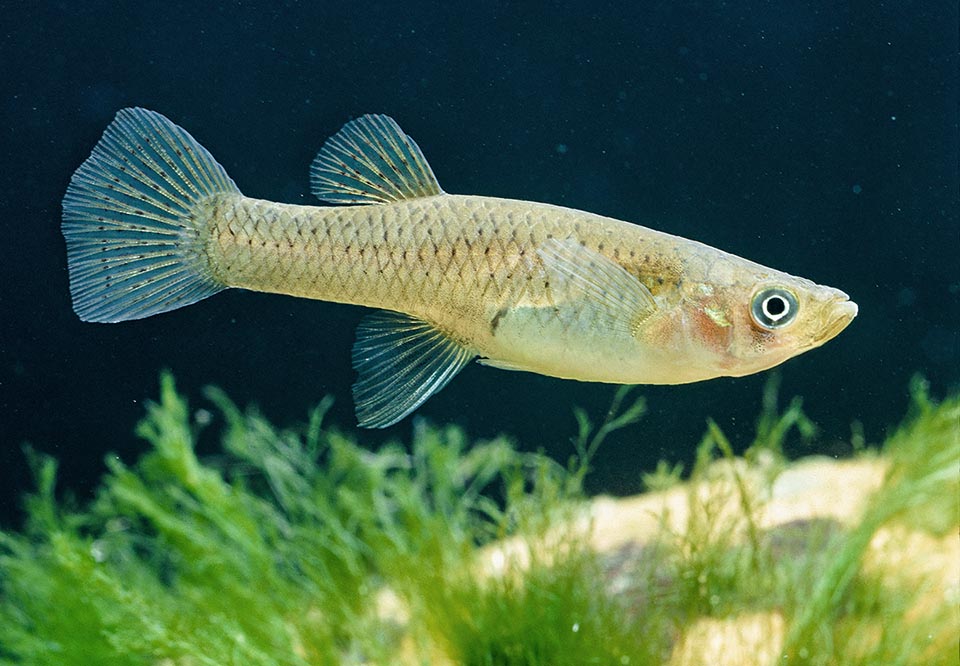
As happens with the sharks, also in small fishes like Gambusia affinis the fecundation is internal and the females generate completely autonomous fry © Giuseppe Mazza
The number of eggs laid varies remarkably from group to group and in several cases it may reach even very high values. Whilst the females of some Elasmobranchia lay just 2 eggs per year, those of the European carp
(Cyprinus carpio Linnaeus, 1758) lay usually from 20 thousand to 70 thousand eggs, the Sturgeons’ ones reach the 6 million, those of the Cod almost 7 million; it seems that the female of the Ling (Molva molva Linnaeus, 1758) , North Atlantic Gadiformes comes to lay on average more than 60 million of eggs.
Oviposition
Particularly various is the behaviour of the fishes about the oviposition. The most curious examples are listed here below.
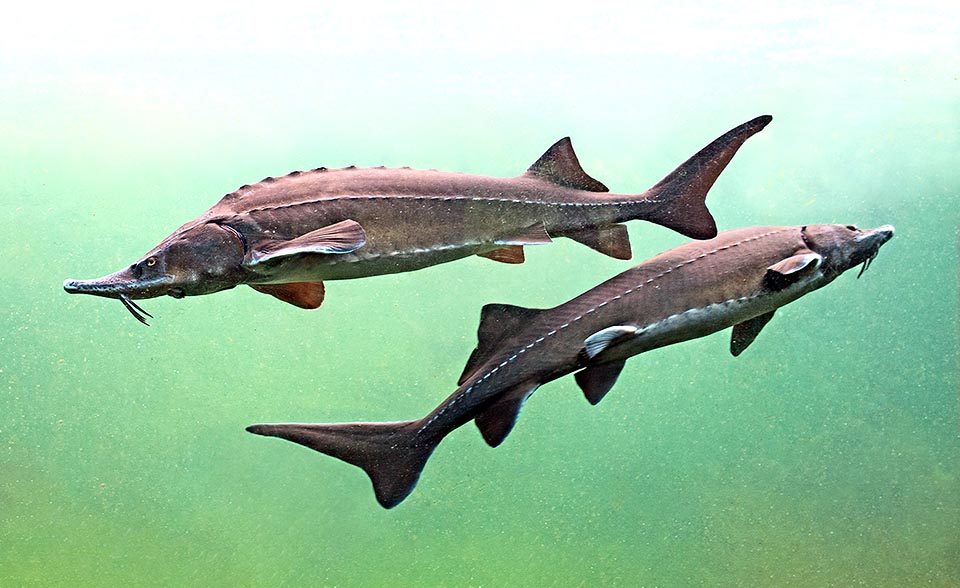
The annual number of eggs laid varies greatly depending on the species. There are selachians counting just two, the sturgeons, like this Acipenser baerii reach 6 million and Mova molva is the most prolific with 20-60 million. Most marine fishes entrust the eggs to the currents, whilst in the freshwater forms they usually fall on the bottom © Giuseppe Mazza
Generally in most marine fishes the laid eggs are planktonic, otherwise in the freshwater forms the eggs fall to the bottom.
Usually in the oviparous species the parents abandon the eggs and are completely disinterested in their own descendants, but are known some species that show parental care in varying degrees.
Some freshwater fishes build up nests, like the female of the Three-spined stickleback (Gasterosteus aculeatus Linnaeus, 1758) that lays its own eggs inside in a real and proper globular nest the male builds utilizing vegetable fibres and pebbles held together by a sticky substance produced by the kidneys; the male has the task to protect the eggs and consequently the progeny.
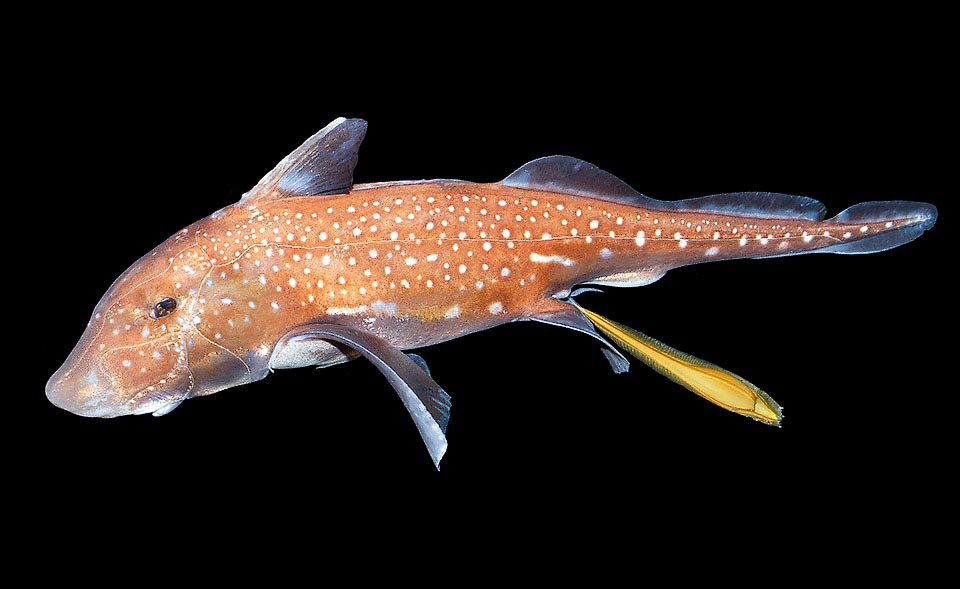
Some selachians give birth to autonomous sons, others lay eggs protected by a horny case. In the case of Spotted ratfish (Hydrolagus colliei) the ovaric cases that contain the embryo get out stuck to a long filament and hang down from the swimming mother for about 4-6 days before detaching and sticking vertically in the sandy bottom © Giuseppe Mazza
The trout and salmon females usually lay the eggs in small depressions of the bottom and then cover them with gravel or sand.
It is cerainly very singular the case of the Nurseryfish (Kurtus gulliveri Castelnau, 1878), Perciformes diffused in the brackish fresh waters of New Guinea and north-eastern Australia, where it happens that during the sexual maturity the males develop on their head a sort of red hook where the females fix a sort of cord, formed by adhesive filaments of the eggs themselves, carrying on each extremity a packet of eggs.
Particularly curious is also the behaviour of the Splash tetra (Copella (or Copeina) arnoldi Regan, 1912), species native to the South American water streams and very sought for by the lovers of fish keeping.
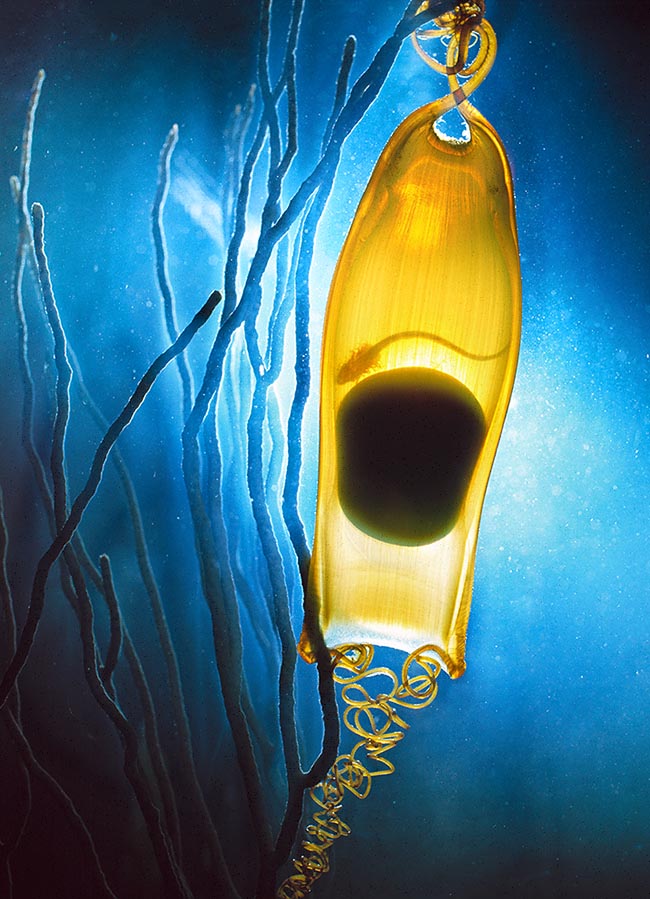
Egg of Nursehound (Scyliorhinus stellaris) transparently illuminated to highlight the embryo © Giuseppe Mazza
The common name with which this animal is known originates from the fact that the females after matings make leaps out of the water in order to stick their eggs on overhanging plants on the water surface.
The males in turn from time to time sprinkle the eggs, jumping and forcibly beating the tail on the surface of the water in order not to dry them.
And yet, the females of Rhodeus, small Cipriniformes widely spread in the water streams rich in vegetation and slow-flowing of Europe and Asia, introduce the fecundated eggs in the branchial chambers of freshwater bivalve mollusks (genera Unio and Anodonta) by means of a long ovipositor formed by the everted oviduct.
On the other hand, the females of the Hippocampuses and of the Pipefishes (Syngnatiformes) lay their own eggs in particular incubator pouches the males have in the fore part of the abdomen.
The males of some African freshwater Siluriformes carry the fecundated eggs into their own mouth, where also the birth of the kids takes place; these remain in the paternal shelter for about two weeks, until they become completely autonomous.
The contrary is observed in some Perciformes (Tilapia, Haplochromis), where the eggs laid in groups are fecundated by the male and then immediately taken in the mouth by the female who provides to incubate them and to provide shelter to the newborns in its own buccal cavity.
Certain species who live in the fresh and stagnant of the tropical regions, like some Fighting fishes, among which the well known Betta splendens (Regan, 1910), Perciformes of the Indochinese peninsula, build floating nests of foam where they spawn.
Incubation
Also the length of the incubation varies, as well as from species to species, also from season to season, from 3-4 days, ilke in the Acipenseriformes, up to even 5 months like in the Salmonidae, and even 8 month, like in the Elasmobranchia of the genus Scyliorhinus. Just hatched from the egg, the newbons of the Seahorses of the order of the Syngnathiformes and of the viviparous forms are perfectly developed and look like their parents.
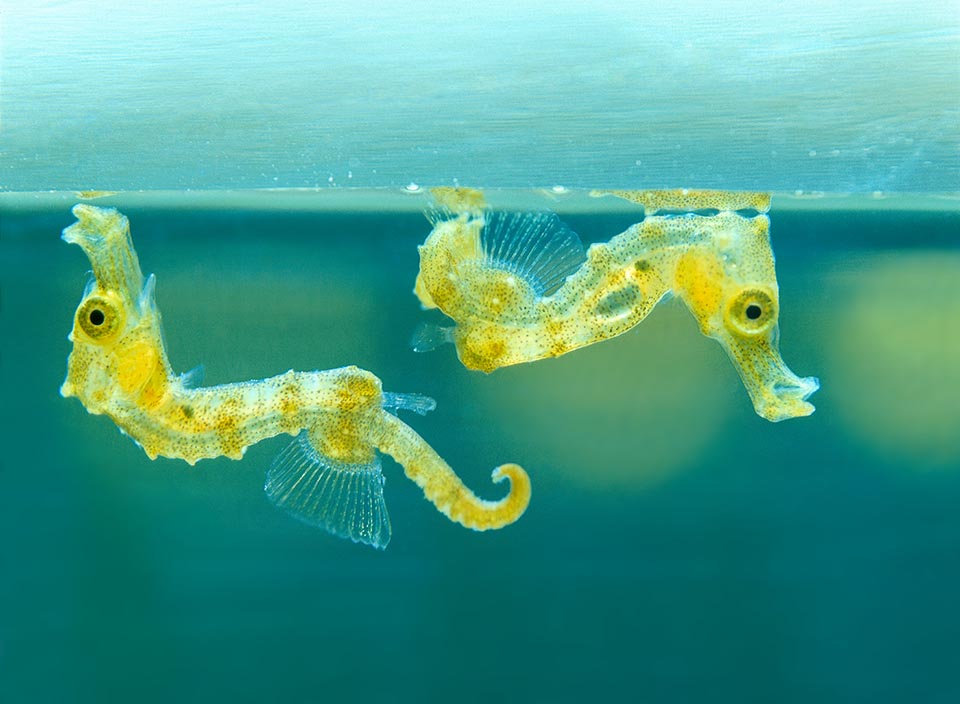
From the egg are born kids with larval look that then get gradually the looks of the adults, but in seahorse, newborns are already similar to their parents © Giuseppe Mazza
Unlike other species, from the egg are born young with larval aspects that then gradually get the appearance of the adults. It is to be kept in mind that a real metamorphosis does not happen in any case as, even in the cases where the newborns are very different from the adults, like the leptocephali of the eels and the larvae of the Pleuronectiformes, during the development we note all intermediate forms.
Also the life expectancies of these animals are quite variable; some species live only one year and die immediately after the reproduction, as occurs for the tiny icefishes of the genus Salanx (G. Cuvier, 1818), whilst others may survive up to the age of 80 years, like Carps (Cyprinus carpio Linnaeus, 1758), Wels catfish Silurus glanis, Linnaeus 1758), Northern pike (Esox lucius Linnaeus, 1758).
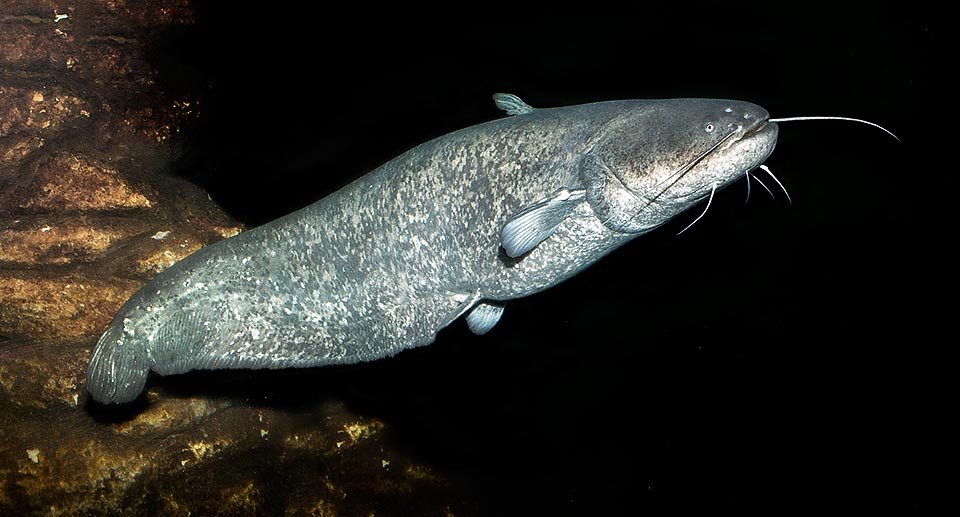
The life expectancies are quite variable. Some species live just one year and die just after reproducing, others, like the Silurus glanis, live even 80 years © Giuseppe Mazza
They talk about carps (Cyprinus carpio Linnaeus, 1758) lived up to 150 years and about a Northern pike (Esox lucius Linnaeus, 1758) who has reached the age of 267 years. In this regard it is to be remembered that the age of the fishes can be established with precision thanks to the examination of the scales or of the otoliths of the labyrinth of the inner ear that present zones of growth in a number corresponding to the passage of the years.
MIGRATIONS
In the fishes that of the migrations is a natural biological phenomenon very diffused and of various complexity that interests marine species as well as the freshwater ones, that often move from one area to another, often very distant, looking for environments with better availabilities of food (trophic migration), or presenting conditions more suitable from a reproductive point of view ensuring a high number of children (genetic migration).
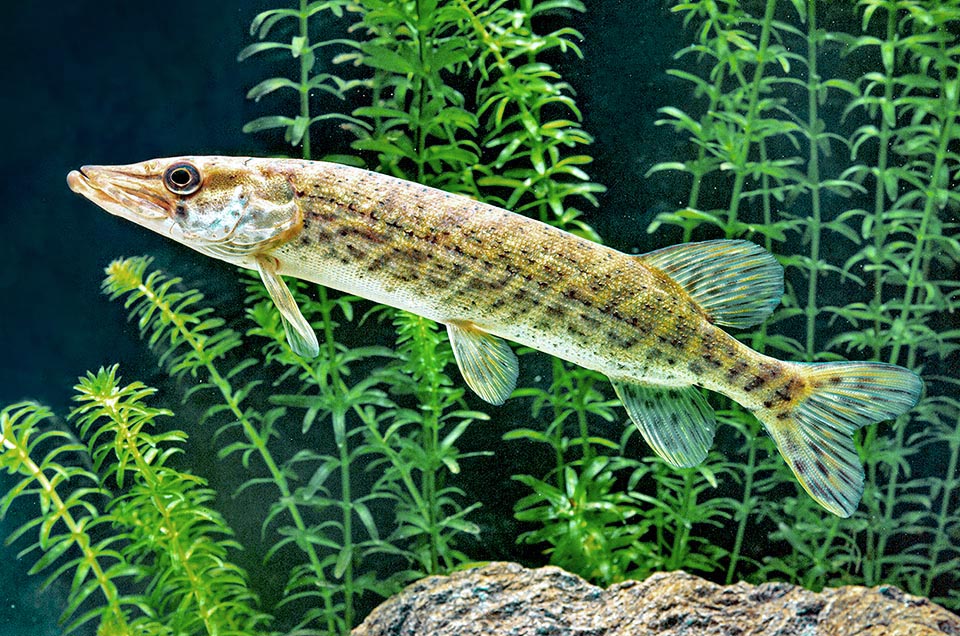
Also the Carp (Cyprinus carpio) and the Pike (Esox lucius) are equally long-lived and they talk of a Pike who should have reached the 267 years of life © Giuseppe Mazza
For several species the causes of the migrations are not yet known.
Moreover, in several instances, like in the Herrings and in the Sardines (Clupeidae), Mackerels and Tunas (Scombridae), the migrations determine the formation of huge schools of fishes that concentrate in precise areas.
Short distance movements, limited to a few hundred metres, are those of the so-called nictemeral migrations that consist in vertical daily transfers, in the day hours downward and in the night ones in ascent.
Not yet adequately studied, this phenomenon is linked to several factors, in particular to the different conditions of light and of the currents that determine the movements of the planktonic organisms that are carried by the currents.
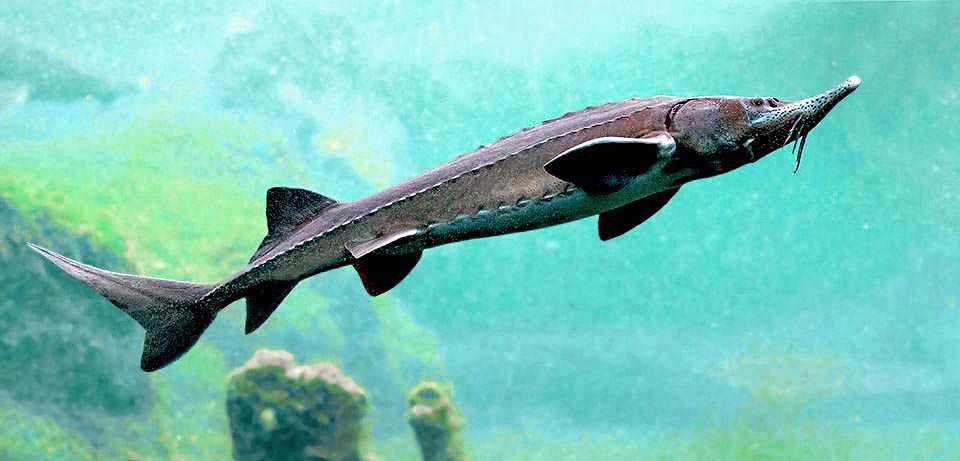
Some species make long migrations. Husi huso is an anadromous fish who from the sea oes up the currents of the rivers to reproduce in fresh water © Giuseppe Mazza
Among the many instances of fishes making nictemeral migrations is to be mentioned the well known European anchovy or Anchovy (Engraulis encrasicolus Linnaeus, 1758), of great economic importance. There are several species making real migrations between the marine waters and the internal waters for reproductive reasons (anadromous species). Usually, these fishes once the reproduction has occurred pass away without ever returning to the place of origin.
Among the anadromous fishes that from the sea go upstream in the rivers for reproducing in fresh waters, are to be mentioned the European sea sturgeon (Acipenser sturio Linnaeus, 1758), the Beluga sturgeon (Huso huso Linnaeus, 1758) and the Adriatic sturgeon (Acipenser naccarii Bonaparte, 1836); and, more, the Twait shad (Alosa fallax Lacepède, 1803), the Sea lamprey (Petromyzon marinus Linnaeus, 1758) and the European river lamprey (Lampetra fluviatilis Linnaeus 1758).
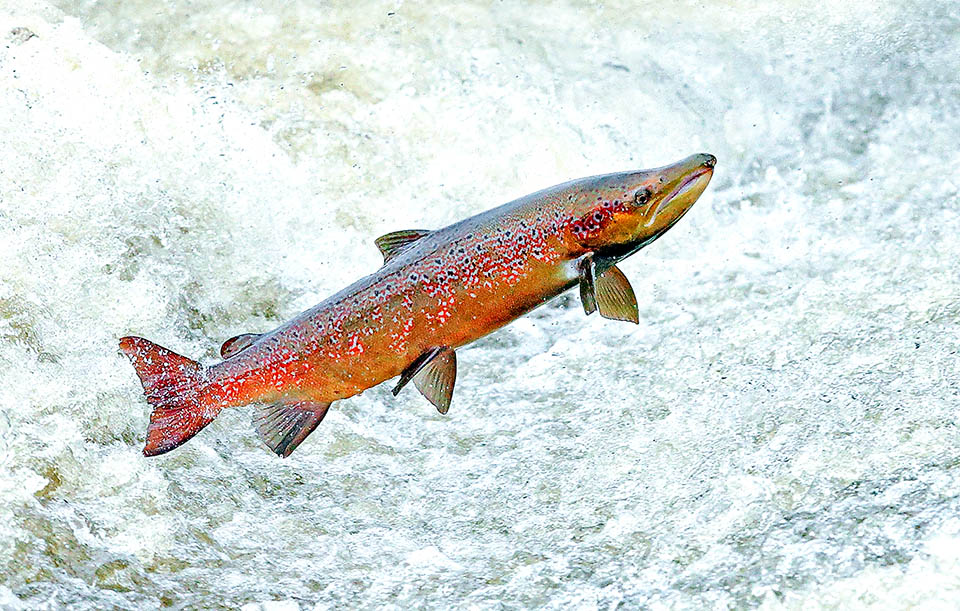
Also the Atlantic salmon (Salmo salar) is an anadromous species that reaches at sea the sexual maturity and then for reproducing goes up the impetuous native streams © Sean Browne
Some anadromous fishes, like salmons and sturgeons, lay the eggs in fresh waters but realize their development almost entirely in the sea (anadromous species).
Equally numerous are the catadromous fishes that, instead, descend the currents of the rivers for reproducing on marine waters. The most important examples of migratory fishes, also from the economic point of view, are undoubtedly those furnished by the Eel, the Salmon and by the Tuna of whom here below we give some essential indications.
The European eel (Anguilla anguilla Linnaeus, 1758) stands by sure among the most known and fascinating migratory fishes, even if many details of its biology are still to be discovered.
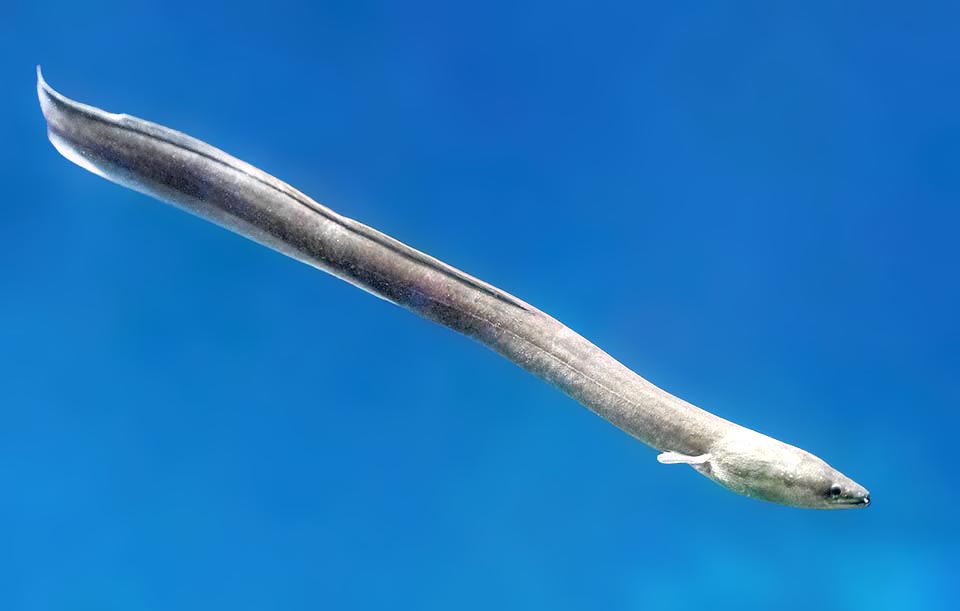
The Eel (Anguilla anguilla) conversely belongs to the catadromous fishes that abandon the rivers to reproduce in saltwater, for this one the Sargasso Sea © Giuseppe Mazza
Bony fish diffused in the fresh, brackish and marine waters of the Atlantic Ocean, of the Mediterranean and of the Black Sea, for most of its biological cycle, the Eel lives in fresh waters and only when the maturity is reached it moves towards the open seas to undertake a long migration towards the far away Sargasso Sea in the Atlantic Ocean, in the area included between the Antilles and the Açores where it reproduces (catadromous species).
That of the eels is a tiring journey lasting about six months and even without return as after having reproduced they pass away due to the long fast.
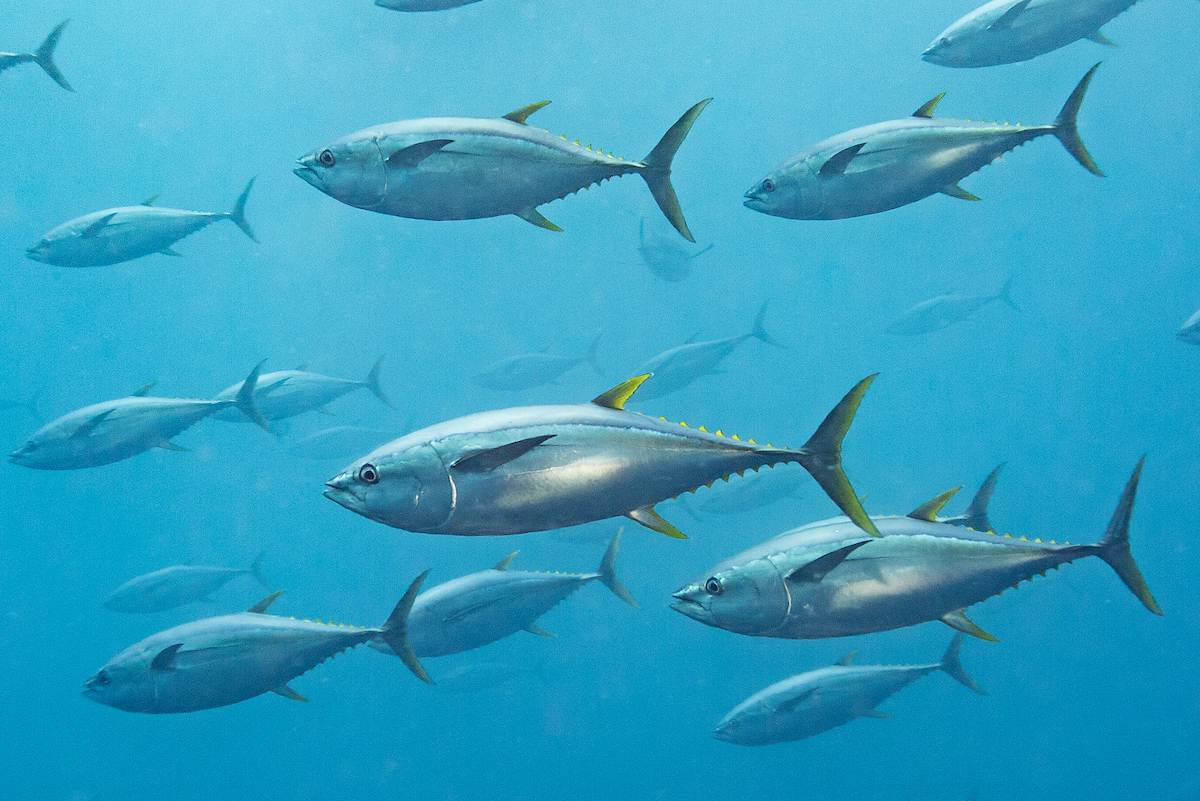
The Yellowfin tuna (Thunnus albacares) and the Bluefin tuna (Thunnus thynnus) though not leaving the sea, are species highly migratory © Allison & Carlos Estape
From the fecundated eggs larviform fry are born with a very small head and only one eye, hence the name of leptocephalus and body considerably flattened laterally, shaped like a willow leaf. The leptocephali, carried by the North Atlantic oceanic currents, begin their return journey towards the seas from where their parents had left.
During this migration they gradually undergo various modifications and when after about three years they at least reach their destination they have reached the so-called status named of caeca or blind.
Then the caecas move to the mouths of the rivers where they transform in anguillina and go upstream the river moving decisively from the sea to the fresh water.
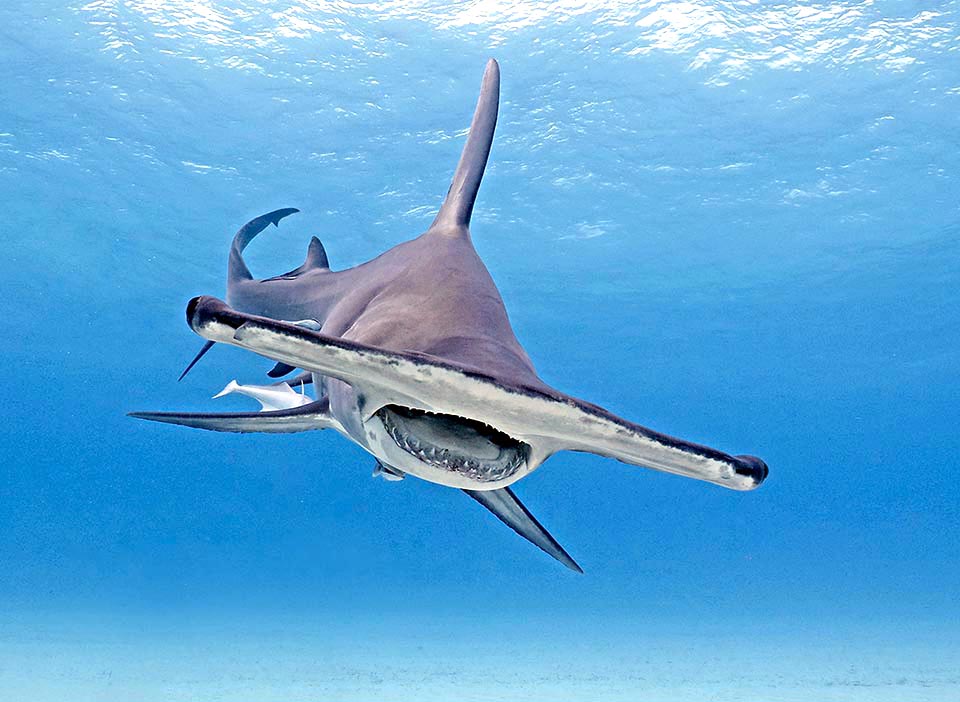
It is hypothesized that the fishes orient through astronomical references and the influence of magnetic fields and among the most equipped stand the Hammerhead fishes © Michael Eisenbart
Here they complete their growth and gradually get pigmented until sexual maturity is reached. Then, in their turn, they begin again a new migratory cycle.
Indeed, based on research made on the leptocephali of which so far has not been recorded any entry in the strait of Gibraltar, it is hypothesized the the zones of reproduction of this fish are more than one. In particular it is deemed possible that the eels of the countries facing the Mediterranean do not migrate in the Atlantic Ocean but reproduce in some zone, unknown so far, of the Mediterranean, probably in some depth of the Tyrrhenian Sea.
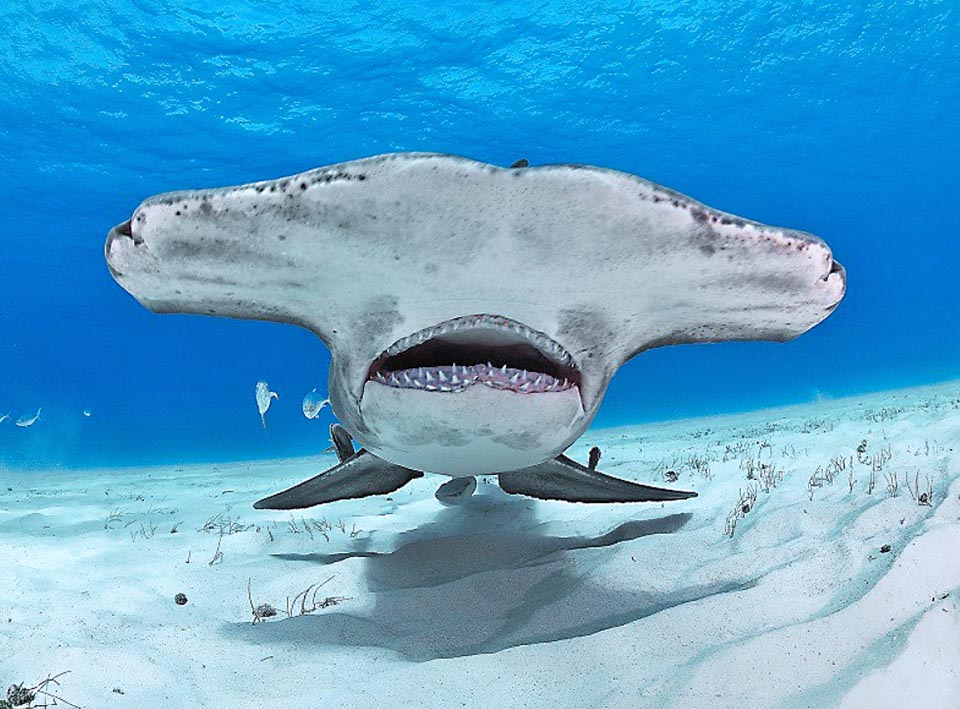
The head expanded to the sides, rich of Ampullae of Lorenzini, is like a radar that detects preys buried by the sand and shows the way to reach the memorized sites © Richard Merritt
It happens differently for the Atlantic salmon (Salmo salar Linnaeus,1758), a bony fish diffused in streams and bodies of fresh water and in the temperate and cool seas of the North Atlantic. Absent in the Mediterranean basin, the Atlantic salmon has been introduced in South America, Australia and in New Zealand.
This fish is born in fresh water and within the first two years of age moves to marine waters where it completes its own development and from where starts its migratory journey in North Atlantic, up to the coasts of Greenland where it finds abundant food.
After 2-3 years, when the livery of the males gets a lively colouration, the salmons resume the reverse routes to go back to the same fresh waters from where they had left (anadromous species).
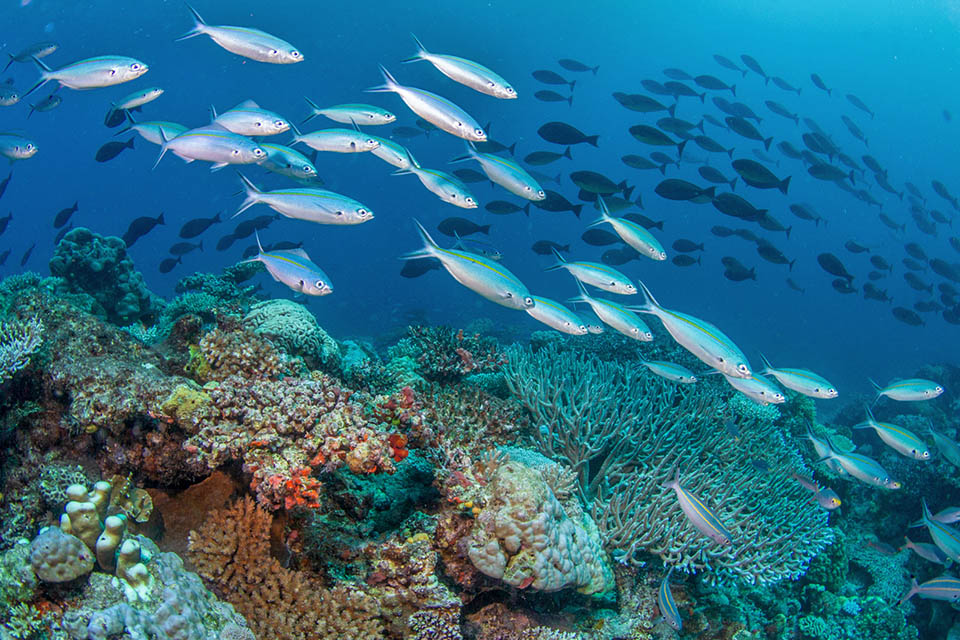
Many schools, like Caesio caerulaurea, nourish of zooplankton © Mark Rosenstein
Here, the females dig a sort of nest in the stream bed and deposit there the eggs that are inseminated by the male. With the hatching that occurs after about one month, will begin a new cycle.
The Tuna (Thunnus thynnus Linnaeus, 1758), known also as Bluefin tuna or Red tuna is a big bony fish of the order of the Perciformes. Of pelagic habits, this species is diffused in the North Atlantic Ocean, where it spends a good part of its life passing from one side to the other, and in the Mediterranean where goes for reproducing; in the recent past it was found lso in the Black Sea, from where nowadays has disappeared.

Also the multicoloured Anemone fishes are eaters of plankton, like Amphiprion nigripes, and the Whale shark (Rhincodon typus) © Giuseppe Mazza
In spring, reached the sexual maturity, specimens of this species gather in large schools and leave the Atlantic to migrate to the Mediterranean Sea looking for the reproduction area (going forward tunas). During this long journey the tunas do not eat and swim, tireless, along a migratory route that usually passes by the same places and in the same periods and that crosses the Balearic Islands, passes south-west of Sardinia and reaches the channel of Sicily from where heads east, in some cases up to the coasts of Turkey.
With the arrival of autumn, the tunas go back to the Atlantic Ocean for feeding (return tunas).
The repetitiveness of the migratory route allows the fixed fishing installations that get the name of tonnaras.
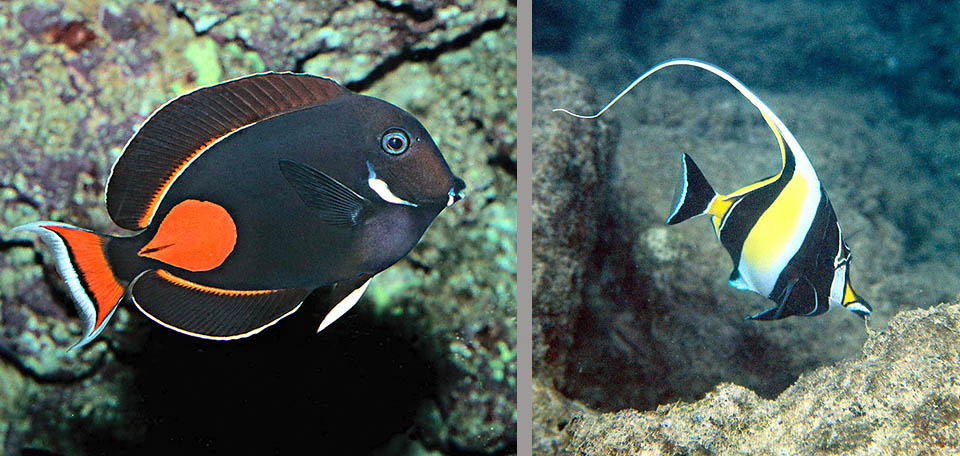
The surgeonfishes like Acanthurus achilles and the Zanclids like the Moorish idol (Zanclus cornutus) nourish almost exclusively of algae with some bites to the sponges © Giuseppe Mazza
For this species it has been hypothesized that not all tunas are migratory and that exist resident populations in the Mediterranean as well as in the Atlantic who, in winter, tend to descend.
Orientation
During the migratory journeys it is hypothesized that the fishes orient themselves with astronomical references and the influence of magnetic fields, as happens for the birds. Also the perceptive skills of chemical and olfactory cues contribute to the orientation of the fishes during the migratory phenomenon.
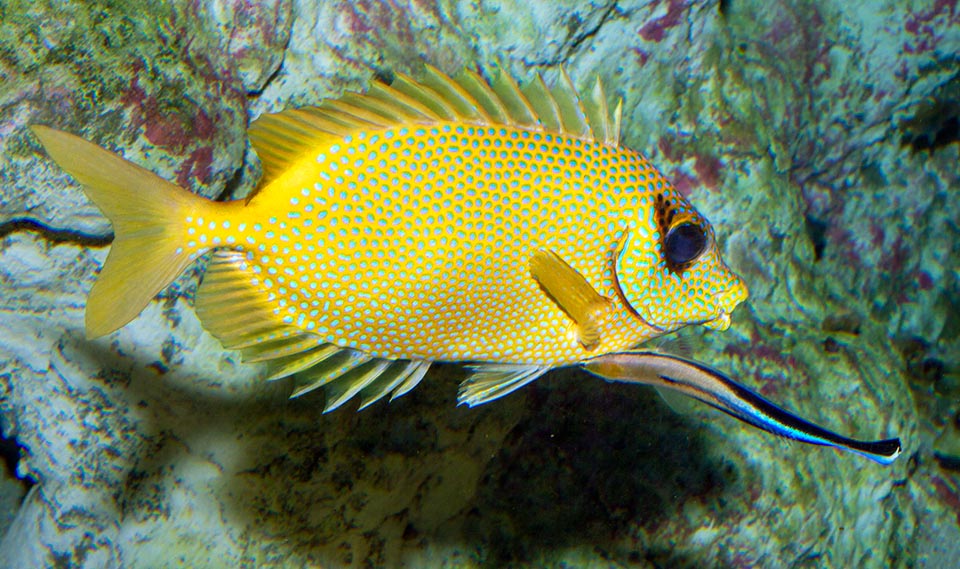
Also Siganus corallinus is herbivorous, whilst the Labroides dimidiatus close to it, feeds cleaning from parasites the skin and the gills of the fishes that appear usually wide open with spread fins. It also takes off food leftovers and the dead tissues, being greedy of the mucus secreted by the fishes, price paid for this service © Giuseppe Mazza
However, on the other hand, it is still unclear how occurs the recognition of the area good for the oviposition when this, as is the case of the anadromous, species, such as the salmon, is the same from which the young have left to reach the sea and realize most of their development.
Threats
The migratory fishes, as well as in general occurs to most migratory animals, are naturally exposed to numerous risks of various kinds, in particular the loss of orientation, greater chances to be preyed upon, deaths due to insufficient food resources.
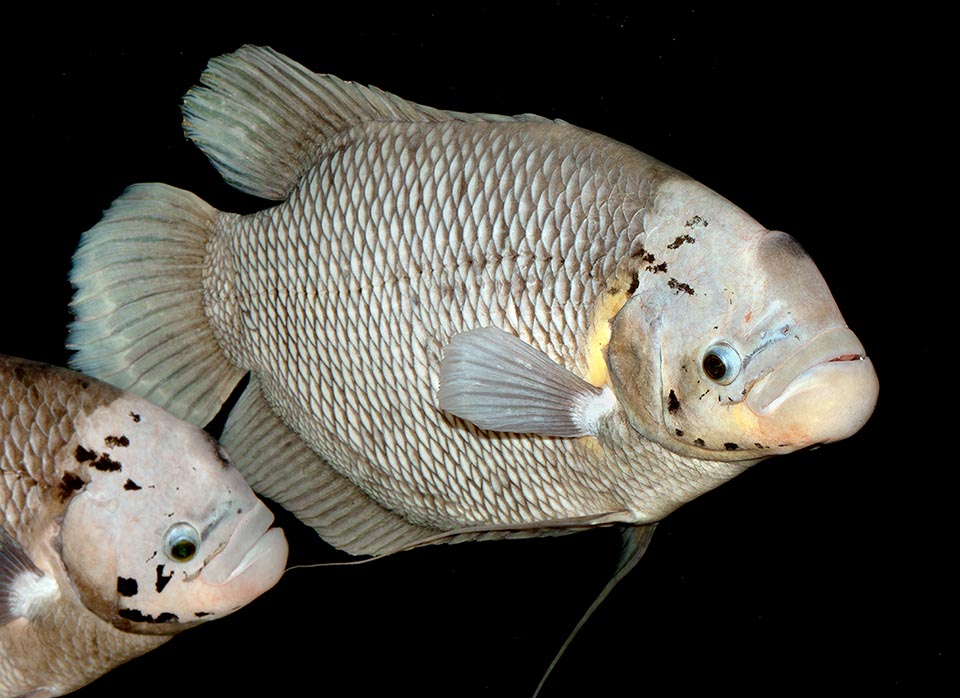
Giant gourami (Osphronemus goramy) is an onlicorous fish of the south-east Asian stagnant fresh waters. It feeds on vegetables, minnows, invertebrates and carrions © Giuseppe Mazza
These risks are greatly increased by improper human activities, like excessive fishing effort, increasing pollution of the waters, inaccessibility of their trophic environments or of reproduction resulting from the construction of dams and barrages that interrupt the ecological-functional continuity of the rivers and of the water streams, and others more.
The synergistic effect of these factors is the main cause of a general and progressive impoverishment of the populations of the migratory fishes, several of which stand in conditions considered as Critically Endangered.
DIET
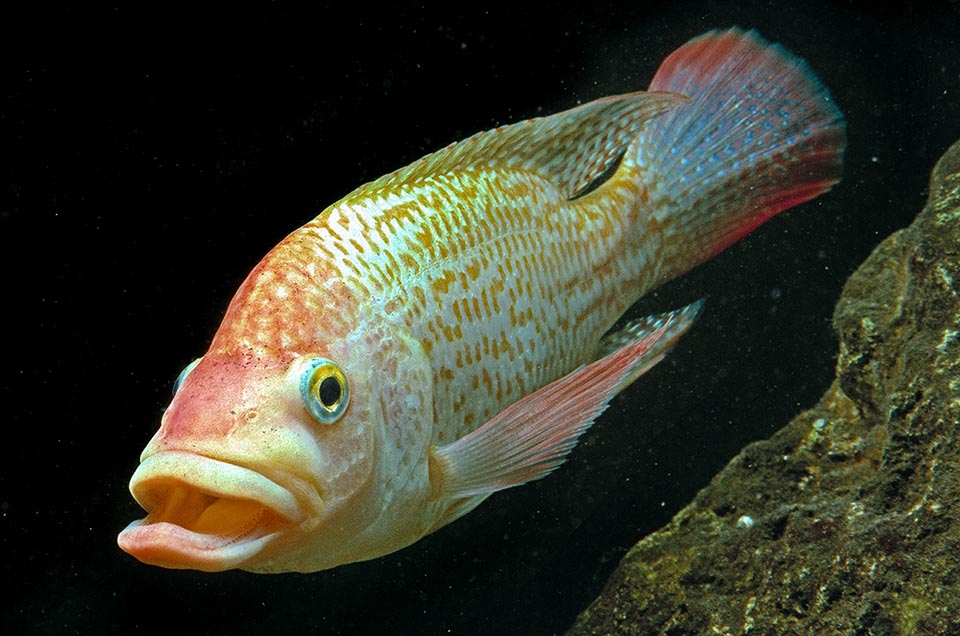
The Mozambique tilapia (Oreochromis mossambicus) has an analogous diet based on bottom debris rich in bacteria, algae, protozoa, small crustaceans and other © Giuseppe Mazza
The diet of the fishes is very varied. Several species nourish of vegetables, others are detritivorous and microphagous, others more are carnivorous. In particular situations, some species even resort to cannibalism eating specimens of their own species.
A good number of species npurish of debris, in particular of the decaying organic matter falling on the bottom. Mullets, some Gobiids and Blenniids of the tidal zone or tidal flats find a good part of their food grazing with the snout on the bottom and swallowing the debris usually rich in bacteria, algae, protozoa, small crustaceans, and other.
Vegetables are of great importance in the diet of the fresh water fishes, in particular the tropical ones.
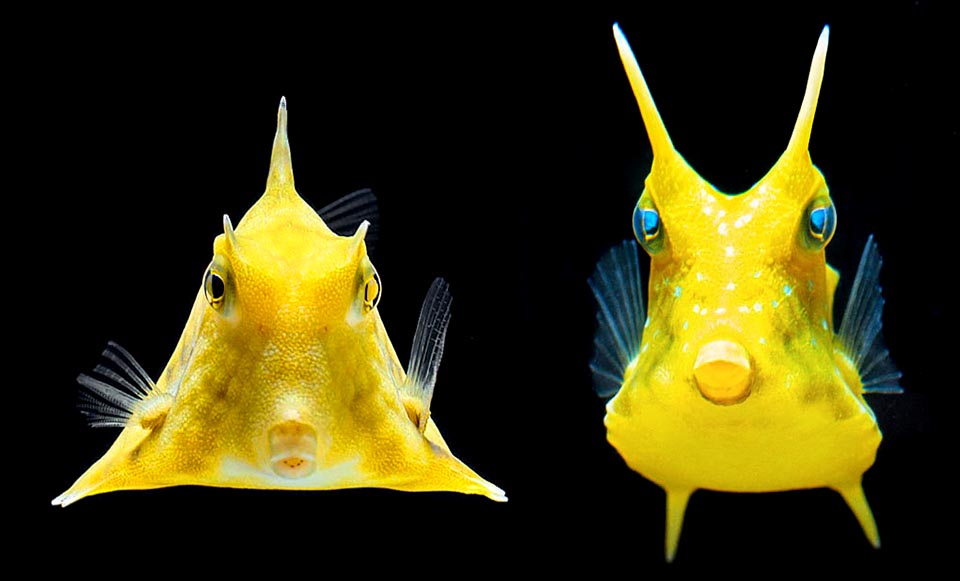
At sea the boxfishes like Tetrosomus gibbosus and Lactoria cornuta, protected by ke and a very poisonous skin, nourish of small benthic invertebrates © Giuseppe Mazza
Among the many freshwater species strictly linked to a vegetable diet and to the microorganisms are to be mentioned the Mekong giant catfish (Pangasiodon gigas Chevey, 1931) of the family Pangasiidae (Siluriformes) and several Perciformes such as the Mozambique tilapia (Oreochromis mossambicus Peters, 1852), fish Cichlidae native to south-eastern Africa, and Trichogaster pectoralis (Regan, 1910), species of the family Osphronemidae coming from Mekong basin.
And also, the Catfishes of the Loricariidae among the Siluriformes are used to scrape the weeds from the rocks with their big protruding lips of the mouth typically sucker-like that occupies a ventral position.
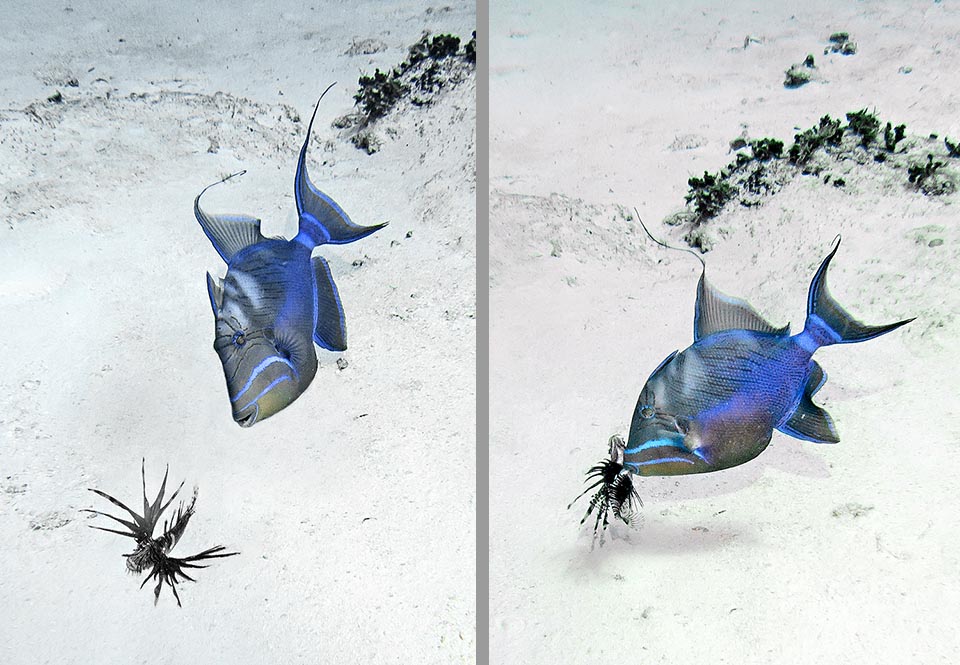
Balistes vetula. The triggerfishes have solid incisives for crushing shells and cuirasses of the preys or chase away the importunate approaching the nests with the eggs. They mainly eat mollusks, starfish and sea urchins they flush out and reverse with mighty jets of water from the mouth. Actually, also fishes like this poor Pterois © Al Dobbins
Otherwise, in the fresh waters of the temperate climates and in the marine ones, the herbivorous fishes are in the clear minority. Among these, a prominent place is occupied by the order of the Perciformes to which affer numerous species nourishing of vegetables, and that form the most importanrt guests of the coral reefs.
Among these, are to be mentioned the Butterflyfishes, species of Chaetodontidae diffused in the tropical seas of the Atlantic, Pacific and Indian oceans, so-called because characterized by a livery that in its colours recalls somewhat the wings of the butterflies, these fishes, long averagely from 10 to 30 cm of length, love the shallow waters and usually are part of the coral reef where some species usually feed on filamentous algae and of plankton.
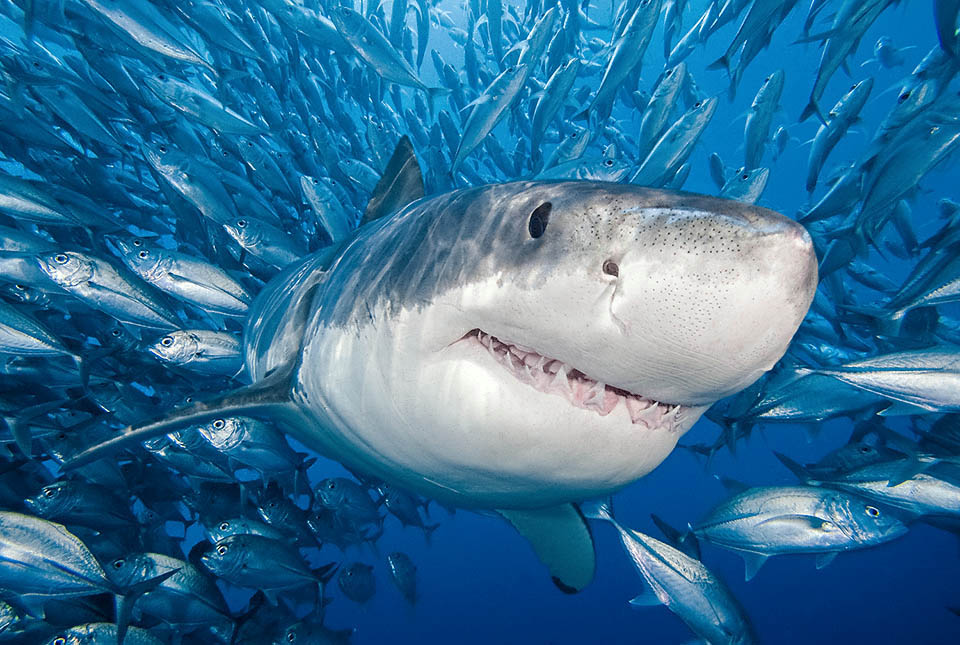
Large fish predators are of course the sharks, like this Carcharodon carcharias that bursts menacingly in a school of Caranx sexfasciatus © www.davidfleetham.com
The family unites more than 120 species mostly afferent to the genera Chaetodon (Linnaeus, 1758) and Heniochus (Cuvier, 1816).
And yet always among the Perciformes eating vegetables, are to be mentioned the Surgeonfishes of the Acanthuridae, family diffused in the tropical marine waters, that owe their common name to a particular defense weapon fomed by a pair of sharp razor blades resembling a scalpel, placed on each side of the caudal peduncle and that in presence of possible predators are raised mainly for demonstration purposes. To the Acanthuridae affer more than 80 species in a good part included in the genus Acanthurus (Forsskål, 1775) Characterized by a herbivorous diet are also the Rabbitfishes (Siganus Forsskål,1775), Perciformes diffused in the Indian and Pacific oceans and recentlyb arrived in the Mediterranean through the Suez Canal (Siganus luridus Rüppell 1828 and Siganus rivulatus Rüppell 1828).
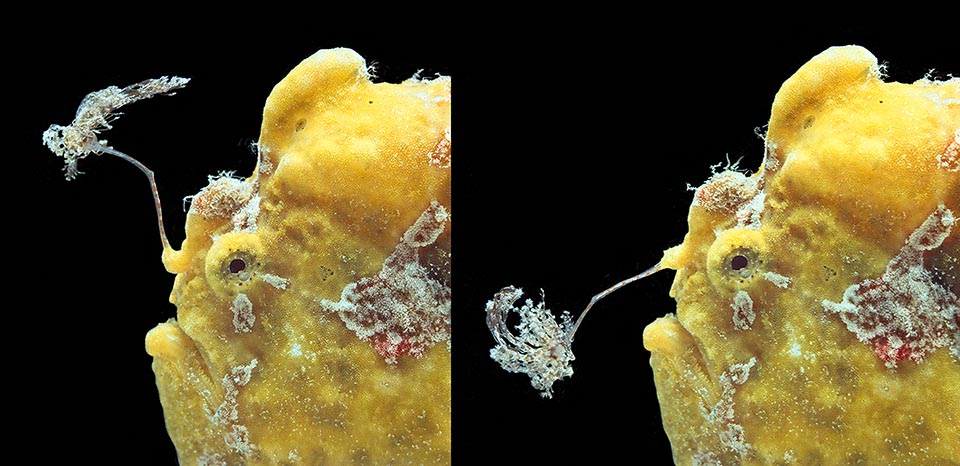
Many are fishes preying with tricks. Antennarius pictus looks like a rock but when a small fish gets closer it waves a small fishing line, the illicium, and swallows the curious © Giuseppe Mazza
Always among the Perciformes, eat vegetables also the Damselfishes or castagnole (Pomacentridae), fishes characterized by the presence of a spine on the gill operculum and diffused in the tropical and subtropical seas, up to the temperate waters, with more than 300 species.
Most fishes are carnivorous and eats animal organisms of variable size, from the smallest preys, such a crustaceans, insects and various larvae, to those of large dimensions, like big crustaceans, cephalopod mollusks, amphibians, pinniped mammals, other fishes, etc.
Among the many species that mainly nourish of animals must be mentioned the Triggerfishes, Balistidae of the order Tetraodontiformes that, with just over fourty species, live mainly in the tropical and subtropical seas and so called because of the particular look of the fins similar to the bow of a crossbow.
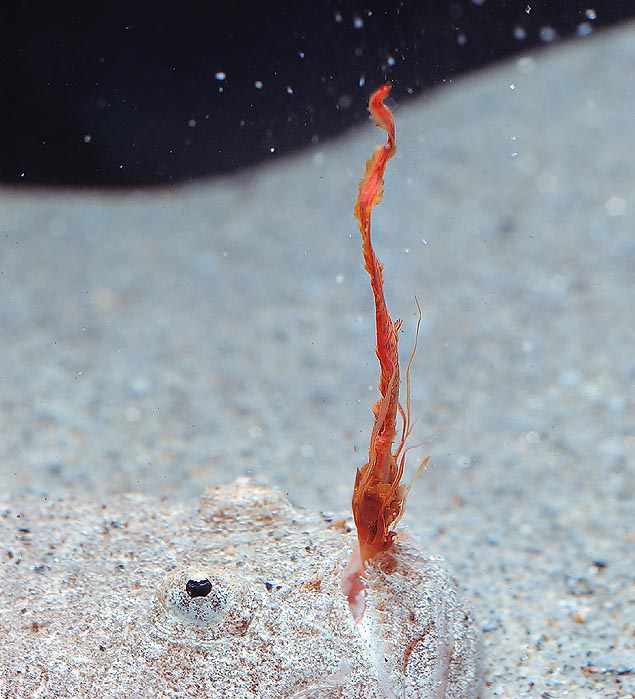
Similarly the Stargazer (Uranoscopus scaber) th seem to be looking innocently the sky buried in the sand, intrigues by waving the tongue similar to a small worm, and in a flash end the unfortunate end up in a stomach © Giuseppe Mazza
These fishes have also the characteristic of presenting a robust beak formed by the premaxillary and maxillary bones merged and armed with some teeth similar to scalpels and other teeth plate-like. This beak is particularly suitable for crushing shells of crustaceans and mollusks, skeletons of starfishes and sea urrchins, and of corals that together with fishes represent their food source. In the shallow coastal waters of the Mediterranean, the family is represented by the Pork fish or Gray triggerfish (Balistes capriscus Gmelin, 1789), particularly appreciated in cooking.
In the fresh waters live species belonging to various families such as Cyprinodontidae, Characidae, Cyprinidae and other more, that depend for a large part of their diet from aquatic larvae of insects, in particolar those of mosquitoes and chironomids, large family of dipterans.
Among the big predators we meet in the surface waters of open seas, the Elasmobranchia form one of the groups better represented.
In fact belong to them the White shark (Carcharodon carcharias Linnaeus, 1758), the Blue shark (Prionace glauca Linnaeus, 1758), the Portbeagle (Lamna nasus Bonaterre, 1788), the Thresher sharks (Alopias, Rafinesque, 1810), the Hammerhead shark (Sphyrna Rafinesque, 1810), and others more.
Some fishes are able to reist fasting for a long time, during which they conume the fats stored in the body and even the proteins; in this regard is to be kept in mind that, being heterothermic animals, they consume very little energy for the internal production of heat.
In addition to migrations done in the horizontal plane and that are very often linked to the reproductive activity, in several forms occur verical movements, daily or seasonal, in relationwith the variation of the thermal, photic, alimentary, etc. conditions.
Unlike one might believe, depending on the species teh fishes are able to produce sounds in various ways, by vibrating the walls of the swim bladder using special muscles or grinding the pharyngeal teeth, or rubbing the tail againsyt parts of the body, rather than expelling gas through the pneumatic duct.
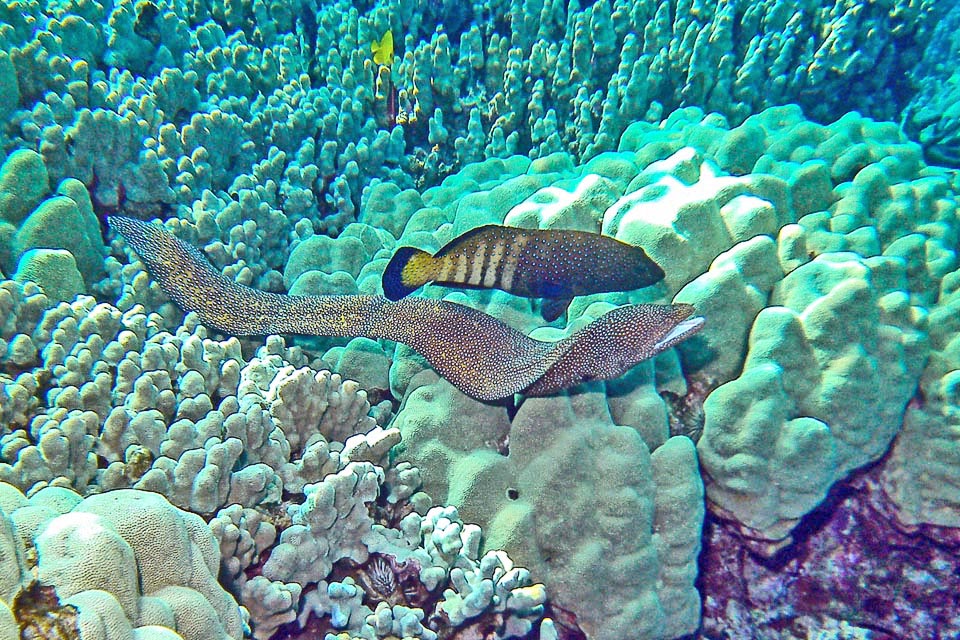
Peacock hind (Cephalopholis argus) keeps an eye on morays that go hunting using them as beaters. The fishes hidden among the corals run in terror and it swallows them © Barry Fackler
The sounds produced by the fishes may have the purpose of gathering the individuals of a same species for reproductive or alimentary purposes, or may represent a real manifestation of territoriality.
In many species the sounds are transmitted to the inner ear through the body, whilst in some species the organ of hearing is directly or indirectly connected through the ossicles of Weber (Ostariophyseal), to the swim bladder whose walls are made to vibrate by the underwater sound waves.
CLASSIFICATION
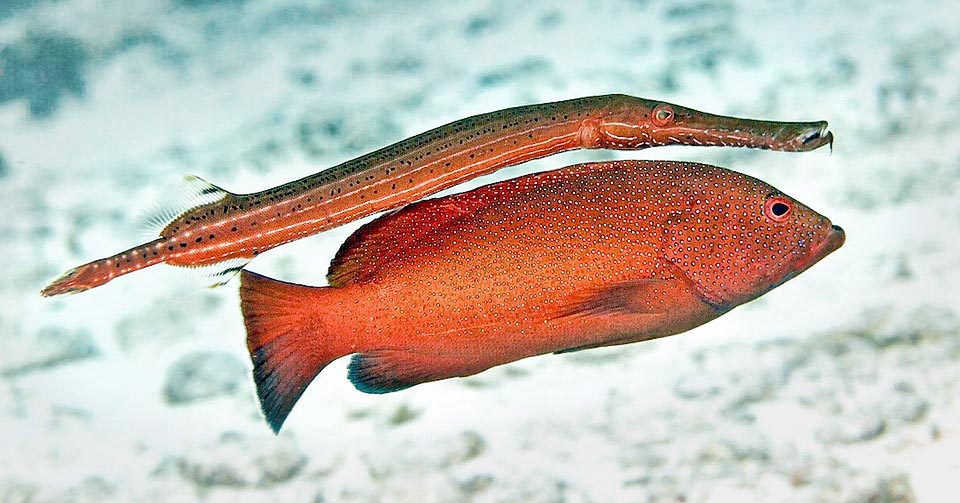
Here the deals reverse and it’s the Caribbean Trumpetfish (Aulostomus maculatus) thatuses a grouper as beater © Allison & Carlos Estape
Spread throughout the seas, from the warm equatorial to cold arctic ones, from the surface to depth exceeding even 9.000 m, in the brackish waters ans in the fresh ones, traditionally the Fishes are considered as a group of veretbrate animals, to whom, in the past, was give the value of superclass and in which presently are included the so-called cartilaginous fishes (Condrichthyes) and the bony ones (Osteichthyes).
Actually, such subdivision nowadays appear obsolete as, on the base of considerations of phylogenetic character, Condrichthyes and Osteichthyes do not form a monophyletic group as they are not originated by a common anvcestor.
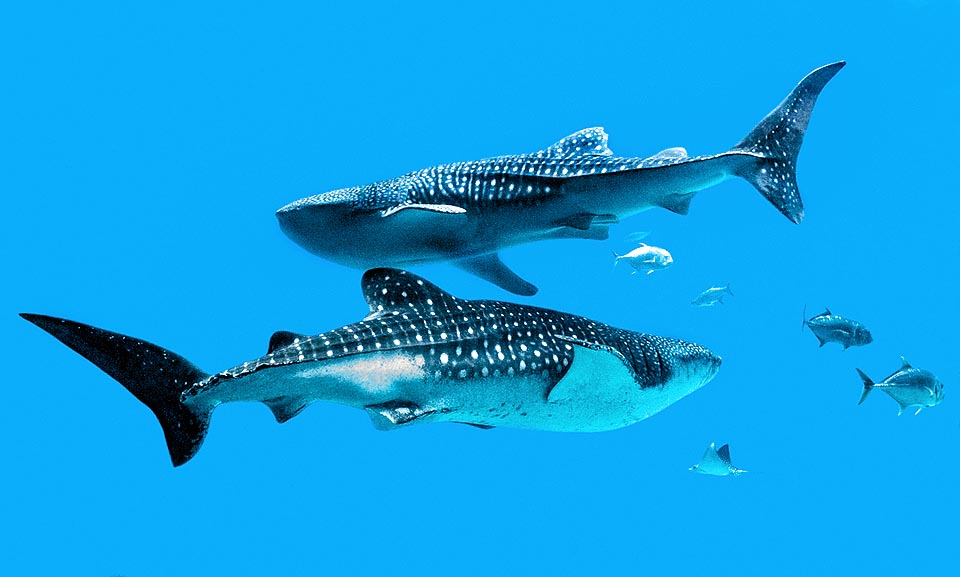
Whale shark (Rhincodon typus) is the giant in the world of the sharks, placed with rays and chimeras among the cartilaginous fishes known traditionally as Chondrichthyes © Giuseppe Mazza
Moreover, within the cartilaginous fishes, as well as also in the bony ones, has been evidenced the presence of different clades, that is of groups that separated in different times and to each of them is recognized the rank of class.
In consideration of this, presently Condrichthyes and Osteichthyes, alongwith Amphibia, Reptilia, Aves and
Mammalia, are united in the Gnathostomata, deemed infraphylum of vertebrate animals that characterizes mainly due to the presence of a mouth equipped with mandibles, that has evolved in the late Silurian (430-380 years agp) starting from aqutic progenitors having no mandilbles and jaws, the Agnatha.
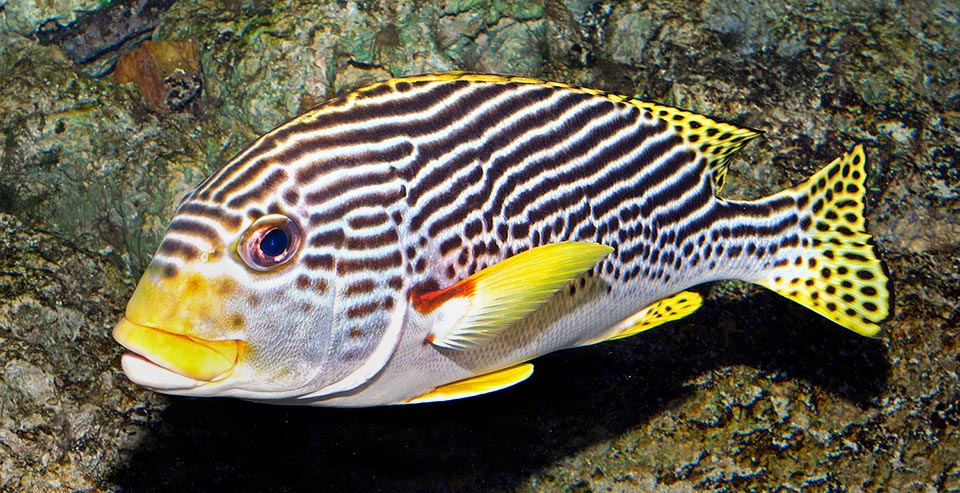
The bony fishes, like this Olectorhinchus lineatus, are instead called Osteichthyes © Giuseppe Mazza
Considered in the past a superclass of Vertebrates with the name of Cyclostomata, referring to the circular shape of the buccal opening, nowadays there is the tendency to consider the Agnatha a paraphyletic group having no systematic value.
They are aquatic vertebrates with long body, anguilliform or vermiform, without even limbs and with completely bare skin. The mouth, typically without mandibles and jaws, henece the name of the group, is shaped like a sucker with a circular or elongated lip and is equipped with horny teeth arranged in series. These extreely ancient animals have dorsally on the fore part of the head only one nostril placed dorsally and 5 to 15 gills sack-shaped. The sexes are separate.
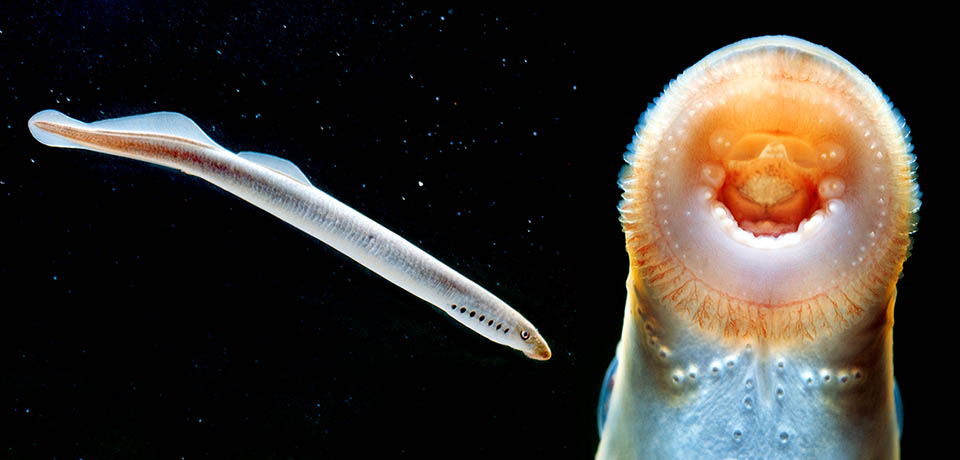
Condrichthyes and Osteichthyes, with Amphibia, Reptilia, Aves and Mammalia, are now united in the Gnathostomata, infraphylum of vertebrates having the mouth provided with mandible that has evolved in late Silurian from aquatic progenitors having no mandible and jaws, like the present species of genus Lampetra inserted in the Agnatha © Giuseppe Mazza
Under the name of Agnatha, are however grouped few species diffused in the marine and brackish temperate and cold waters and divided in the orders of the Myxiniformes (Myxine glutinosa Linnaeus, 1758) and of the Petromyzontiformes, with the European river lamprey (Lampetra fluviatilis Linnaeus, 1758) and the Sea lamprey (Petromyzon marinus Linnaeus, 1758).
The Gnathostomata form therefore a phylogenetic group to which are altogether presently ascribed more than 50 thousand species, between Chondrichthyes with more than one thousand species, Osteichthyes, with about 20 thousand, Amphibia with about 9 thousand, Reptilia, with almost 7 thousand, Aves with about 10 thousand and Mammalia with almost 6 thousand.
→ For general information about CARTILAGINOUS FISH please click here.
→ For general information about BONY FISH please click here
→ To appreciate the BIODIVERSITY of CARTILAGINOUS FISH please click here.
→ To appreciate the BIODIVERSITY of BONY FISH please click here.
